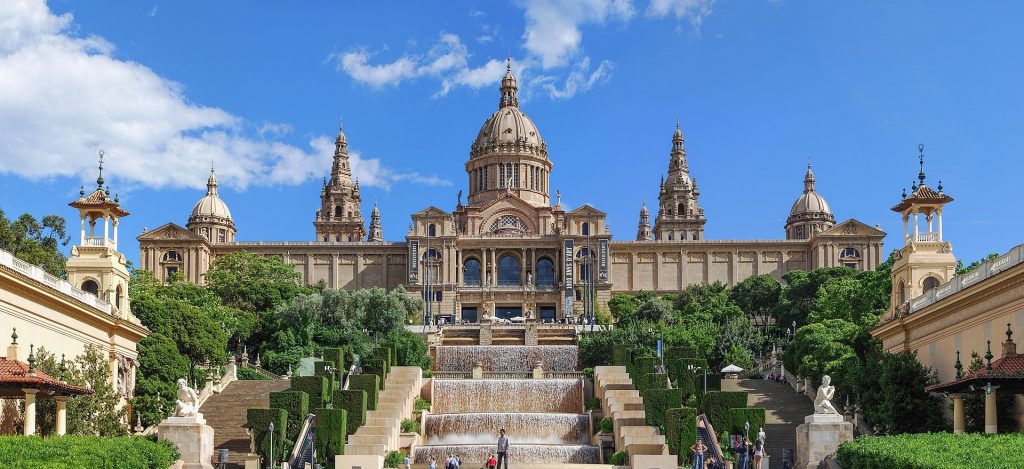
The call major, which was active between the twelfth century and the riots of 1391, is Spain’s best-preserved Jewish quarter and the easiest to visit. It comprises a small zone between the Palau de la Generalitat and the calles Banys Nous, Sant Domenec del Call, Sant Honorat, Arc de Sant Ramon del Call, Sant Sever, la Fruita, Marlet, and del Call. The synagogue was at 7 Calle de Sant Domenec del Call, next to the houses of the rabbis Nissim Gerundi and Isaac bar Seset Perfet.
At number 1 on Marlet Street, you will discover a 13th-century Hebrew inscription whose original was discovered in 1820 and preserved in the City’s Historical Museum, reminiscent of a pious foundation in tribute to Rabbi Samuel ha-Sardi. The stone states “Pia Foundation of Samuel ha-Sardi; its light shines for eternity “

The call menor, created in 1257, is located outside the walls, along the present carrer Ferran. On the site of the synagogue, the church of St. Jaume was built in 1595. This district underwent profound changes in the nineteenth century, and there remains today no trace of a Jewish past. The cemetery is listed since 1091 on the hill of Montjuic, a name whose origin isn’t known (perhaps “the Mount of the Jews”). On its site stands today the Olympic Stadium. In 1945, excavations made it possible to find some thirty tombstones, exhibited at the Military Museum installed in the old castle, as well as four rings and earrings on display at the City’s Historical Museum. It is also known that Jewish winemakers produced kosher wine at this location.
Records of the cemetery of Montjuic, a name of uncertain origin (possibly “Jews’ Mountain”) go back to 1091. Today, the site is occupied by the Olympic stadium. In 1945, excavation brought to light some thirty headstones, now exhibited in the Military Museum (Museo Militar) housed in the old castle, as well as four rings and earrings that can be seen in the city’s Historical Museum.
You will find fragments of Hebrew inscriptions on the houses of Carrer Montcada and Condes de Barcelona. On the Plaça del Rei, where the first autodafé of the Inquisition took place in 1488, stands the Palau Reial Major: it was in one of its rooms that the famous controversy between Nahmanide and Pau Cristiani took place in 1263 , in the presence of King Jaume I. On the other side of the square, the archives of the Crown of Aragon preserve a precious and vast documentation on the history of the life of the Catalan Jews; there are also the remains of a tombstone of Montjuic.
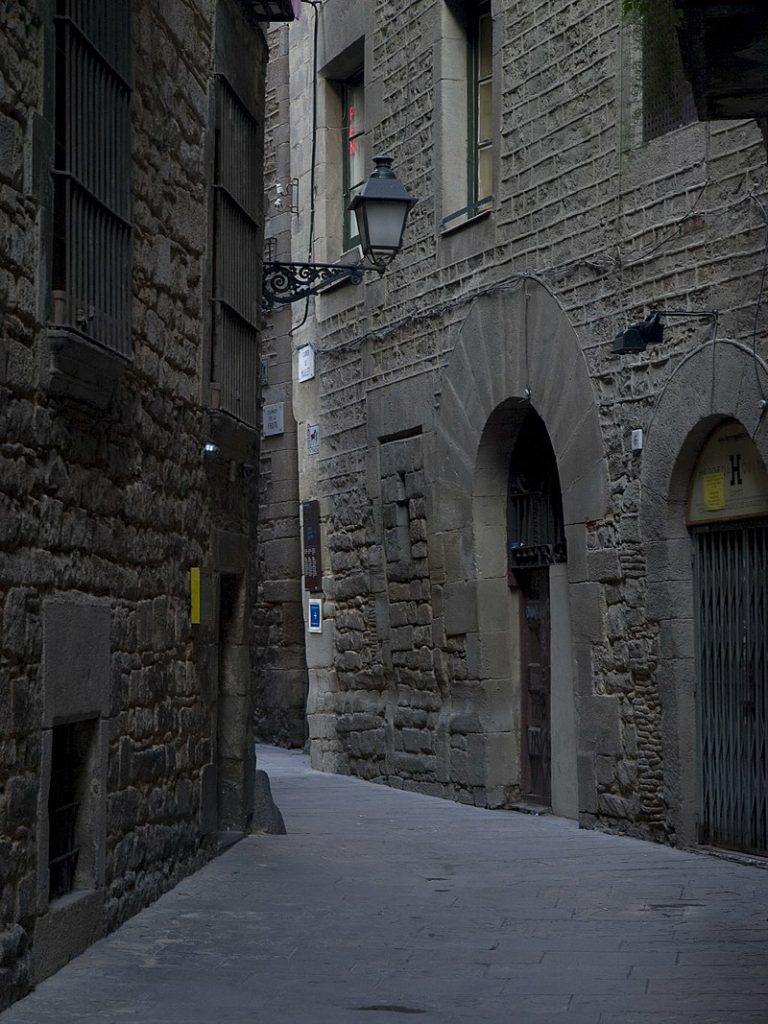
The old synagogue, or major synagogue of Barcelona is in the old medieval Jewish quarter. The building dates from the 6th century and is to date the oldest synagogue found in Spain. The building’s foundations date back to Roman times, and you can see remnants of this past on the interior walls of the synagogue. After the sacking of the Jewish quarter on August 5, 1391, the building passed into the hands of the king, and, little by little, its original function and location were forgotten. It was not until 1996 that the historian Jaume Riera i Sans located exactly the building of the old synagogue.
The association Call de Barcelona has recovered the building and proceeded to its renovation. In 2002, the major synagogue reopened in the form of a cultural center and museum. To access it, you have to go down stairs about 2 meters below the current level of the street. The building strikes by its modest dimensions: about 60 m2, which agrees with the restrictions on non-Catholic places of worship of the time. Note that the association offers various complementary activities to visit the major synagogue, such as walks in the Call Jueu, the medieval Jewish district of Barcelona.
The city of Barcelona has suffered an upsurge in anti-Semitic attacks since the pogrom in Israel on 7 October 2023.
The presence of Jews in Besalú is attested in a document from 1229 in which Jaume I the Conqueror reserves to them the function of moneylender. In 1342, the community, hitherto linked to the one in Barcelona, became independent. In those days it numbered 200, a quarter of the total population, and lived side by side with the Christians. We have no information about 1391 and the pogroms. Not until the bull issued by the antipope Benedict XIII was a call created around the synagogue and the Plaça Mayor (Portal Belloch, Capellada, Carrer del Pont, Carrer del Forni i Rocafort). In 1435, the Jews abandoned Besalú for Granollers and Castelló d’Empúries.

A mikvah was discovered in 1964 on the site of an old dye manufacture. Since 1977, development and restoration works have made it accessible to visitors. It dates probably from the thirteenth century and is the only Romanesque mikvah in Spain. Thirty-six steps lead down to a small rectangular room in the basement. In keeping with tradition, the bath has a fine vault overhead and is lit by a window in the eastern wall. This mikvah probably belonged to a synagogue that stood in the site of the garden on today’s Plaça dels Jueus (Jew’s Square). From here there is a fine view of the Fluvia River and its Roman bridge.
Gerona was the second most important community in Catalonia, both for its size (1000 men and women in the twelfth and thirteenth centuries, but only 100 or so in the fifteenth) and for the quality of its scholars. Gerona was the home of Nahmanides, Johan ben Abraham Gerondi, Azriel of Gerona, Bonastruc da Porta, and Isaac the Blind.
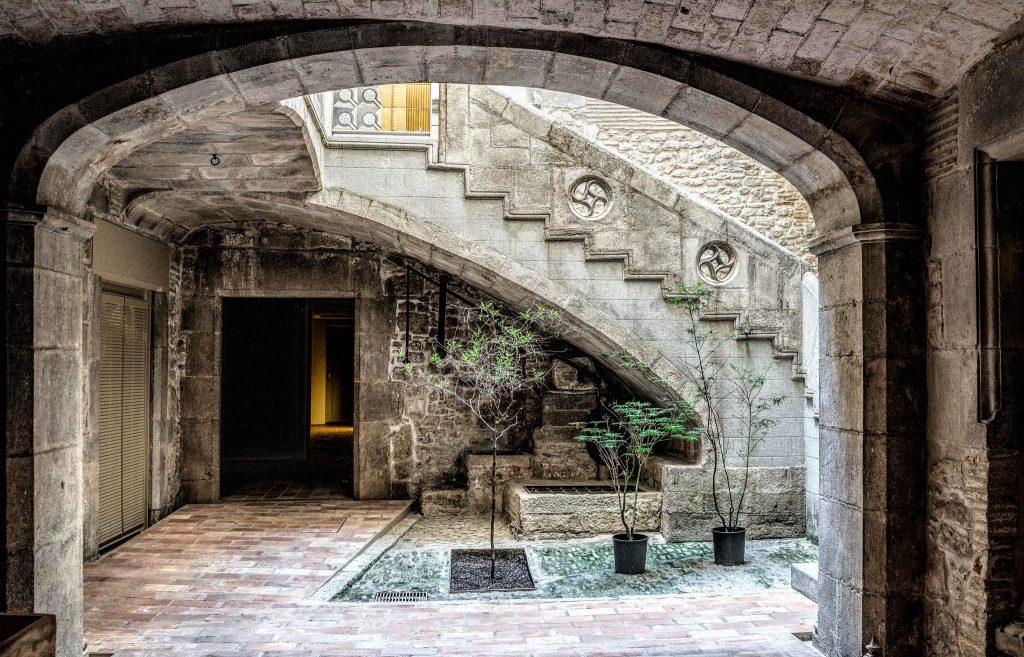
Gerona’s Jewish history has been famous since 1980, when the discovery of Sant Llorenç, a forgotten lane in the call (the Catalan equivalent of a judería), brought to light a vivid image of Jewish life in the old town. Up to the thirteenth century, the Jews lived in houses that belonged to the cathedral chapter, around today’s Plaça dels Apostols. They gradually extended the quarter around the Carrer de la Força. The area is best toured on foot.
Gerona had three synagogues in quick succession. The first stood near the cathedral and was demolished in 1312 during construction work. The second was in the Carrer de la Força, probably at numbers 21-25, but it was closed in 1415 after the bull of Pope Benedict XII. The third synagogue was in use at the time of the expulsion and stood at 10 Carrer de la Força, where the municipality has set up de Bonastruc de Porta Center for Jewish Studies (Centro Bonastruc de Porta). It is possible this building also housed the kosher butcher shop. The first phase of restoration work has revealed the handsome brick architecture. A little further down the road, on the corner of Carrer Cundaro, stands the house inhabited by Nahmanides.
The cemetery was located on a hill still called Montjuic (Jews’ Mountain). In 1492 the Jews donated it to the knight Joan de Sarriera, who had helped the community during the anti-Jewish riots. Subsequent owners used the tombstones as building materials. Many of them have been retrieved and studied and are now superbly displayed in the Archaeological Museum (Museu Arqueologic), located in the cloister of Sant Pere de Galligants. Others are in the historical museum of Gerona (Museu Historia de la Civtat). These moving vestiges are notable for the quality of their sculpture and their texts.
Note also the jambs at the entrances to the old Jewish houses. At 5 Carrer de la Força, for example, the niche made for the mezuzah can still be seen. The Seminary Biblical Museum has a fifteenth century one found at 15 Carrer de la Força in 1886.
The municipal archives (Arxiu Municipal) displays some notable documents and contracts written in Hebrew and Judeo-Catalan as well as old book bindings made from Hebrew parchment.
In the fourteenth century, and up to 1492, there was a large community in Castelló d’Empúries living around the Plaza Llana, in the calles de la Judería, del San Padre, and Peixetiries Velles.
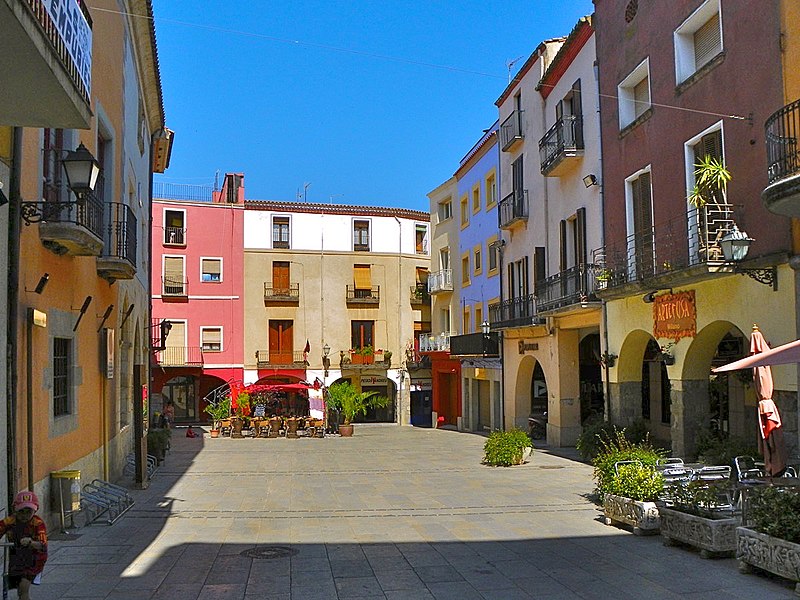
There are two known cemetery sites. A tombstone found in one of them can be seen in the local museum (Museo Parroquial), while seven others have been reused in various constructions.
In the fifteenth century some 15% of Tudela’s population were Jews. There were two quarters, one around the Zaragaza gate, the other within the castle walls, but nothing remains of these sizable communities.
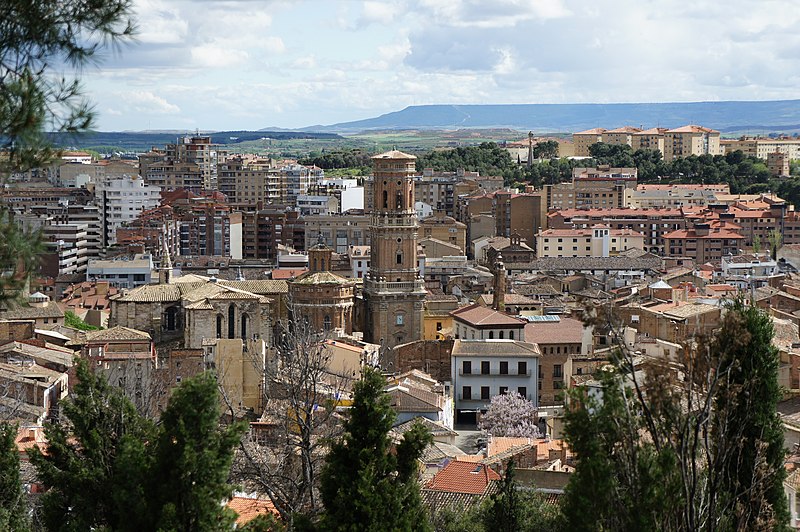
Visitors can, however, go to the Ribotas landing stage at the confluence of the Ebro and Merchando, where Benjamin de Tudela set off on his long journey. The journey which enabled researchers and historians to know so much about the state of Jewish communities and important figures of that era around Europe and even further east. A street was named in his honour.
Benjamin de Tudela
In the twelth century the tireless explorer Benjamin de Tudela spent some ten years traveling the world and filling his notebooks with impressions. He visited Zaragoza, Tortosa, Tarragona, Barcelona, and Gerona, journeyed through Roussillon and Provence to Marseille and from there sailed to Italy (Genoa, Pisa, Lucca, Rome, and Salerno) before going on to Corfu in the Aegean and then Constantinople. Reaching his gateway to Asia Minor, he hastened on to the Holy Land, then controlled by the Crusaders, and traveled to Jerusalem and Nablus before going to Damascus and Aleppo. He continued along the valley of the Tigris to Baghdad, then went to Cairo and from there via the Sinai back west to Sicily and Rome. Back in Europe, he felt the compulsion to head for Verdun and Paris, where he ended his journey. In addition to his own observations, Benjamin de Tudela also fleshed out his account with summaries of conversations with his fellow travelers about more remote lands such as Russia, Bohemia, and China.
The town of Vitoria had 300 Jews in 1290 and 900 on the eve of the expulsion -the equivalent of 6 or 7% of the total population. Their main activities were tax collecting and medicine. In 1492 they took refuge in Bayonne across the French border, where, even today, the Jews think of themselves as the descendants of those in Vitoria.
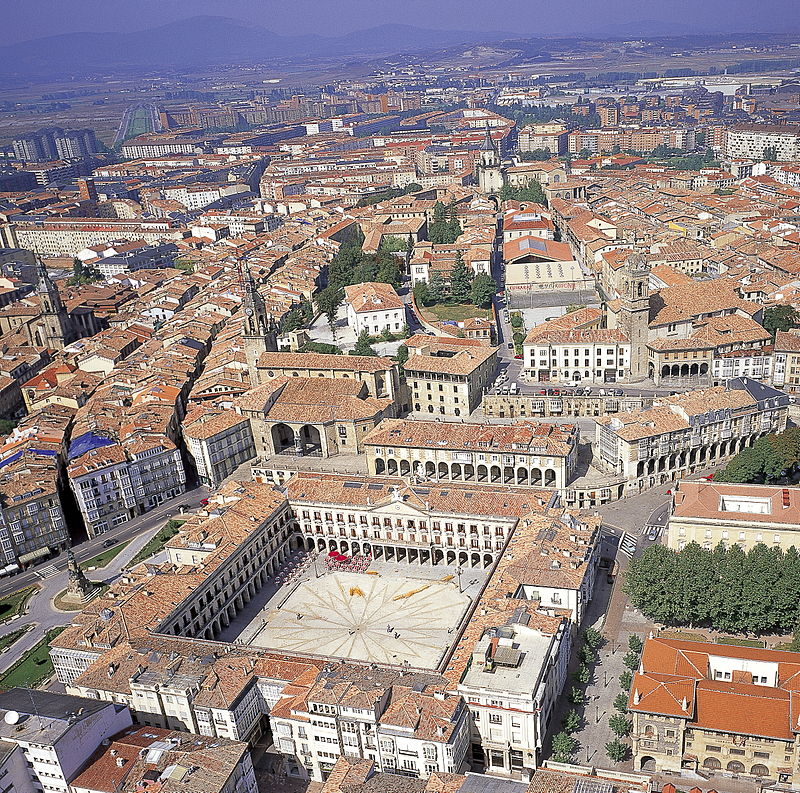
The most surprising vestige of the Jewish presence is the old cemetery, or Judizmendi (Jews’ Mountain). On 27 June 1492, the town council signed an agreement with the community, undertaking to respect and maintain the cemetery.
This accord was observed until 1952, when the town government obtained authorization from the Jewish community in Bayonne to transform it into a public garden. A monolith recalls this unusual piece of history.
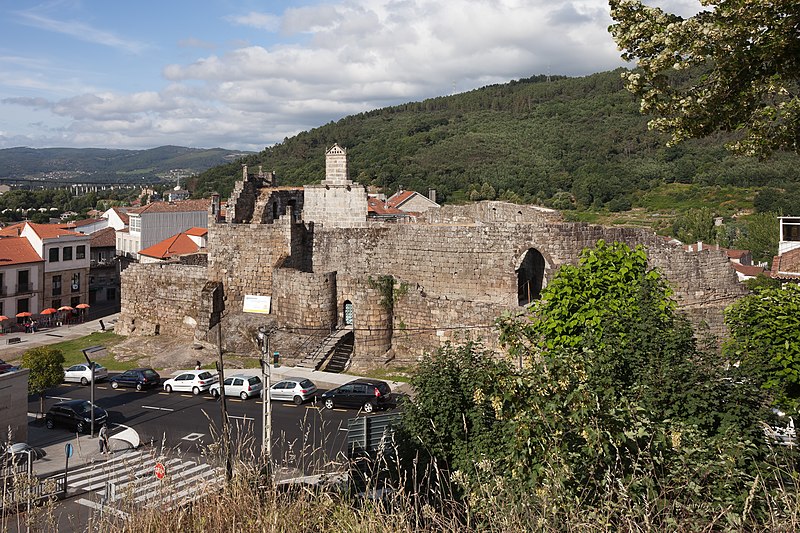
Probably the most interesting judería in Galicia, Ribadavia has kept its old Jewish quarter despite later urban developments. Although it is known Jews were there as far back as the tenth century, few documents about the life of their community remain.
The old synagogue is the building with crests on its facade in the Rua Merelles , which runs between the Plaza Mayor and Plaza de la Madalena. In September, the locals organize a Festival of the Jews with a costumed parade.
The earliest mention of Jewish shopkeepers in Aguilar de Campó, situated along the trading route toward the port of Cantabria, is from 1188.

A Hebrew inscription can still be seen under the town’s coat of arms on the old door of the Reinosa . It tells us that on 1 June 1380, work on building the door began, paid for by Don Caq (Isaac) ben Malak and his wife Bellida. The text is in Hebrew and Castilian, with Hebrew characters (aljamiado).
A small Jewish community lived in Puente Castro until the twelfth century. It disappeared during the wars between Castile and León.
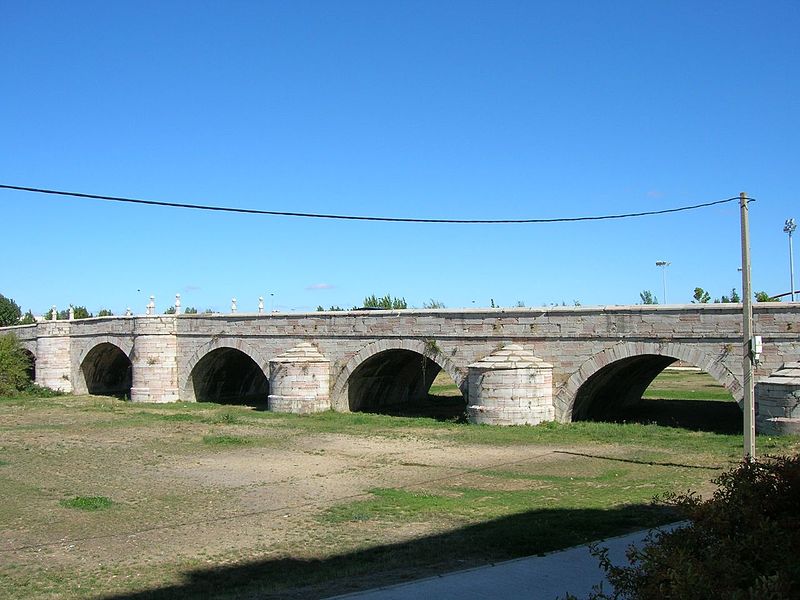
The cemetery has yielded more than a dozen magnificent tombstones. Three of them have been on permanent loan at Toledo’s Sephardic Museum since 1969, and a fourth can be seen at the diocesan museum in León. A fifth one, at the Archaeological Museum of León (Museo Arceologico de León), was discovered in fragments in 1983 and probably dates from 1100. Its elegantly written inscription reads: “Cientos the Saint may be blessed and absolved; take him in Your mercy and resurrect him to the life of the future world, amen.”
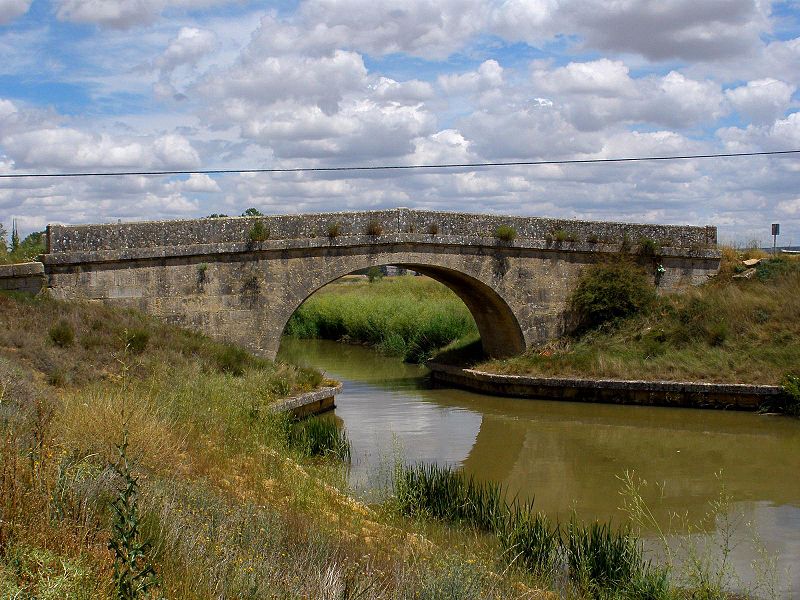
The village of Amusco is known to have had a community of some 300 Jews in the fifteenth century. The old synagogue is still here, surprisingly positioned on the village square next to the church and village hall; it is now the Synagogue Café (Café de la Sinagoga).
The medieval synagogue was at basement level. Its powerful vaults are supported by six arches. Its design is not surprising since in those days synagogues were not allowed to be too high or luxurious. Today it is a banquet hall.
Segovia was home to one of the biggest communities in the Kingdom of Castile. It produced important figures like Abraham Senior and his son-in-law Meyer Melamed, who served the Catholic monarchs up to 1492. Segovia also saw a violent anti-Jewish movement under the influence of the Santa Cruz convent and subsequently as a result of the “Holy Innocent Child” affair at La Guardia.
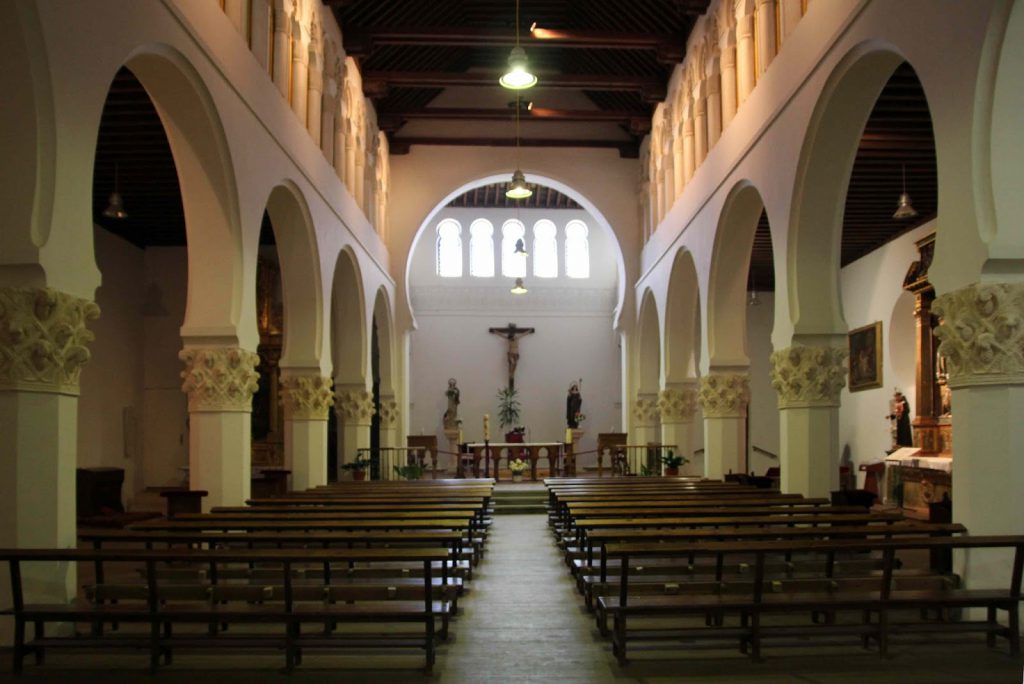
It is easy to find the old Jewish quarter, even if many of the buildings are more recent in origin. In particular, explore the streets of the Judería Vieja y Nueva. The synagogue has been transformed into the church of the Corpus Christi convent. It was, in all probability, built in 1410. In the nineteenth century, fire followed by negligent restoration destroyed the specifically Jewish part of the structure, apart from the original plan and a few pieces of stucco now in the local museum (Museo Provincial). In the Calle de la Vieja Judería, the Franciscan convent was built on a set of sixteenth and seventeenth century Jewish houses, including the home of Abraham Senior.
The “Sephardic Jerusalem” is known around the world for the beauty of its synagogues and its Jewish quarter. The memory of the community has remained vivid in Toledo; historians have from the thirteenth and fourteenth century onward been able to supply fairly precise information about the location and history of the city’s Jewish community. Toledo is a city of great historical and artistic importance and is listed here as a World Heritage Site.
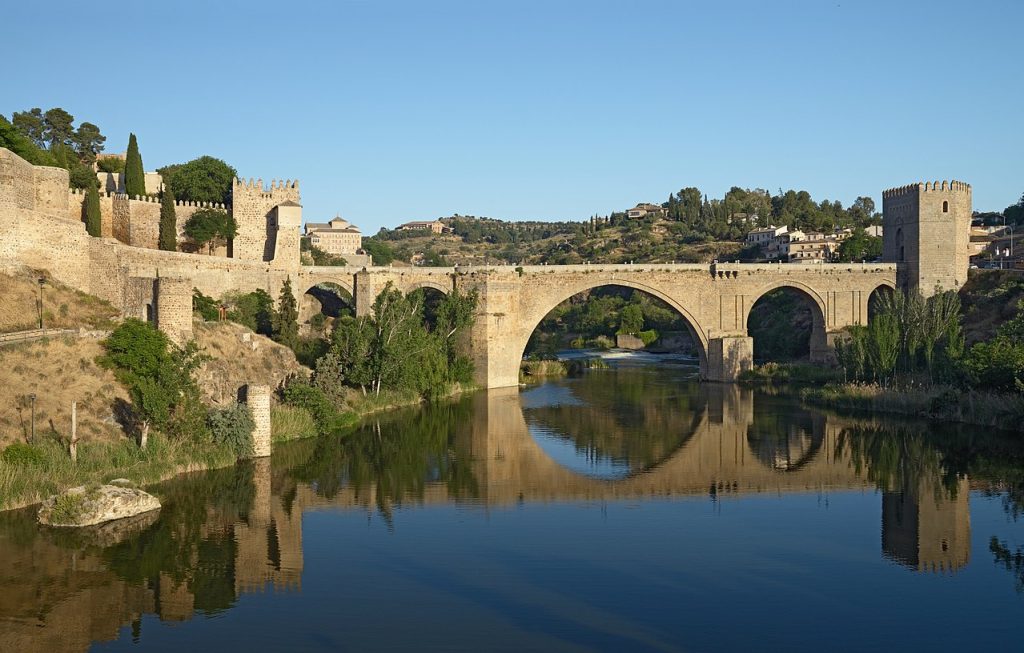
At the time of its greatest splendor, just before 1391, Toledo had ten synagogues and five to seven yeshivot. In 1492 there were five grand synagogues, two of which survive: the Tránsito, now the Sephardic Museum, and Santa María la Blanca.
The Tránsito Synagogue
The Tránsito Synagogue was built in 1357 at the order of Samuel Levi, treasurer to King Pedro I. Archaeological finds suggest this imposing edifice was erected on the site of an older synagogue. In 1492, the Catholic monarchs donated it to the Calatrava military order, which transformed it into a priory. During the Napoleonic Wars is served as barracks. In 1877, it was declared a national monument. When Spain’s Jewish community revived, the outbuildings became the Sephardic Museum.

As is often the case, the brick facade is austere, without decoration, but the interior is very beautiful. This is probably one of the finest example of the Mudejar style in Spain. Harmonious in proportion (approximately 76 x 30 feet high) it has an ornate coffered larch-wood ceiling. The women’s gallery has its own entrance and is well lit by five large windows. The synagogue is famed for its interior decoration. The wall with the niche made for the Sepher Torah is covered with panels and a plaster frieze sculpted in the oriental tradition. Numerous inscriptions along the wall commemorate Samuel Levi and Pedro I. Verses from the Psalms complete this decoration lit by windows with fine ornamental columns and lace-like mashrabiyahs.
In the outbuildings the museum exhibits gifts and articles collected from all over Spain, taking visitors through the history of Spanish Judaism. There are some very fine tombstones from León, and the oldest object os the sarcophagus of a child with inscriptions in Hebrew, Greek, and Latin and decorated with royal peacocks, a tree of life, a shofar, and a menorah. Seminars, courses, and talks are organized throughout the year on themes relating to Spanish Judaism. The synagogue is not used for worship.
Santa María la Blanca
The second synagogue, Santa María la Blanca , now bears its later name as a Christian church. Built in the early thirteenth century, it was consecrated as a church in 1411 by the preacher San Vicente Ferrer, the man behind the wave of conversions in 1391.

From 1600 to 1791, it was an oratory, and after that a barracks. It was restored in 1851 and declared a national monument. It is in the Mudejar style, but less rich than the Tránsito. Its twenty-five horseshoe arches and thirty-two columns create an impression of considerable space. Note the variety and quality of the capitals and the building’s similarity to Andalusian mosques.
Be sure to see the many streets of the old judería around the Calle Santo Tomé. In spite of much rebuilding, the area still has a certain charm.
The “Holy Innocent Child”
Jews in the two small villages of Tembleque and La Guardia near Toledo were accused of the ritual murder of a child, who immediately became a figure of popular legend under the name of the “Holy Innocent Child”. The accused were dragged before the Inquisition at Ávila in 1490 and 1491 and condemned. This stiry had such an impact that during the golden age, the great Spanish playwright Lope de Vega wrote the tragedy The Holy Innocent Child and Bayeu, Goya’s grandfather, painted a picture on the theme (it still hangs in the Toledo cathedral). Popular fervor bore fruit in the construction of a chapel on the road to Madrid, which still stands. Of course, historians have since shown that the accusation, although frequently repeated, was unfounded.
Suggested itineraries in the medieval Jewish quarter
In his book The Médieval Jewish Quarter of Toledo, which we recommend reading to anyone interested in the Jewish heritage of the city, Jean Passini offers three routes of visits to the city. Each of them will take you about an hour. If the majority of buildings are destroyed, you will however find some remains, and grasp the atmosphere that was once one of the most flourishing Jewish neighborhoods in southern Europe.
Route I: The borders of the medieval Jewish quarter
The tour starts at Plaza del Salvador, where the “Fernando Garbal jewish store and wine cellar” was located in 1491. The building is located at the foot of San Salvador Church. Then walk to Plaza de Marrón, where the Caleros Synagogue was located in the 15th century. Then take the streets Alfonso XII, San Pedro Mártir, Traversia San Clemente. You will arrive at Plaza de la Cruz, where was the north gate of the Jewish quarter. The house at number 1 of the place belonged to Master Alfonso, a pharmacist. Beyond the street Doncellas, there is a cellar with an octagonal dome, typical of medieval Jewish buildings. It can be visited by appointment. At number 11 Doncellas Street was a baking oven. Take Cuesta Street from Santa Leocadia and Calle San Martin to Callejón (Square) San Martin. On your left you will see houses built against what was the wall of the Jewish Quarter in 1637. At number 11 Calle Alamillos de San Martin, you will find the only surviving wall of what was a medieval tavern. At the end of Molino del Degolladero street, you will also find remains of the wall. On your right, take Bajada de Santa Anna where there was a medieval Jewish castle. Then you go past the old synagogue before ending up at your starting point, Plaza del Salvador.
Route II: The main Jewish district
From Plaza del Salvador, head towards Calle Taler del Moro to reach Paseo de San Cristóbal. Retrace your steps towards Plaza del Conde, then towards the Greek Museum. This museum is housed in what was Samuel Levi’s house. Two cellars are kept in the basement. There was also a courtyard and two rooms. You will then arrive at the synagogue of Tránsito, then at the old ritual butchery. Then take Bajada de Santa Anna, San Juan de los Reyes Bajada, Calle de los Reyes Católicos where the Sofer synagogue was located from the 12th to the 14th century. Turning left Calle del Ángel, you will pass under small arches that marked the entrance to the Alacava. Going down the stairs to Calle Santa Maria la Blanca, you will pass the synagogue of the same name. Continue to Traversía de la Judería. At number 4 you will find the Casa del Judío, the Jewish house, where you can visit the courtyard. Take Calle de San Juan de Dios, originally the main street of the Jewish Quarter. You will arrive at Calle, then Plaza de Santo Tomé, where there was the market, shops and stalls.
Route III: El Alacava
Start at Plaza del Salvador, then Calle Alfonso XII, Valdecaleros Plaza, Calle de las Bulas, Callejón de los Golondrinos. At numbers 29, 31 and 33 of this street were a synagogue and adjoining community buildings. From Plaza Virgen de Gracia, then Calle del Ángel, Arquillo de la Judería, then Callejón de los Jacintos, Calle Reyes Católicos, Plaza de Barrio Nuevo, Calle de Samuel Levi, Calle de San Juan de Dios, Plaza, then Calle from Santo Tomé.
Source (itinéraires) : Jean Passini, The Medieval Jewish Quarter of Toledo, Editions of Sofer
Interview with Carmen Alvarez, Director of the Museo Sefardi
Jguideeurope: Can you present us some of the objects shown at the museum?
Carmen Alvarez: The main masterpiece of our collection is the Samuel Levi synagogue: its artistic program, which is composed of a very rich group of plaster works and andalusian Moorish style wooden ceiling, is unique because of its style, both in Europe and in the Mediterranean area. It was one of the synagogues of the Jewish Quarter of Toledo and one of the proudest buildings owned by the Jewish Community in Medieval Castile.
The synagogue was built in mudejar style, that mixes Christian and Arabic decoration in this Jewish space. In this sense, the plaster works and the Hebrew and Arabic inscriptions of the building, together with the Andalusian influence, have become one of the best material examples of the coexistence between Jewish, Christian and Muslim religions in Toledo during the medieval period.
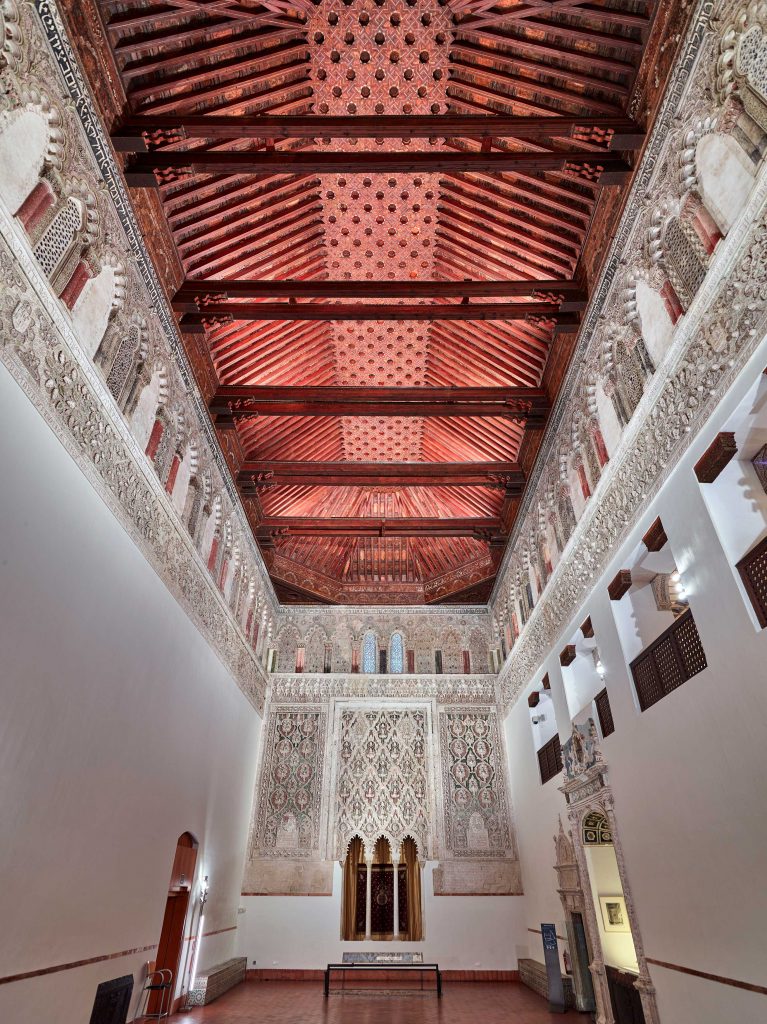
This epigraphy message, distributed along the building, is not only useful to recuperate the original cultural context but also extremely symbolic at the same time. In addition, it gives us an important message of the Jewish history in Spain. The founder, Samuel Levi Abulafia, was the main treasurer of king Pedro I of Castile, as well as the Court ambassador. But his life tragically evolved, as it occurred with the total of the Jewish community during the Catholic Period Kingdom until the official Expulsion in 1492 and the consequent Inquisitorial process, giving place to the complex phenomenon of blood purity. Toledo was one of the most visible examples in terms of converts groups and their cultural evolution: in Toledan archives, the history of many Jewish families who suffered this consequence is preserved.
The Samuel Levi synagogue was built between 1350-1360 as we can appreciate in the foundational inscriptions. The synagogue and midrash complex was actively used not only by the family but also as a community space in Toledo during the 14th century. For all these reasons, the building is mainly considered our core masterpiece giving origin to the Sephardic Museum of Toledo.

The National Sephardic Museum of Toledo was created as a consequence inside the ancient synagogue and it is considered one of the most important parts of the Jewish Legacy in Spain. The synagogue’s historical evolution is the main reason for its preservation. The Great Prayer Hall and the old Women Gallery are, by themselves, architectural treasures whose protection should be guaranteed. Attached to these spaces, we exhibit the major part of our collection, based on more than 2.400 pieces. The core exhibition is located around the historical building and in the ancient 16th century archive halls.
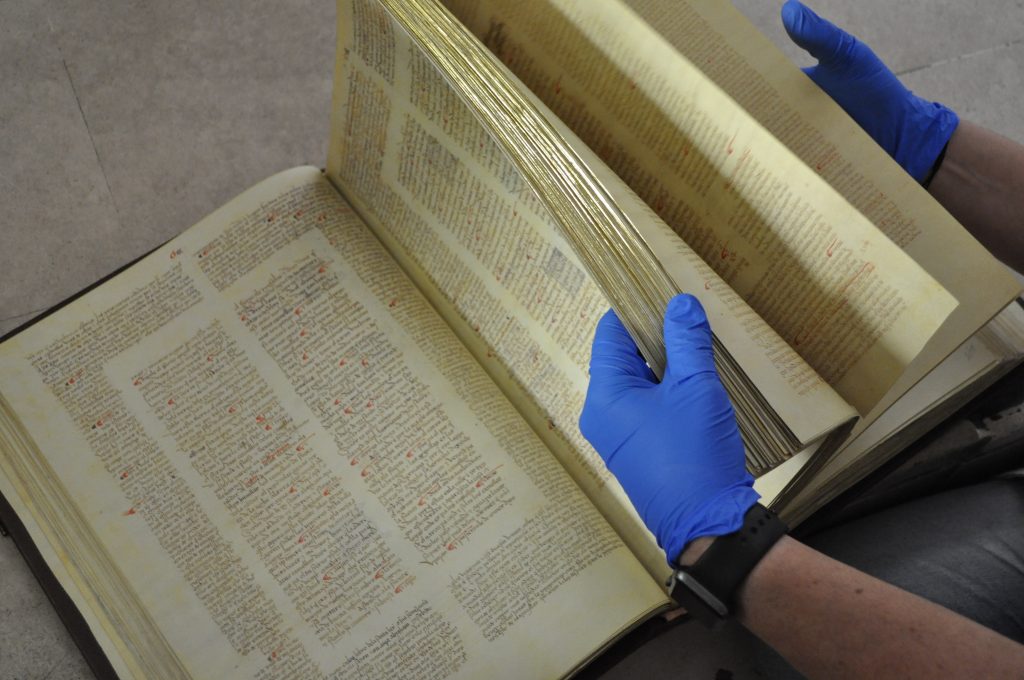
The permanent collection of the Sephardic Museum is mainly composed of archeological and ethnographical pieces. On one hand, we have antiquities that illustrate the history of the Jewish community in Spain, as the exceptional trilingual basin of Tarragona from 5th century that is, by the way, the inspiration of our corporate identity. On the other hand, we show a group of objects related to religion, traditions, life cycle and festivals, for example pieces of judaica or berberisca dresses (splendid gown used by Sephardi brides in northern Morocco), that are aimed to show all the richness of the Sephardi culture.
Moreover, it is highly remarkable for us our Old Bibliographic Collection, which is comprised of books, manuscripts and documents in Hebrew, Spanish, and Sephardic languages, spanning chronologically from the 14th century until 1950. Here you can find a link to more pictures and more information.
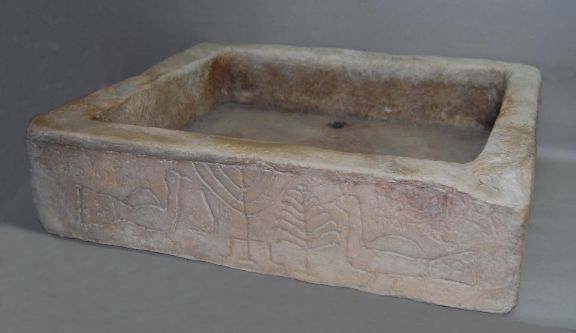
How do you perceive the evolution of interest in Sephardi heritage in Spain?
It is generally known that Sephardi heritage in Spain is trying to redefine its visibility through institutions and audiences. It has to do with its official network: we mean Spanish Jewish Community, University, CSIC (Scientific institution partly dedicated to the study of the Jewish culture and historical presence) and also cultural and tourism institutions. If all of us manage to coordinate and cooperate together, the main goal will be achieved. Science, communication and cultural programs could be better joined.
Nowadays we can find not a few important initiatives in Spain and Europe, as well, that are helping a lot in this task. And I don’t mean that the former institution’s efforts were useless, I mean that all these important bases are improving. From my point of view, we need to work more time together. Consequently, we will be programming and planning more exhibitions and cultural programs that could improve much more in terms of visibility of the Jewish culture in Spain. Since 1964 Sephardi Musem of Toledo aims to cooperate as much as possible, and we also work on that goal nowadays.
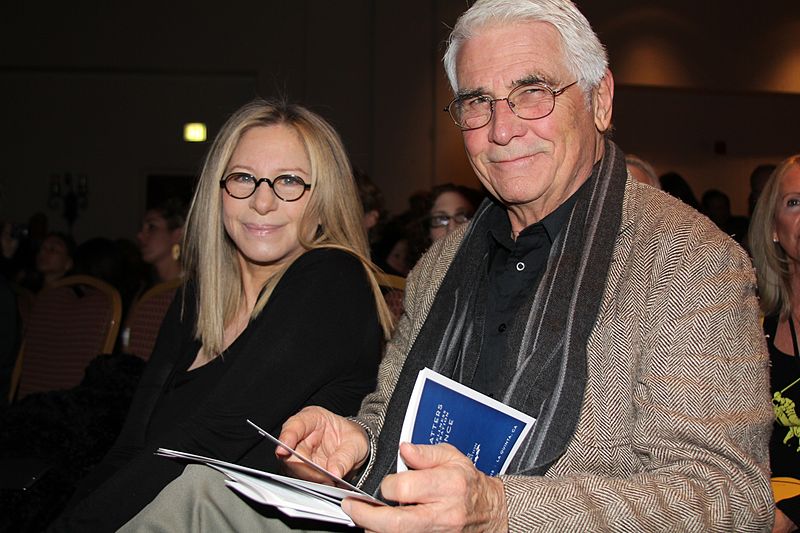
Can you tell us about a moving encounter at the museum with either visitors or exhibition participants?
There are a lot of good stories and amusing anecdotes at the Sephardic Museum, and many of them are contained in the visitor’s book of the Museum.
One of them is when Barbra Streisand visited us, at the beginning of my career here. I have fond memories of that day and I was pleasantly surprised that an internationally renowned artist was a close person and showed an interest in our collection. She told me that the pieces of the permanent collection are linked with her own life. For instance, she said that one of the ketubah of the exhibition was similar to that of her ketubah with James Brolin.
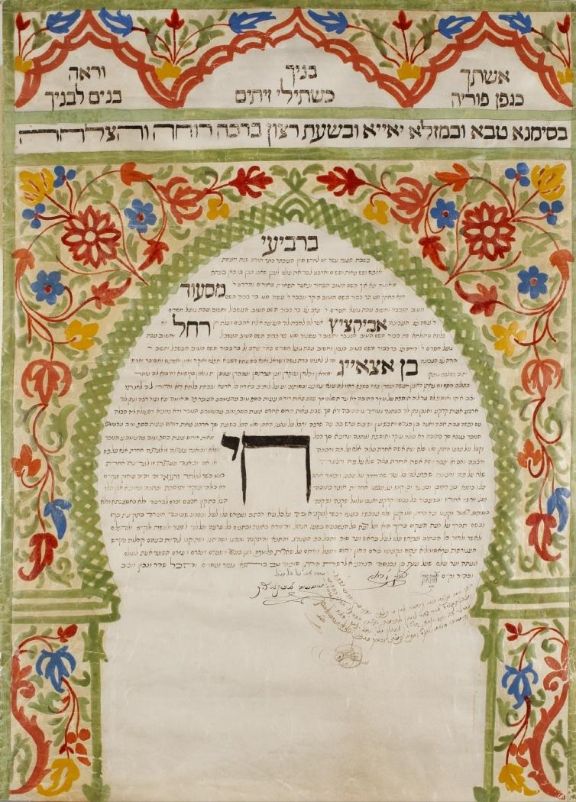
On the other, I still remember when Israel President, Ruben Rivlin, visited the Museum. He got excited when he signed at the visitor’s book because his signature was next to the Yitzhak Rabin signature. In saying this, I want to point out that the powerful emotions were feeling by all kind of people here in this Museum. This is the meaning of the Sephardic Museum.
But certainly, I want to tell you a magic anecdote linked with the previous director of the Museum, Santiago Palomero. Several years ago, Palomero found a special sign at the visitor’s book. It was a sketch of Corto Maltés, one of the most famous maverick and adventurer characters of the comic world by Hugo Pratt.
Palomero remembered that a mysterious and private man had visited the Museum some days ago and he resembled Hugo Pratt. Nowadays we consider this sketch as an artistic piece of the collection.
As you can see with such a surprising encounter, Jewish culture is still alive at the Sephardic Museum.
In the film A Monkey in Winter, Jean Gabin and Jean-Paul Belmondo debate whether the Prado is a museum surrounded by a garden or a garden on which a museum is placed. What is certain is that the place and the city that hosts it inspire Belmondo throughout the film.
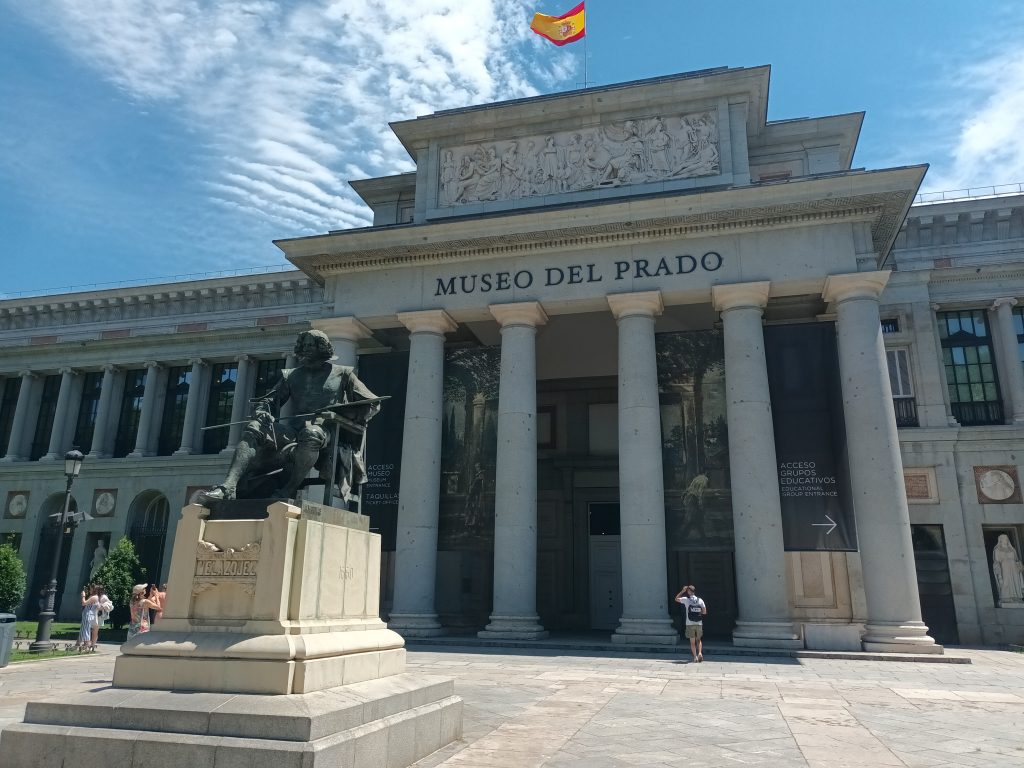
And has inspired generations of conquerors, artists and authors for millennia, as evidenced by the great cultural and architectural wealth of the Spanish capital. Madrid will charm you with its diverse sources of beauty and inspiration between the Royal Palace and the Prado and well around and beyond.
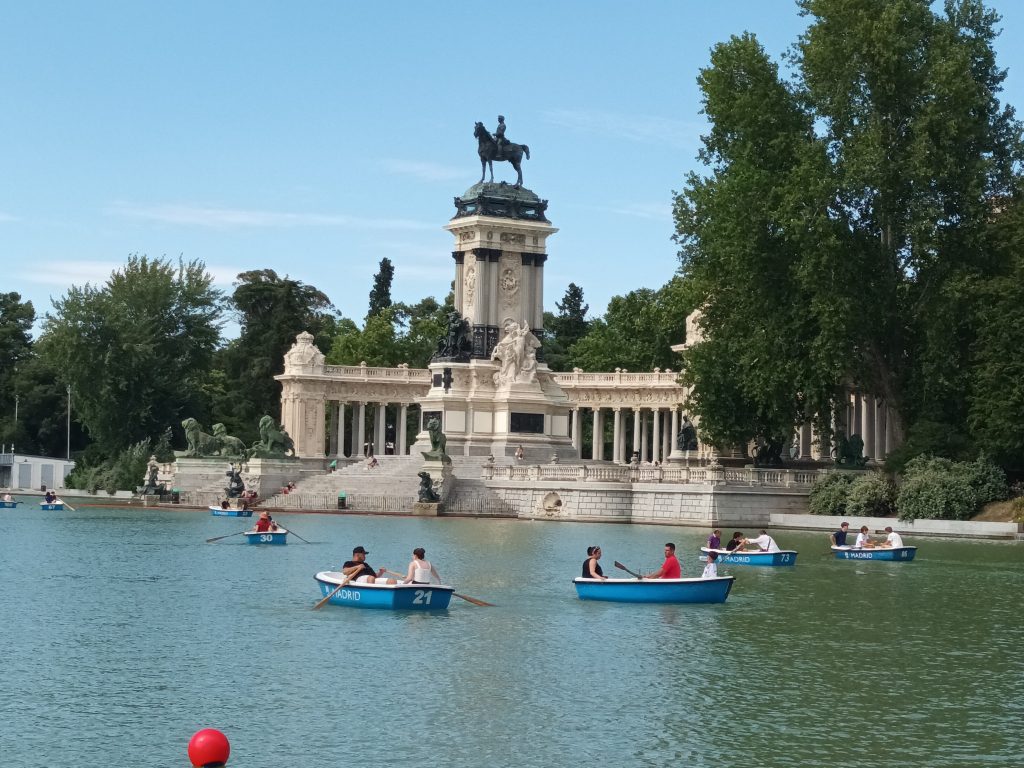
We know that from the tenth century onward there was a small Jewish community in Muslim-ruled Madrid. This grew considerably after the reconquest.
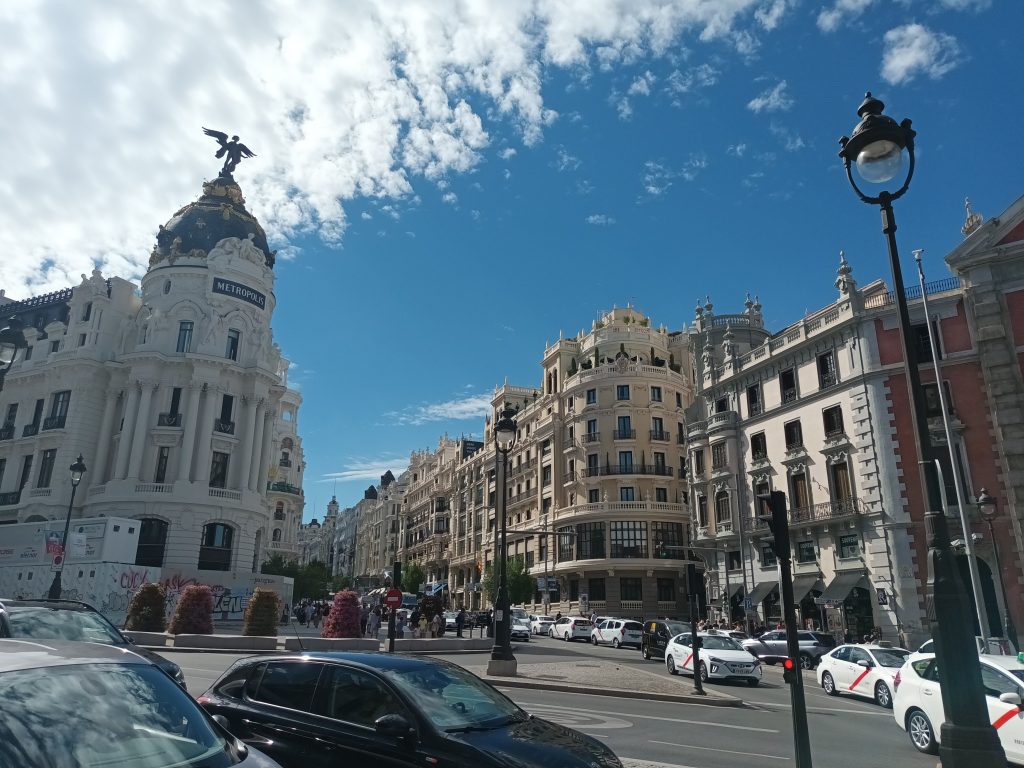
Though hit hard by the pogroms of 1391, it was slowly built up again. It is also known that Jewish doctors such as Rabbi Jacob were, under the king’s protections, allowed to live outside the Jewish quarter, the better to tend to the sick.

In 1492 the Jews of Madrid left for Fès (Morocco) and Tlemcen (Algeria). The city’s six Jewish doctors went with them, leaving it without medical assistance. However, they resumed their position in 1493 after converting to Christianity.
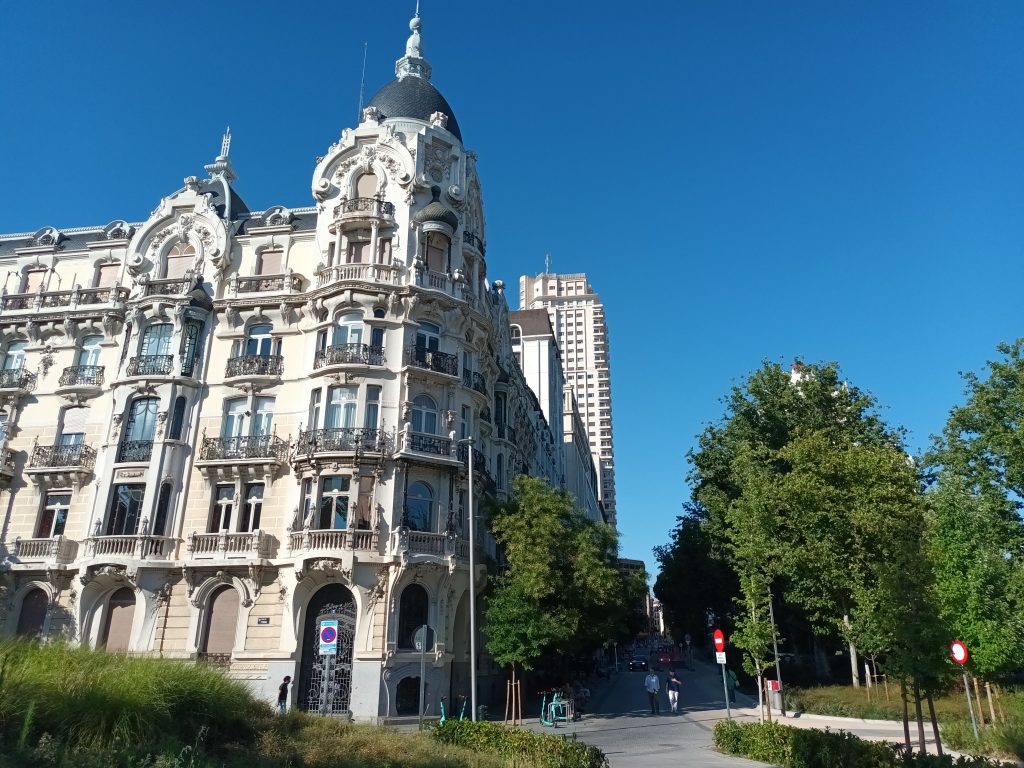
Thanks to research by Madrid historians, it is possible to locate the city’s two Jewish quarters with considerable precision, although sadly few tangible traces remain. They formed around the Plaza Isabella (Calle Independencia and Vergara) and the Almudena cathedral, near the old Alcázar in the Cuesta de la Vega.
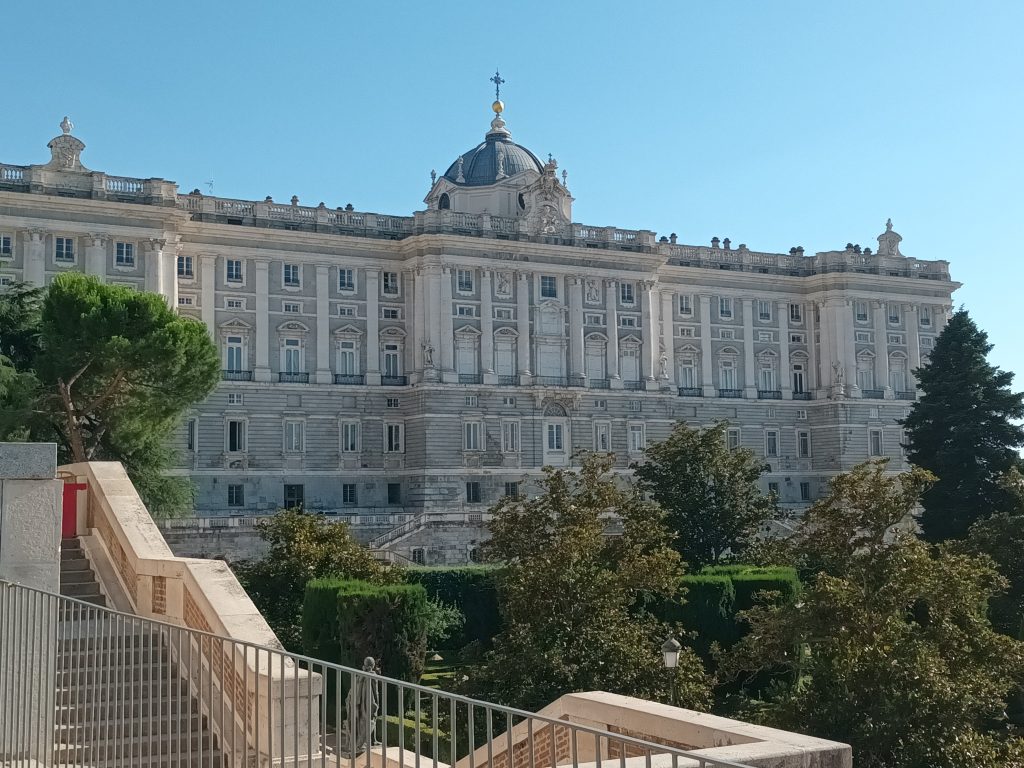
The Jews came back to Madrid only in the 1850s, sporadically and in an unorganized way. These were shopkeepers and bankers who, among other activities, were involved in the creation of the railroads. The best known of these families were the Bauers, who represented the Rothschild Bank.
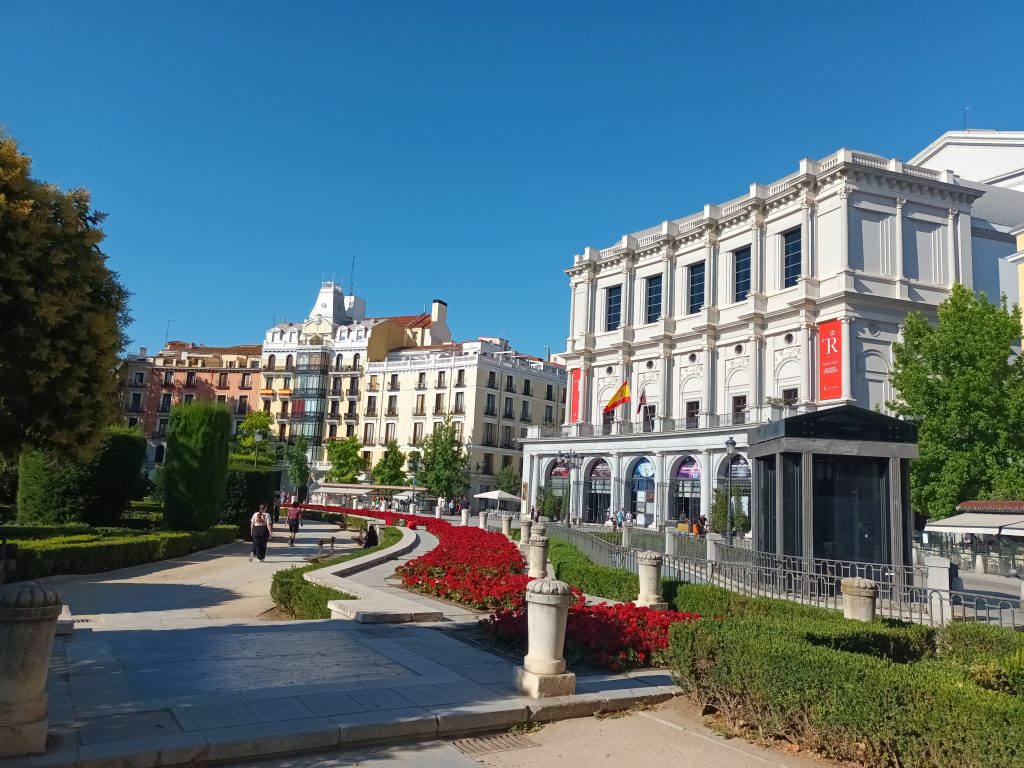
Since they did not have their own cemetery, they created a special section in the British cemetery in the first years of the twentieth century.

A monument inspired by ancient Egypt houses the remains of Gustave Bauer (1867-1916), Manolin Bauer (1898-1906), and Ida Luisa Bauer (1906-08). Another thirty tombs remind us of the existence and origins of this small community in the early twentieth century.
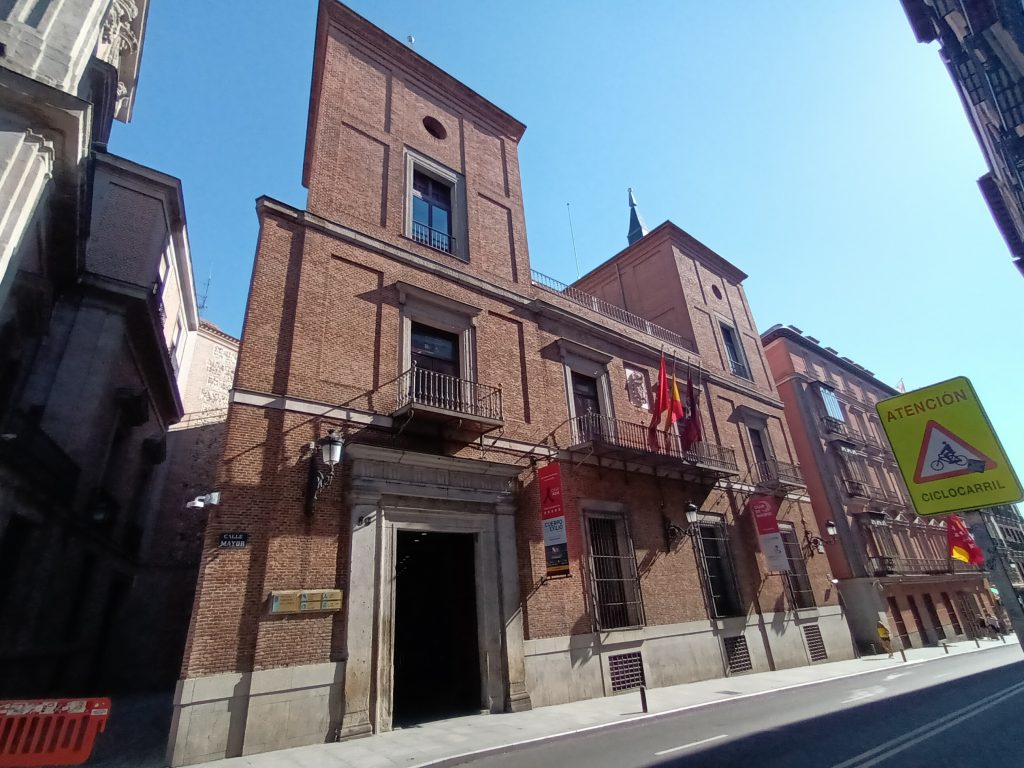
A community of several thousand formed here during the Second Republic but disappeared during the civil war. In 1964, work has begun on the synagogue in the Calle Balmes, which also houses the Community Center. It was opened in 1968. The prayer hall is decorated with copies of the Hebrew inscriptions in the Tránsito Synagogue in Toledo. The community has a mikvah, a kosher butcher, and a school.

Madrid is also the headquarters of the journal Sefarad , a publication of the CSIC (Higher Council of Scientific Investigation), which, since its foundation in 1941, has published most of the Spanish and international research of Sephardic Judaism.
In 2023, following the pogrom in Israel, Jewish community organisations voiced their concerns about the sharp rise in anti-Semitic acts to local and national authorities.
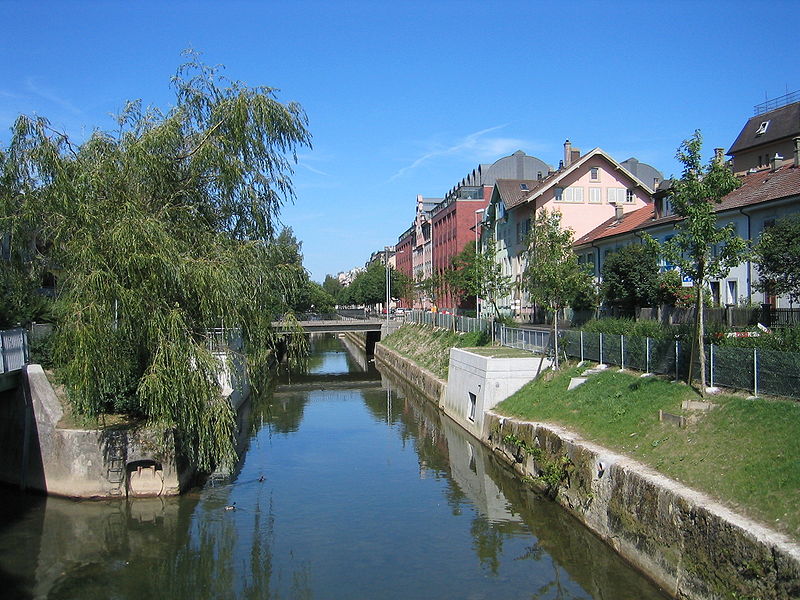
It was the clock-making industry that attracted Alsatian Jews to the Jura beginning in 1835. Among the great names in this industry was Achille Picard. From 1858 onwards, devout Jews met in a prayer room.
They opened their Moorish synagogue in 1884. Its most recent interior renovation, in 1995, stressed the contrast between sober walls and the twelve multicolored stained-glass windows featuring biblical subjects, the work of Israeli artist Robert Nechin.
The 1999 exterior renovation brought back four small domes shaped like bells that had been removed in 1956. The facades are light beige, discreetly decorated with red motifs on the friezes and around the windows. The synagogue was the victim of antisemitic attacks in 2021.
A section of the cemetery of Tanzmatten and later of Biel-Madretsch was given to the Jewish community by the town council.
While the Jewish population reached 500 people at the beginning of the 20th century (a good part of whom came from Eastern Europe), there were only 150 in the early 1990s.

The Jewish presence in Bern probably dates from the 6th century. Jews are mentioned in the legal texts. During the Middle Ages, as in many other cities in the region, the situation of the Jews varied between reception, persecution (which began in Bern in 1294) and expulsion, depending on the power in place. In the wave of great expulsions that took place between the end of the 14th and the end of the 15th century, the Bernese Jews were expelled in 1427.
In the fourteenth century, the Jewish ghetto extended into the federal government’s current site: the Inselgasse, seat of the Department of the Interior, was called the Judengasse; the Federal Palace took over the spot of the Jewish cemetery. The current Community Center and its Moorish synagogue are not far away, on the Kapellenstrasse.

An unusual feature of the Kornhausplatz is Ogre Fountain, which dates from 1544. For some, the statue of the ogre in the act of devouring children represents merely a carnival image. For others, it is a Middle Age representation of the Jew accused of killing Christian children. The ogre is waring a pointed yellow hat, identical to the one imposed on the Jews to make them easily distinguishable.
In 2017, the Museum of Fine Arts in Bern presented the exhibition “Degenerate, Confiscated and Sold Art”. Among the 200 works were paintings by Franz Marc, Otto Dix and Otto Mueller. They are part of a legacy of the collector Cornelius Gurlitt, who also gave the museum paintings by Cézanne, Delacroix and Munch that he had hidden in his Munich flat for decades. His father was commissioned by the Nazis to sell art stolen from Jews by the regime, art labelled “degenerate”. The recovery of the works by the families was at the heart of a long legal process. The works shown in the exhibition do not concern the stolen paintings.
Interview with Jacob Guzman, historian and active member of the Jewish community of Bern
Jguideeurope : What motivated your commitment to the development of Bern’s Jewish cultural heritage?
Jacob Guzman : This heritage is in danger of disappearing if we don’t take the trouble to make it known to the population. We need other media than history books.
How did the big exhibition about Albert Einstein work out?
The director of the history museum contacted the community in Bern to get some information about Jewish life in Bern at the time of Albert Einstein. We have given some ritual objects, a Torah, and a towel that belonged to Einstein on long-term loan.
Can you tell us about an encounter with a visitor or speaker at a cultural event that particularly impressed you?
One example among many: the meeting with the architect Ron Epstein who wrote a book on the architecture of synagogues in Switzerland. We had the privilege in Bern to have, for several years, a series of lectures on Jewish themes. These paid lectures were, although organized by a member of our community, open to everyone. This gave us the opportunity to have contact with many speakers and allowed the non-Jewish public to know some aspects of Jewish culture.
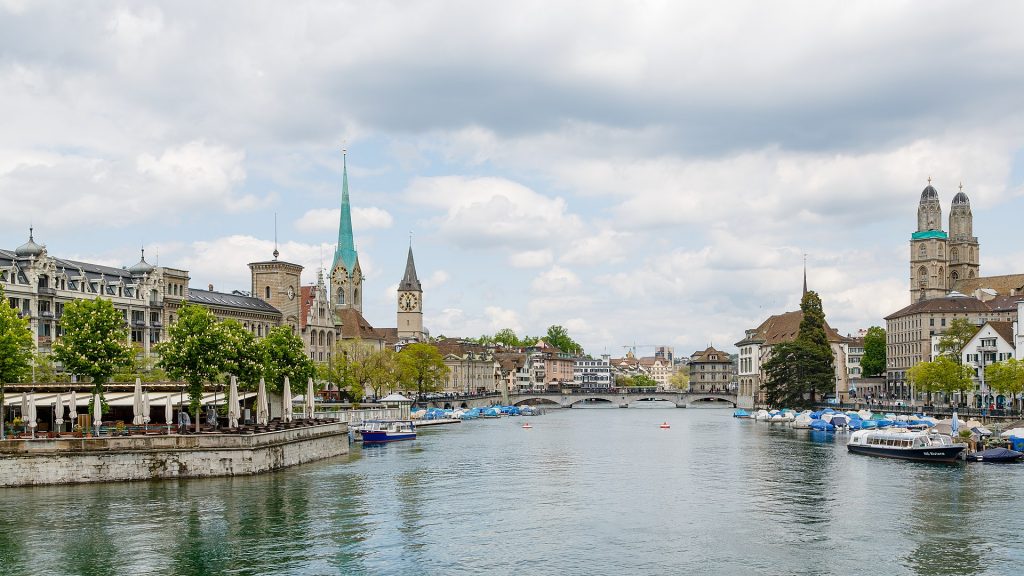
The Jewish presence in Zurich probably dates back to the 13th century. During the Middle Ages, as in many other cities in the region, the situation of the Jews varied between reception, persecution and expulsion, depending on the power in place. In the wave of major expulsions that took place between the end of the 14th and the end of the 15th century, the Jews of Zurich were expelled in 1436.
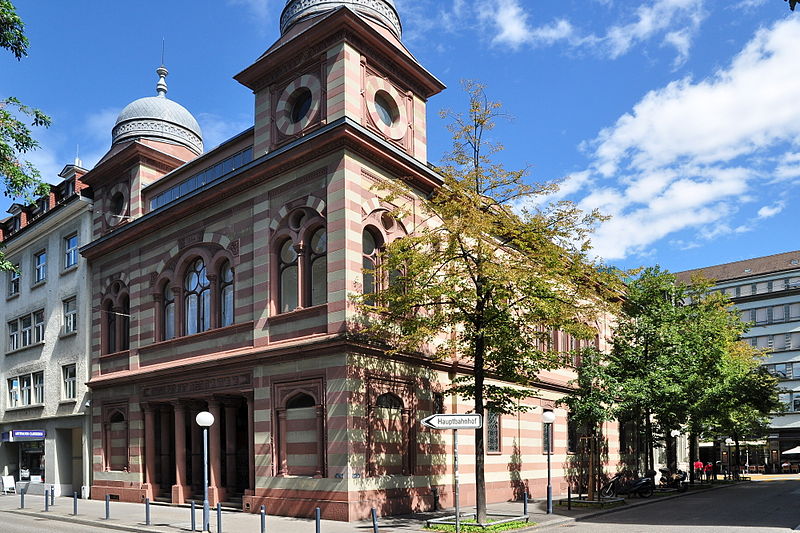
Zurich contains the headquarters of the Swiss Federation of Hebrew Communities , founded in 1904 and whose archives were recently entrusted to the Zurich Federal Polytechnic School for better preservation there.
The collection includes the documents from JUNA, the FSCI press office, the Union of Jewish Mutal Aid Societies, the Swiss Refugees Council, the Union of Jewish Students, and the Action Group for Jews in the Soviet Union, along with extensive private archives.
The former ghetto of the Brunnengasse was the site of a 1349 pogrom against the Jews, who were accused of having spread the plague.
A commemorative plaque was unveiled 650 years later at 4 Froschausgasse, where the former synagogue stood. The narrow, nameless alley that leads to the Neumarkt was renamed Synagogengasse. In 2020, the Jewish community numbers 2500 members.
Today, the Israelitische Cultusgemeinde Zurich (ICZ), founded in 1862, represents the most important Jewish community in Switzerland.

The ICZ’s synagogue, at the corner of the Löwenstrasse and Nuschelerstrasse, was built in 1884 in Moorish style; it features a beige and red-striped facade, two towers topped by domes, and traditional windows. Its community centre housed a kosher restaurant, which was closed in 2019. There is also a school, a library and a mikve.
In addition, three distinct Jewish communities inhabit the city, each centered upon its won synagogue: the Orthodox Israelitische Religionsgesellschaft ; the Reform Or Chadasch community; and finally, the sizable Hasidic community around the Agudas Achim Synagogue , which gives off a truly shtetl ambiance.
In 2024, violent anti-Semitic attacks took place in Zurich, including physical assaults and an attempt to burn down a synagogue.
In 2025, the Jewish population was estimated to be around 7,000. There are two kosher shops in the city, including The Shuk, located on Waffenplatzstrasse.
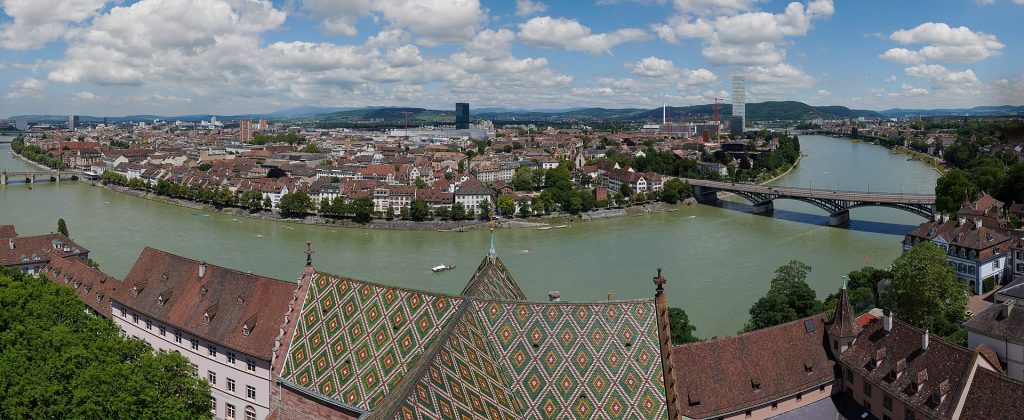
The Jewish presence in Basel probably dates from 1213. During the Middle Ages, as in many other cities in the region, the situation of the Jews varied between acceptance, persecution and expulsion, depending on the power in place. In the wave of major expulsions that took place between the end of the 14th and the end of the 15th century, the Basel Jews were expelled in 1397.

“In Basel, I created the Jewish State”, wrote Theodor Herzl in his diary after attending the First Zionist Congress, held from 29 to 30 August 1897. Nine more congresses would take place in Basel. A street in his name and a plaque in the casino serve as a reminder of the Zionist adventure’s origins in Basel.
First opened in 1868, the synagogue is the work of the architect Hermann Gauss, who took the one in Stuttgart, with its neo-Byzantine, Moorish, and Romanesque styles, as his model. It was enlarged twenty years later, and a second dome was added. During a further renovation in 1947, someone decided to cover the synagogue’s brightly colored walls in uniform gray. This gray corresponded better to the austerity of the era and local taste.
Forty years later, the colors of yesteryear resuscitated the refinished building. Modernizing the motifs had nonetheless dampened the eastern style. Inside, yellowish beige dominates, with blue and red decorations. A multitude of golden stars stand out against the dome. The polychromatic facades are red and white.
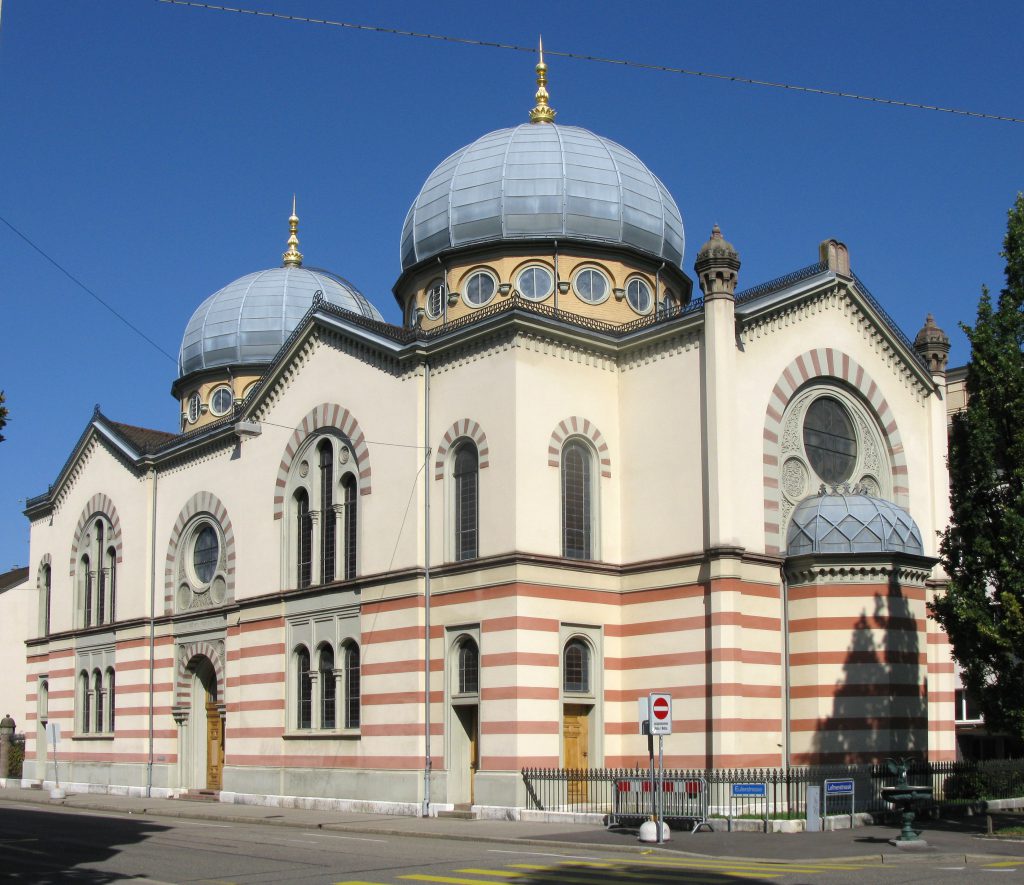
The only Jewish Museum in Switzerland (Jüdisches Museum der Schweiz) is found in Basel. Its collection reflects the region’s Jewish heritage and features books in Hebrew printed in Basel, gravestones, and documents on Jewish history and the Zionist congresses.
The Community Center houses as well the kosher restaurant Topas.
In 2012 the first synagogue in 83 years was opened. At that time, the Jewish community numbered almost 2000 members. It is part of the Chabad Feldinger Jewish Centre . It is located next to the Chabad Synagogue. It was vandalised in 2018. In the same year a kosher butcher shop was attacked several times.
Interview with Barbara Haene, Head of research and events at the Jewish Museum of Switzerland
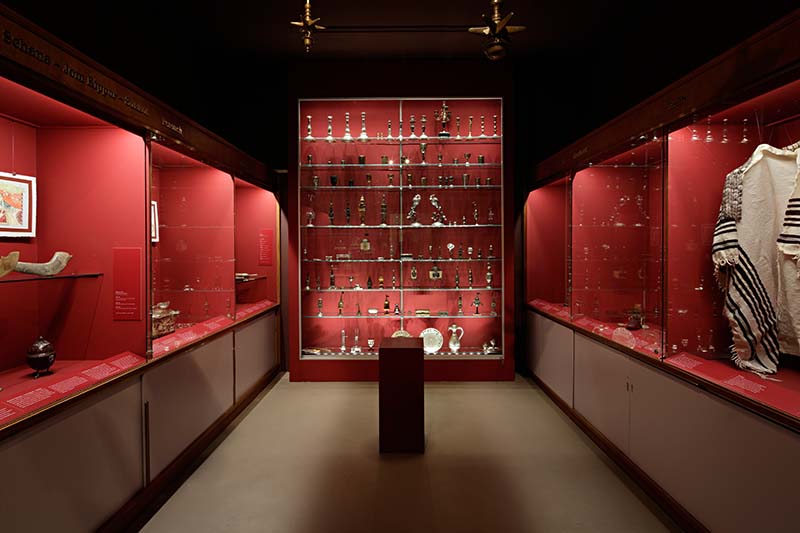
Jguideeurope: What events are planned for the European Days of Jewish Culture?
Barbara Haene: The Jewish Museum of Switzerland has been in charge of the organization of the European Days of Jewish Culture in Switzerland since its initiation in 1999. We have all kind of activities. The city tour “In Herzl’s footsteps through Basel” and the guided tour of the synagogue are also very popular every year.
Can you introduce some of the objects in the “Jewish for beginners and experts” exhibition?
As a historian working on the Jewish history of Switzerland, I of course have certain preferences. I particularly like objects that bear witness to the simple life of the Jews in the Endingen Lengnau countryside, for example, a Torah coat originally used for a woman’s dress.
Or a pocket watch from La Chaux-de-Fonds that testifies to the importance of Jews in the watchmaking industry in Switzerland. Of course, the first Zionist Congress, which celebrates its 125th anniversary this year, is also of great importance for Basel’s Jewish history. The Jewish Museum holds numerous objects relating to the first Zionist Congress. For example, a collotype showing the participants of the congress is worth seeing.

Have you noticed a change in public expectations in recent years?
Over the last few decades, the knowledge of young people has changed. They used to be relatively familiar with the biblical stories, especially the ones concerning Adam and Eve, Moses and the Ten Commandments, Rachel and Leah. They knew the Old Testament characters from church, from religion classes, or from their children’s Bibles. Today, secularization has greatly increased.
Few young people visit churches. Almost no one reads the Bible either. But today, those same young people know more about Jewish customs. They know about Hanukkah and Shabbat, about bar / batmitzva holidays, and about kosher regulations.
Diversity is in vogue. Young people encounter Jewish culture in school, on Netflix and Youtube, in pop music, and in food. Their knowledge of Judaism is marked by hummus, falafel and bagels, among other things.
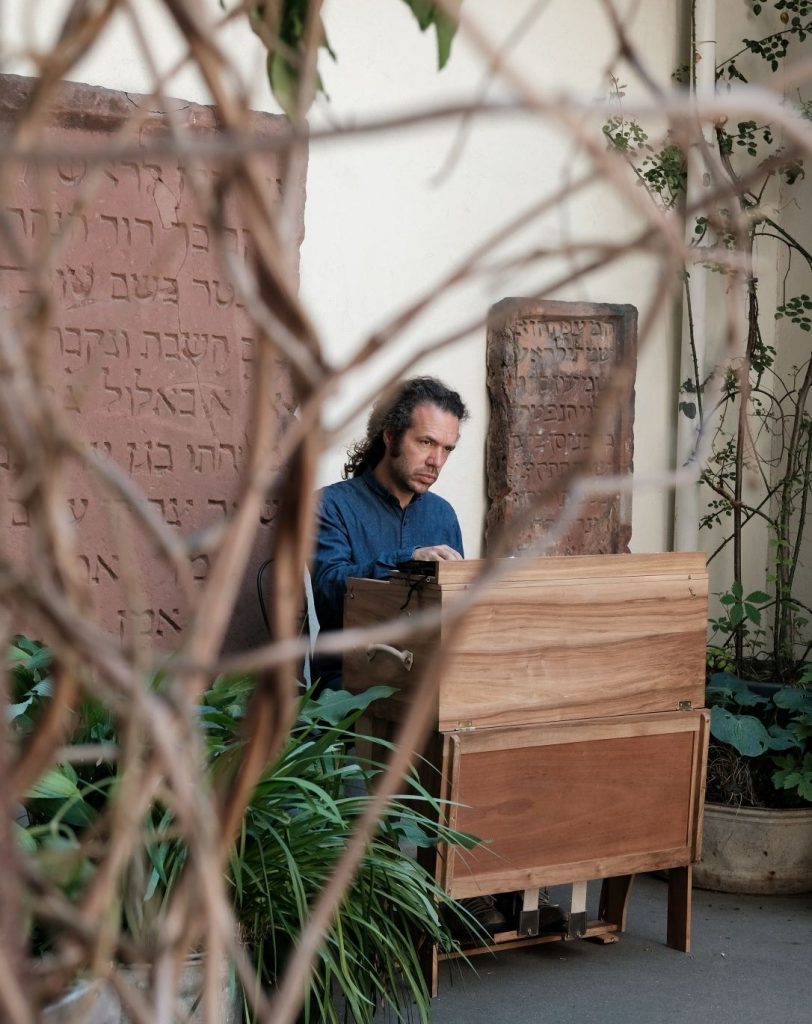
Can you tell us about an encounter with a visitor or speaker at a cultural event that made a particular impression on you?
A few weeks ago, we welcomed Rabbi Bea Wyler to the museum. We have her prayer shawl, her talith, in our collection. Bea Wyler was the first woman to serve as a rabbi in German-speaking Europe after the Holocaust. When she was ordained in the 2000s, she was confronted with many opposing currents as a woman in an all-male profession.
Today, she is the first in a series of young female rabbis. Women are valued, enjoy a certain prestige, and are only experiencing headwinds in some Orthodox and ultra-Orthodox circles.
Until the end of the eighteenth century, the two villages of Endingen and Lengnau were the only ones that authorized the permanent establishment of Jews. Beginning in 1622, they resided here under the rubric of “protected foreigners”, and their communities were able to practice religion and conduct internal administrative affairs in total independence. A document from this year attests to their presence.
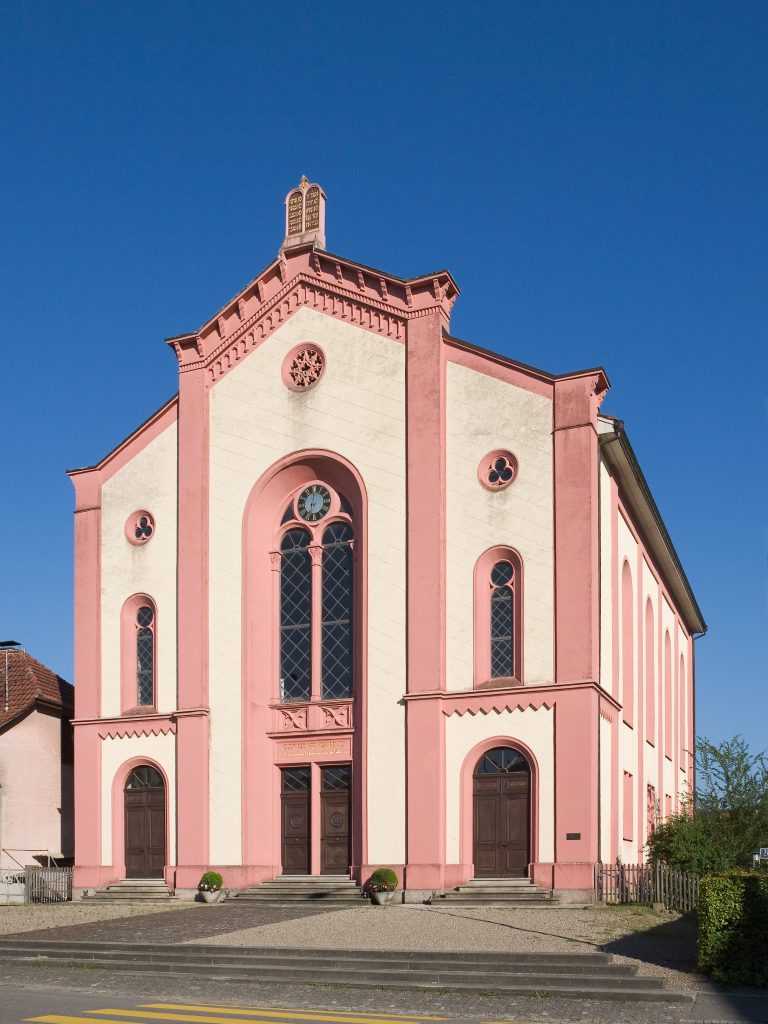
In 1750, the two communities purchased a plot of land midway between the towns for a cemetery . Before this, Jews were obliged to bury their dead beyond the Rhine on an island which was later purchased by the town of Waldshut. The Jewish cemetery has 2700 graves.
The first synagogues date from 1750 for Lengnau and 1764 for Endingen . They were renovated in 1848 and 1852 respectively. They appear in a book by Johann Caspar Ulrich published in 1768.
They resemble churches, with a clock on their pediments and steeples, elements required by the authorities. In 1850, there were 1515 Jews present in these two cities. These Jews came mainly from the towns of Haute-Alsace (Buschwiller, Hegenheim, Hagenthal…), the Baden region (Randegg, Wangen, Gailingen, Worblingen…) and Hohenems. Those cities were close to Switzerland, with which the general population had economic and cultural ties.
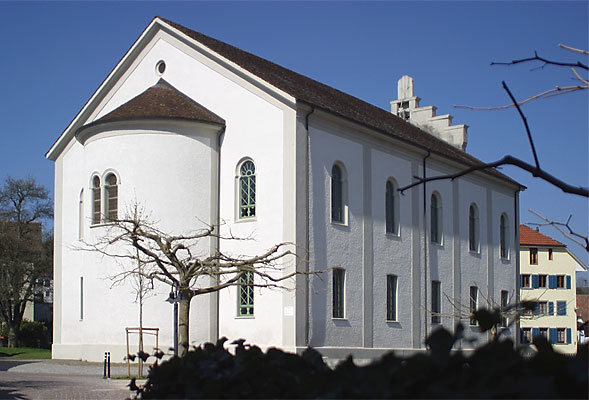
The permits granted to migrate to the other municipalities caused a constant fall in this number. The wave of emancipation of the Swiss Jews took place throughout the 19th century, depending on the municipality.
In Endingen, a churchless village, it was the synagogue on the central square that struck the hours. The building was ultimately renovated in 1998.
The town’s policy of tolerance must not overshadow the discrimination that was still current around 1910: all houses had two front doors, one reserved for Christians and the other for Jews. There are many houses that bear witness to this period. Unlike most of the Jewish ghettos in Europe, the traces of Jewish life are still very present in these villages. Among the personalities from these villages is William Wyler, the director of Ben Hur and Funny Girl.
Since 2009, a Jewish cultural tour is presented by the local authorities to pay tribute to the historical heritage of the villages. Visitors can walk between synagogues, cemeteries, double-entrance houses, as well as an old mikve and shops.
In 2018, there were only about 20 Jews left in Lengnau and Endingen. Most of them were elderly people living in a retirement home.
Founded in 1833, the Jewish community of La Chaux-de-Fonds met in a flat on rue Jaquet-Droz. Then, in 1853, a private house was used as a synagogue. From 1872, a Jewish cemetery was used in the commune of Les Eplatures.
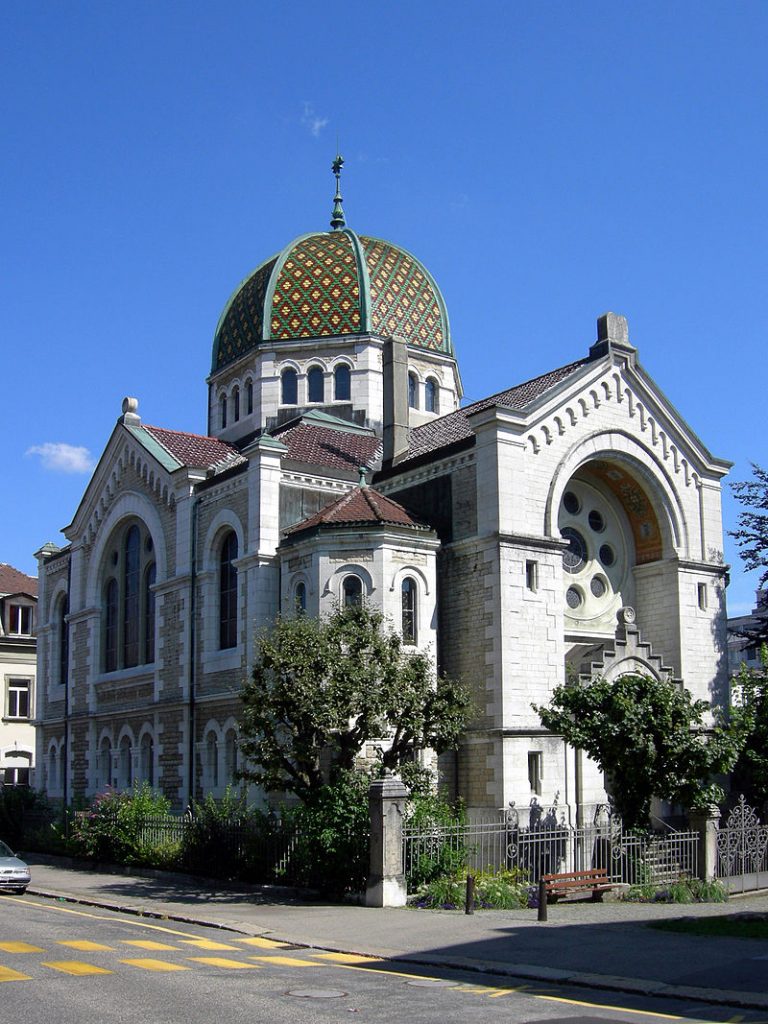
La Chaux-de-Fonds’s Jewish community opened its first synagogue in 1896. Architect Kuder was inspired by the synagogue in Strasbourg, which was later destroyed by the Nazis. In Romanesque style and constructed in freestone, the building contains a 105-foot-high octagonal dome with twenty-four windows and is covered in polychromatic tiles. The facade includes the tablets of the Law and two turrets. Inside, the central dome and four smaller domes at each corner are multicolored, in harmony with the stained-glass windows. The principal motif is a Star of David, from which rays extend that bear the names of biblical characters upon a starry sky.
In 1900, La Chaux-de-Fonds was the fourth Swiss town with the most Jewish inhabitants, after Zurich, Basel and Geneva. Some of the great names in the watchmaking industry lived there. Other professions practiced by the Jews of La Chaux-de-Fonds include crafts, antiques, and teaching. They also played an important role in the arts and culture, as well as in the world of sport.
In the second half of the 20th century, the Jewish population fell. At the turn of the millennium, there were 70 Jews.
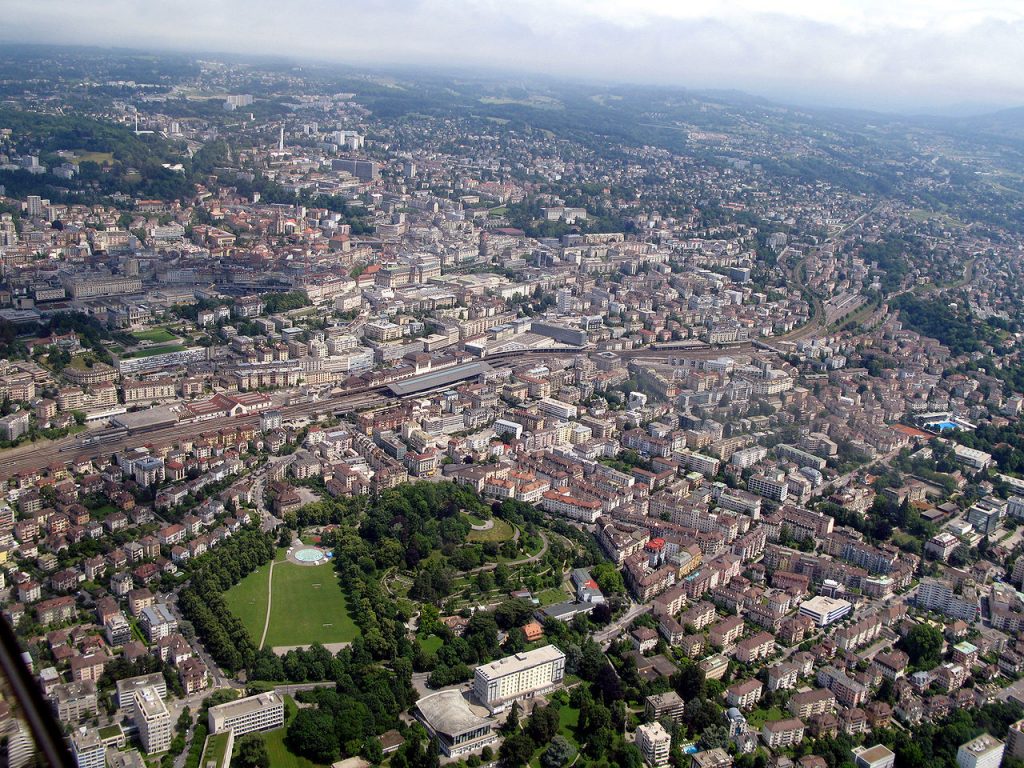
The Jewish presence in Lausanne is attested continuously from 1848 onwards, when several families met in a rented room. In 1895, the community had 41 members. In 1909, there were 110 members. It should be noted that the vast majority of Jews did not participate in community life. In 1909, there were 989 people of the Jewish faith in Lausanne. Kosher meat was imported from Evian because of the laws on slaughter.
An oratory was inaugurated in the ruelle du Grand-Pont in 1878. A prayer room was used from 1884 on rue du Petit-Saint-Jean. In 1898, a synagogue was built in rue du Grand-Chêne. In this impetus, Lausanne’s synagogue , was built in 1910 in a fairly remote neighborhood at the time. It can be found today right near the train station in the heart of the city.
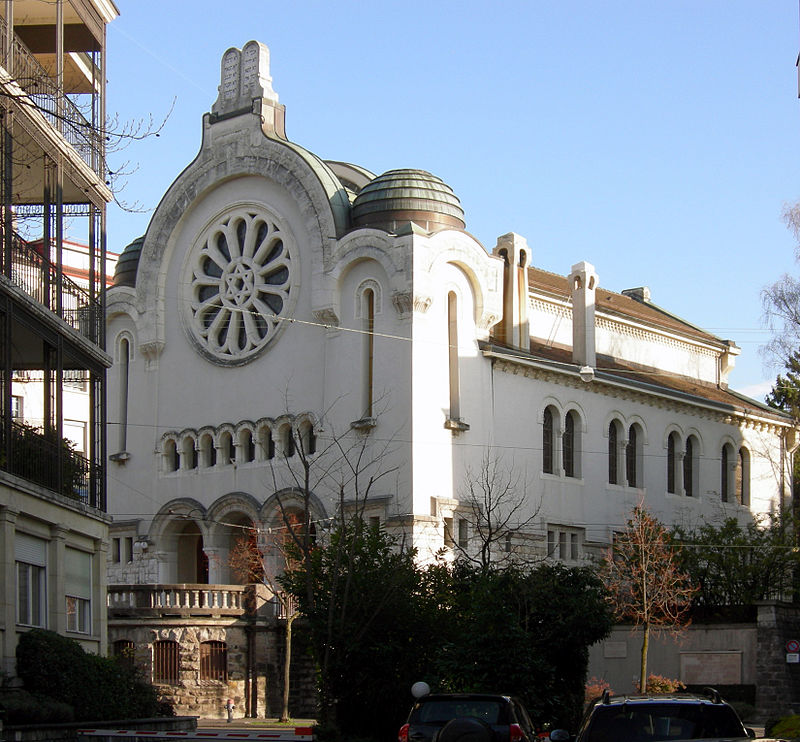
Its Romano-Byzantine style is reminiscent of the synagogue located on rue Buffault in Paris: Tablets of the Law dominate its facade, which contains a rose window shaped like a Star of David; it also features semicircular window arches, Romanesque apses, and two towers. The interior is Neo-Byzantine. The Community Center is adorned with stained-glass windows by Jean Prahin.
There are two cemeteries that are used by the Jews of Lausanne: Cery , Prilly and another one further in Vassin . The one in Prilly dates from the beginning of the 20th century, when the cemetery used until then in Montoie reached saturation. The graves in Montoie were transferred to Prilly in 1950. A second cemetery was created in Prilly in 2002.
Jewish life in Lausanne experienced a boom from the 1970s onward, particularly thanks to the arrival of Sephardic Jews. Religious services became more regular, and a school group was created. In 1975, the first Bulletin of the Jewish Community of Lausanne was published.
In 2010, the 100th anniversary of the Lausanne synagogue was celebrated.
Before Jews were able to settle in Geneva, the neighboring city of Carouge (at the time part of the Kingdom of Sardinia) opened its doors to them around 1779. The sole remaining Jewish vestige is the old cemetery, which was restored in 1996.

A great spirit of religious tolerance allowed this arrival at the time, while in Geneva the Jews had been expelled since 1490. The acceptance of Geneva’s Jews was only concretely achieved at the end of the 19th century, in 1874 to be precise, the date of emancipation at the federal level.
The new cemetery, in the Franco-Swiss border town of Veyrier, contains the graves of numerous luminaries, such as the writer Albert Cohen.
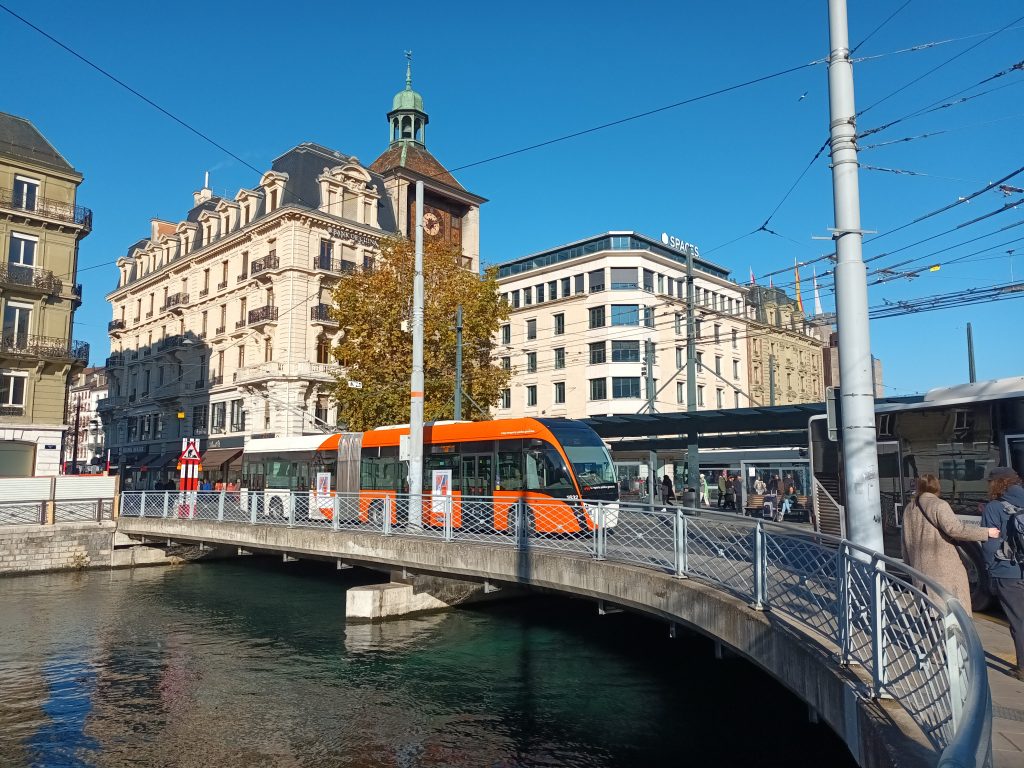
The city of banking and watchmaking… but not only. Geneva is a much more complex city, home to a great university and eminent thinkers for centuries, and it even published one of the first two comic strips in history.

It seems that the Jewish presence in Geneva dates from the 13th century, mainly around the Place du Grand-Mézel in the old town. The Jews were expelled from the city in 1490 and forbidden to stay there until the 19th century.

The Grand-Mézel was the oldest closed Jewish quarter in Europe, established in 1428 (88 years before the Venice ghetto). The old town is situated on a small hill, with the shopping streets on one side and the university and cultural buildings on the other. Coming down from the Grand-Mézel, 200m away you will find the historic synagogue of Geneva.
Reestablished in 1852 by Alsatian Jews, the Jewish community of Geneva was offered a plot of land by the city to build a synagogue as a sign of tolerance toward non-Protestant minorities.

Located at the Place de la Synagogue and combining eastern style with Polish characteristics, the Beth Yaacov Synagogue was returned to its original colors in 1997: designed in 1857 by Jean-Henri Bachofen, it features a gray and pink-striped facade, four crenellated turrets crowned by domes, and a central dome topped with the Tablets of the Law. The interior (arches and dome) is predominantly light blue, while the stained-glass windows and paneling add to the vividness of the colors.
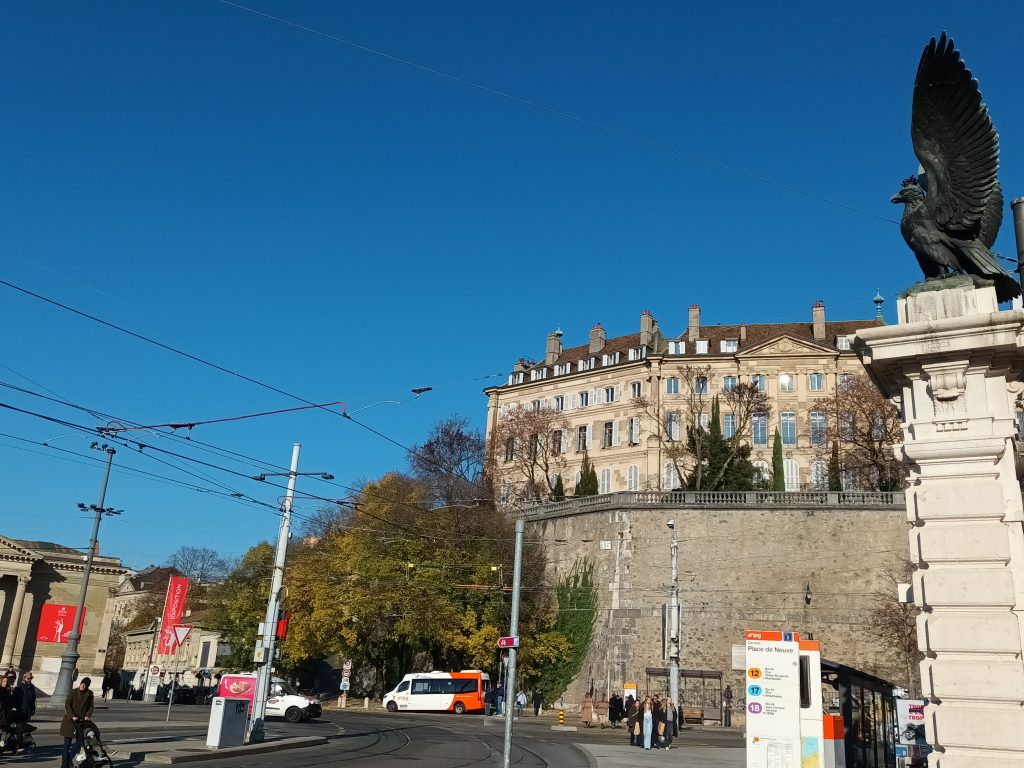
The University of Geneva was established by Jean Calvin in 1559. The urgent need to fill lecture halls in the 19th century unexpectedly benefited from the political upheavals in Eastern Europe. The very reactionary period of the Russian Empire forced many students to leave the country and find places at Western universities. This was especially motivating for women, who found free access to Geneva universities, a rare event at the time. Thus, Jews from the East, often from very modest conditions, made up more than half of the students in Geneva. Among them, Lina Stern, a world specialist in the brain and the first woman professor at the University of Geneva. But also Chaïm Weizmann, the future first president of Israel, who taught chemistry there and founded a publishing house. There he developed with other students the idea of what would become the Hebrew University of Jerusalem. As well as many Zionist, communist and Bundist figures.

In the spirit of reconciling studies and manual labour, Aron Syngalowski established in 1943 in Geneva the provisional headquarters of the ORT (Organisation – Reconstruction – Labour), founded in 1880 in Russia to help needy Jews. This world headquarters remained in Switzerland until 1980.
The Heikhal Haness Synagogue , serving the Sephardic Jewish community, was built in 1970. This marble construction was needed in answer to changes in Geneva’s community, as Mediterranean Jews have now become the majority.
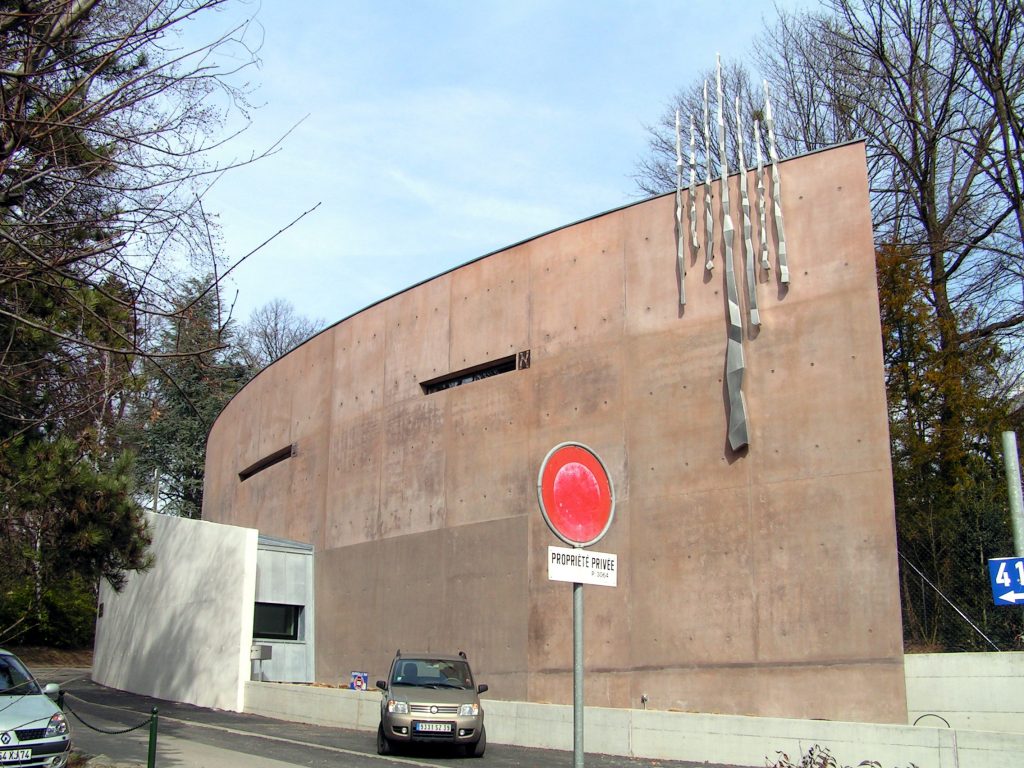
The Liberal Jewish Community of Geneva – GIL created by Rabbi François Garaï in 1970, gathers today about a third of Geneva’s Jews. It was the first synagogue in the French speaking world to enable girls to read the Torah during their bat-mitsvah.
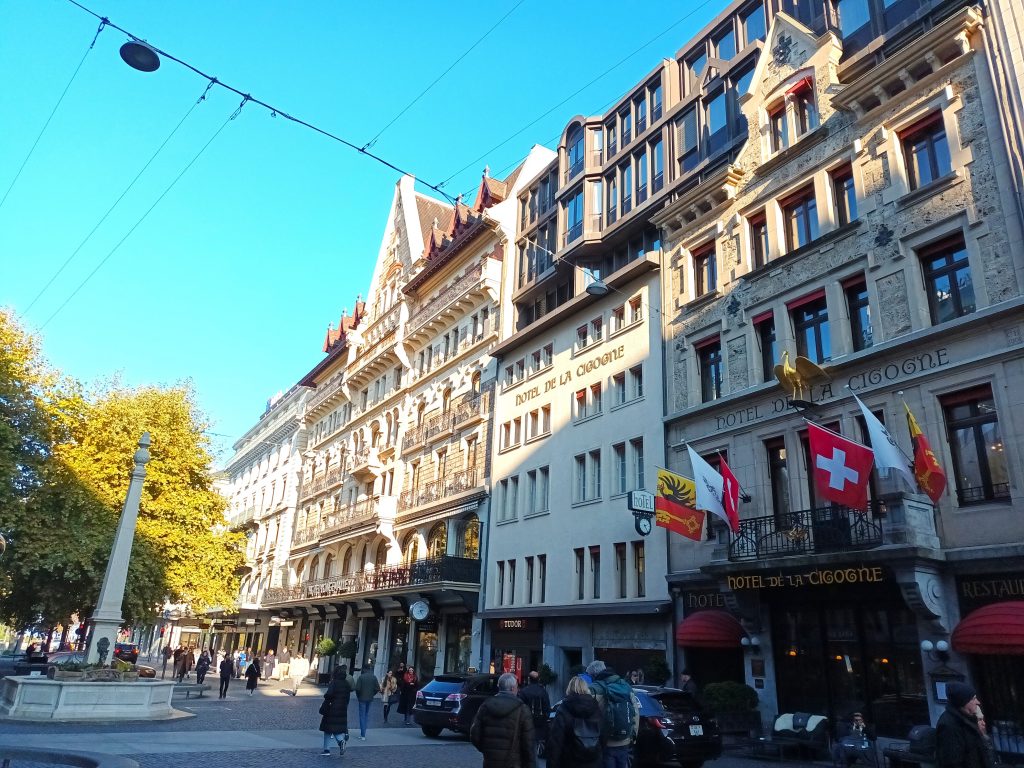
City known over the world for its diplomatic summits, Geneva inspired many writers, among them Romain Gary and Albert Cohen, diplomats themselves. A wonderful tribute to the city is shared in Albert Cohen’s novel Mangeclous when the Solal cousins stroll around the sights and parks and turn the UN upside down.
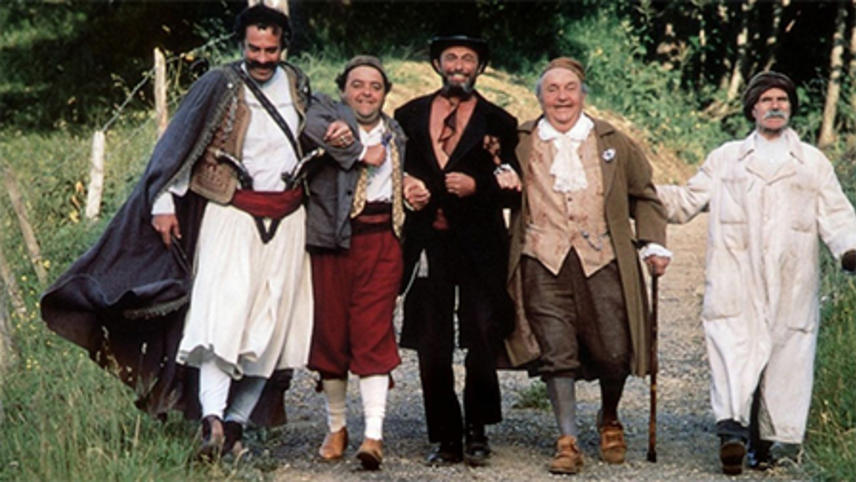
Albert Cohen arrives in Geneva to pursue his studies. He became a Swiss citizen and was admitted to the Geneva bar. Following his elaboration of the passport for displaced persons, he will return to the city in 1947 to head the Protection Division of the IRO. Geneva will be the city where Cohen’s work confronts generations and discomforts between them. First of all, between him and his mother, who, like his character Solal, is ashamed of her origins and the characters who represent her too “loudly”. He will cry for these moments of shame in The Book of My Mother and will mock his own attitude in Mangeclous, the main character of this novel and who bears the same name causing a great commotion in the city and the highest UN authorities, by setting himself up as an emissary of the creation of the State of Israel.

The Community Center houses the Jewish main library, rich in several high quality scientific and artistic collections, as well as the Jardin Rose (Rose Garden) and a kosher restaurant. The Jewish Community Center also organizes many cultural events.
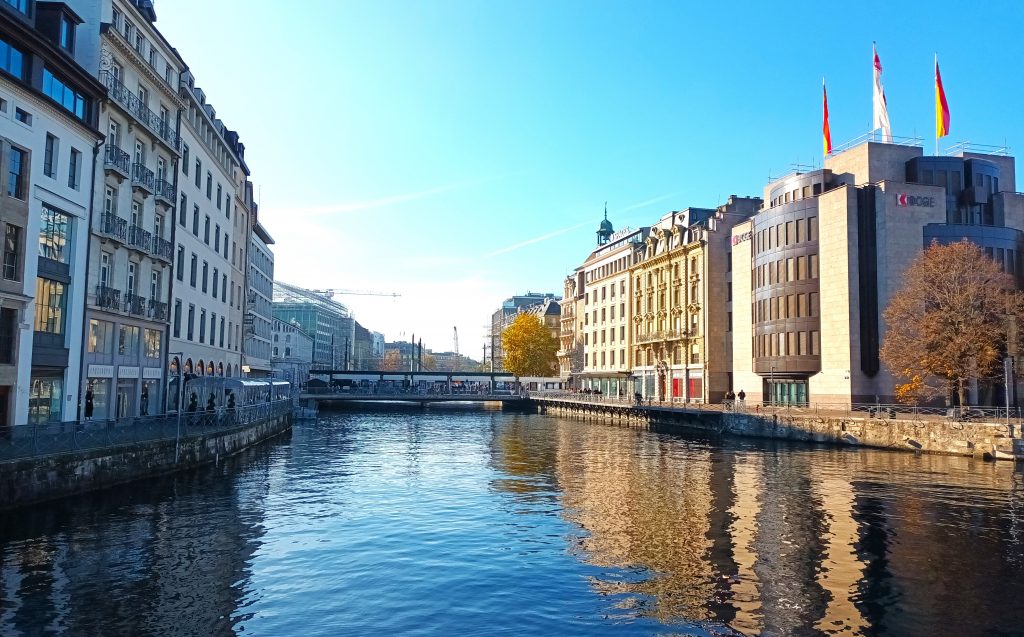
The Jewish population in 1900 consisted of 1100 people. In 2024, estimates suggest that there will be 6000.
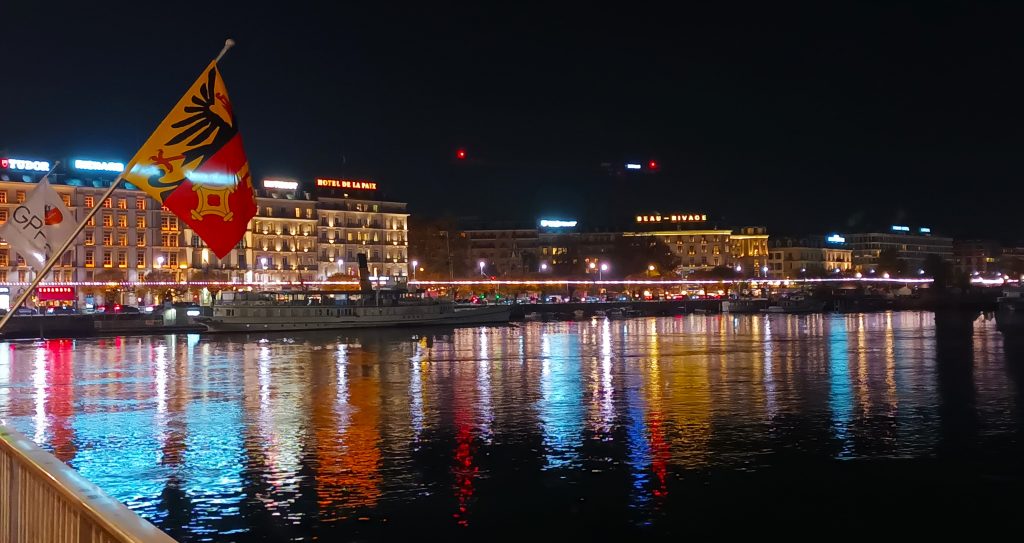
Here’s our interview with Rabbi Éric Ackermann, during our visit to the beautiful and ancient Beth-Yaacov Synagogue.
Jguideeurope: How long have you been rabbi of the Beth Yaacov Synagogue?
Éric Ackermann: I’m not the rabbi of the synagogue; I’m a rabbi at the synagogue. In fact, there are several rabbis in Geneva, and I joined the Beth-Yaacov team, the oldest of whom, Rabbi Jacob Tolédano, is the mainstay of the synagogue. Rabbi and cantor for over 50 years, he delights the faithful with one of the most beautiful voices in Europe. That said, I’ve been in this synagogue for almost 20 years.
Given its age and its important place in Geneva Judaism, have you noticed a growing desire on the part of new generations to continue the celebrations here?
It’s the oldest Geneva synagogue still standing, dating from before the emancipation of the Jews. Today, an ever-growing number of worshippers want to perpetuate their family celebrations here, from circumcision to weddings and other anniversaries and ceremonies.
What religious and cultural activities does the synagogue organise?
As I mentioned earlier, the synagogue’s religious life is marked by numerous CIG ceremonies, as well as interfaith meetings, training courses and visits to Geneva schools. On the cultural front, there are numerous courses, debates and conferences. There’s no shortage of community festivals and events. Don’t hesitate to visit the community website: comisra.ch
You are very involved in Jewish-Christian dialogue. How do you see it developing in Switzerland?
I think that since the Second Vatican Council, trust and respect have been established, and dialogue has been able to strengthen and flourish. In fact, in 2018 I was awarded the Swiss Dialogue Prize by the FSCI for my work with the Geneva Interfaith Platform, of which I was president for 7 years. Its development contributes to ‘living together’ and therefore remains generous. In short, dialogue with other communities is an exercise in the times in which we live.
The history of the Jews in Speyer dates back more than 1,000 years. In the Middle Ages, the city of Speyer (formerly Spira) was home to one of the largest Jewish communities in the Holy Roman Empire. Its importance is attested to by the frequency of the Ashkenazi Jewish surname Shapiro/Shapira and its variants Szpira/Spiro/Speyer. The community was completely wiped out in 1940 during the Holocaust. With the fall of the Iron Curtain in 1989, Jews resettled in Speyer and a first minyan was held in 1996.
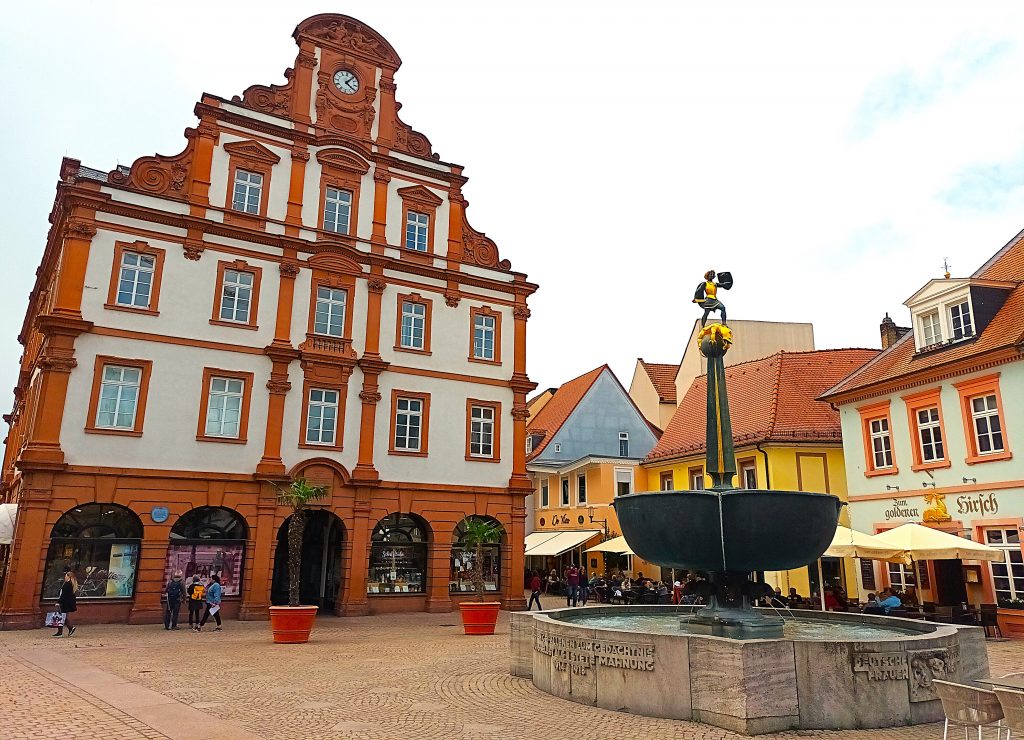
A rich history
The first evidence of a Jewish community in Speyer dates back to the 1070s. It came from the famous Kalonymos family of Mainz, who had emigrated from Italy a century earlier. Other Jews from Mainz may also have settled in Speyer at the same time.
The history of the Speyer community began in 1084, when Jews fleeing pogroms in Mainz and Worms took refuge with their relatives in Speyer. They were certainly encouraged to do so by Bishop Rüdiger Huzmann (1073-1090), who allowed a large number of Jews to live in his city with the consent of Emperor Henry IV. In his charter (Freiheitsbrief) for the Jews, the bishop approved the establishment of the community in a defined area.
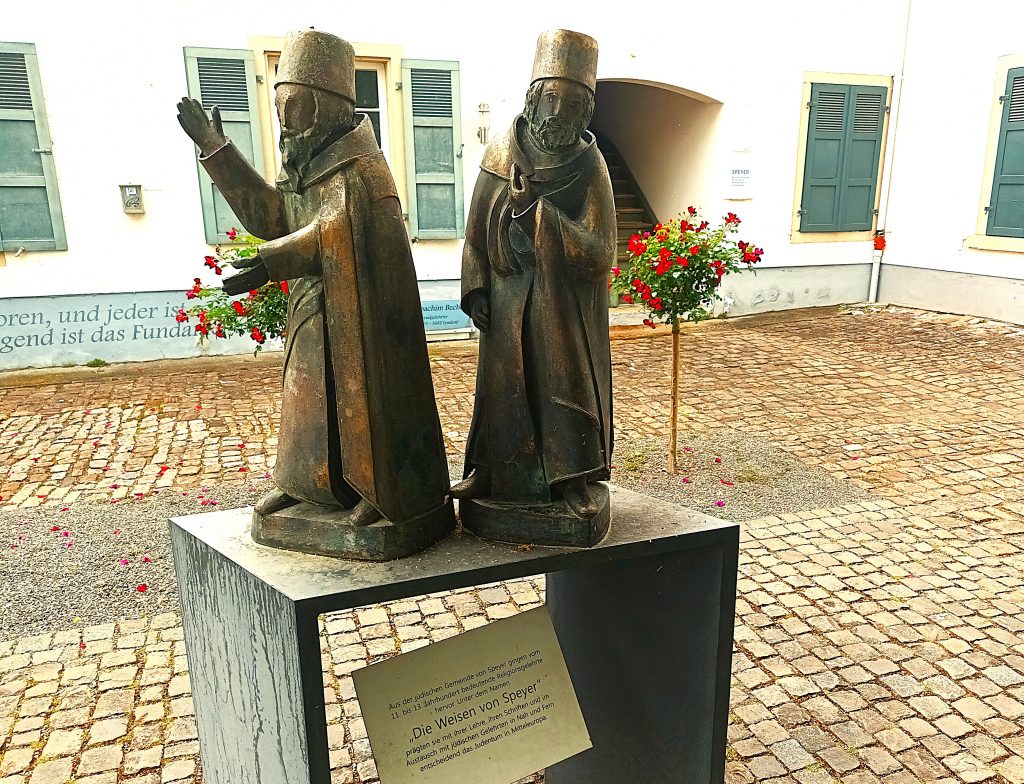
This area corresponds to the former suburb of Altspeyer in the area east of today’s railway station. This fortified quarter was located to the north, outside the city walls, and was the city’s first documented ghetto.
The charter ratified by Bishop Huzmann went far beyond the practice elsewhere in the empire. The Jews of Speyer were allowed to engage in all kinds of trade, exchange gold and silver, own land, have their own laws, judicial and administrative systems, employ non-Jews as servants, and were not required to pay customs duties at the city limits.
The two charters
The reason why Jews were called to Speyer by the bishop was their important role in fiduciary and commercial trade, and in particular their links with distant regions. Large-scale financiers were needed for the construction of the cathedral. A special feature of Speyer is that the rights and privileges specially granted to the Jews of this city were eventually extended to all Jews in the empire.

The two charters of 1084 and 1090 marked the beginning of the ‘golden age’ of the Jews in Speyer, which, with restrictions, was to last until the 13th or 14th century. According to these documents, an “Archisynagogos”, also called ‘Jewish bishop’, presided over the administration and the community court. He was elected by the community and ‘knighted’ by the bishop. Later sources mention a ‘Jewish council’ of twelve members, presided over by the ‘Jewish bishop’, who represented the community outside. In 1333 and 1344, the authority of the Jewish council was ratified by the municipal council of Speyer.
In 1096, the Jews of Speyer were among the first to be affected by the pogroms caused by the plague epidemic, but compared to the communities of Worms and Mainz, which followed a few days later, they were relatively spared.
Development of Jewish life
Around this time, a second Jewish quarter was established near the cathedral, along Kleine Pfaffengasse, which was formerly Judengasse (Jewish Street), while the old Jewish quarter and its synagogue remained in Altspeyer. It is estimated that the Jewish community in Speyer at that time consisted of 300 to 400 people.

During these years, the Jewish community in Speyer became one of the largest in the Holy Roman Empire. It was an important centre for Torah study and, despite pogroms, persecution and expulsions, had a considerable influence on the general spiritual and cultural life of the city. At a synod of rabbis in Troyes around 1150, the leadership of the German Jewish community was transferred to the communities of Speyer, Worms and Mainz.
Intellectual and religious development
The three communities formed a federation called ‘ShUM’ (שום: initials of the Hebrew names of the three cities) and retained this power until the middle of the 13th century. The SHUM cities had their own rites and were recognised as a central authority in legal and religious matters. Speyer had renowned Jewish schools and a well-attended yeshiva.
Due to the high esteem in which the three ShUM cities were held in the Middle Ages, they were praised as a ‘Rhenish Jerusalem’. These cities had a considerable influence on the development of European Ashkenazi culture. In the 13th century, Isaac ben Moses Or Sarua of Vienna wrote: ‘From our teachers in Mainz, Worms and Speyer, the teachings have spread to all of Israel …’.
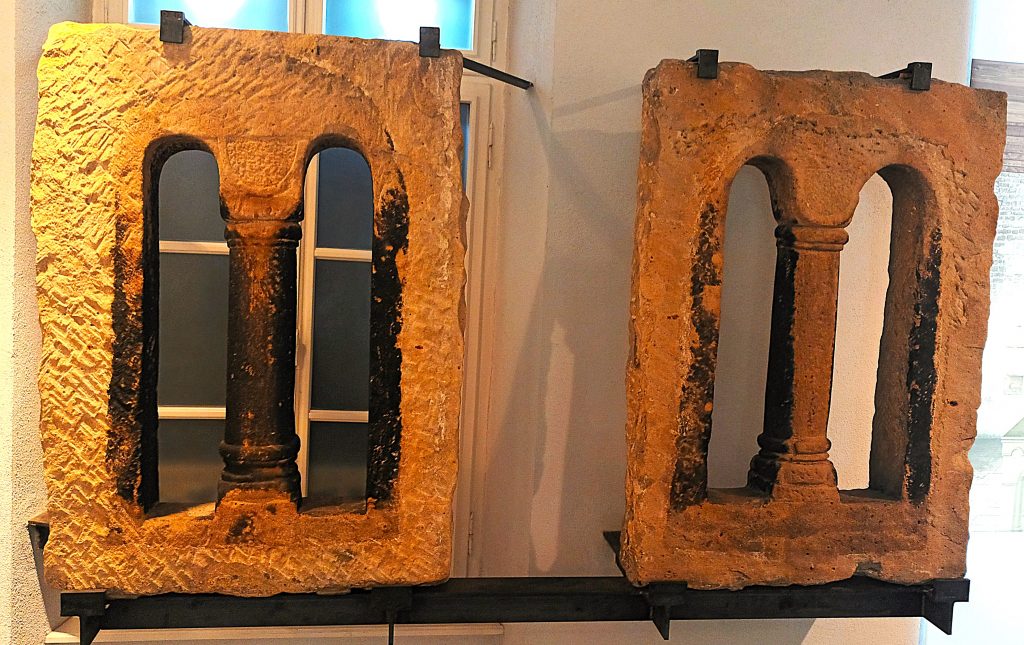
However, even during this flourishing period, anti-Semitic violence broke out in 1146, 1195, 1282 and 1343. In 1349, during the Black Death, the Jewish community of Speyer was completely wiped out. In the years that followed, a small community re-established itself, but never regained the size and status it had before 1349. The Jews were expelled from Speyer from 1405 to 1421, then ‘for eternity’ in 1435. One of the refugees from Speyer was Moses Mentzlav, whose son, Israel Nathan, founded the famous Hebrew printing press in Soncino, Italy.
Return of the Jews to Speyer
From 1621 to 1688, Jews resettled in Speyer. It was mainly during the Thirty Years’ War and the years that followed that the indebted towns called on the financial power of the community. The city began borrowing money from Jews as early as 1629. However, following complaints, trade and financial transactions with Jews were completely banned before Speyer was burned down by the French in 1689. During the subsequent years of reconstruction, Jews were not allowed to resettle permanently.
A Jewish community established itself in Speyer after the French Revolution. It was distinguished by its liberal and emancipated attitudes, which repeatedly brought it into conflict with the more conservative Jewish communities in the Rhine region. In 1828, the community founded a charitable organisation and contributed to the city council’s efforts to combat extreme poverty in the city. In 1830, the Jewish community in Speyer had 209 members. In 1837, a new synagogue was built on the site of the former St. James Church on Heydenreichstraße; the synagogue included a small school.
Rise of anti-Semitism
In 1890, the Jewish community had 535 members, the largest number ever recorded in Speyer; by 1910, their number had fallen to 403. In the early 1930s, Jews in Speyer began to leave for larger cities or emigrate due to rising anti-Semitism.

By 1933, the number of Jews in Speyer had fallen to 269, and by the time their synagogue was burned down during Kristallnacht, only 81 remained. On the night of 9 November, SA and SS troops ransacked the synagogue on Heydenreichstraße, carrying off the library, valuable fabrics, carpets and ritual utensils, and set fire to the building. Along with the synagogue, the Jews also lost their school. That same night, the Jewish cemetery was vandalised. A member of the community set up a prayer room in his house on Herdstraße. The city then used this house as a storage place for furniture stolen from deported Jews.
On 22 October 1940, 51 of the 60 Jews remaining in Speyer were deported to the Gurs internment camp in southern France.
Some of them managed to flee to Switzerland, the United States and South Africa with the help of the local population, while the others were deported to Auschwitz. Hidden in Speyer, only one Jew survived the Nazi era.
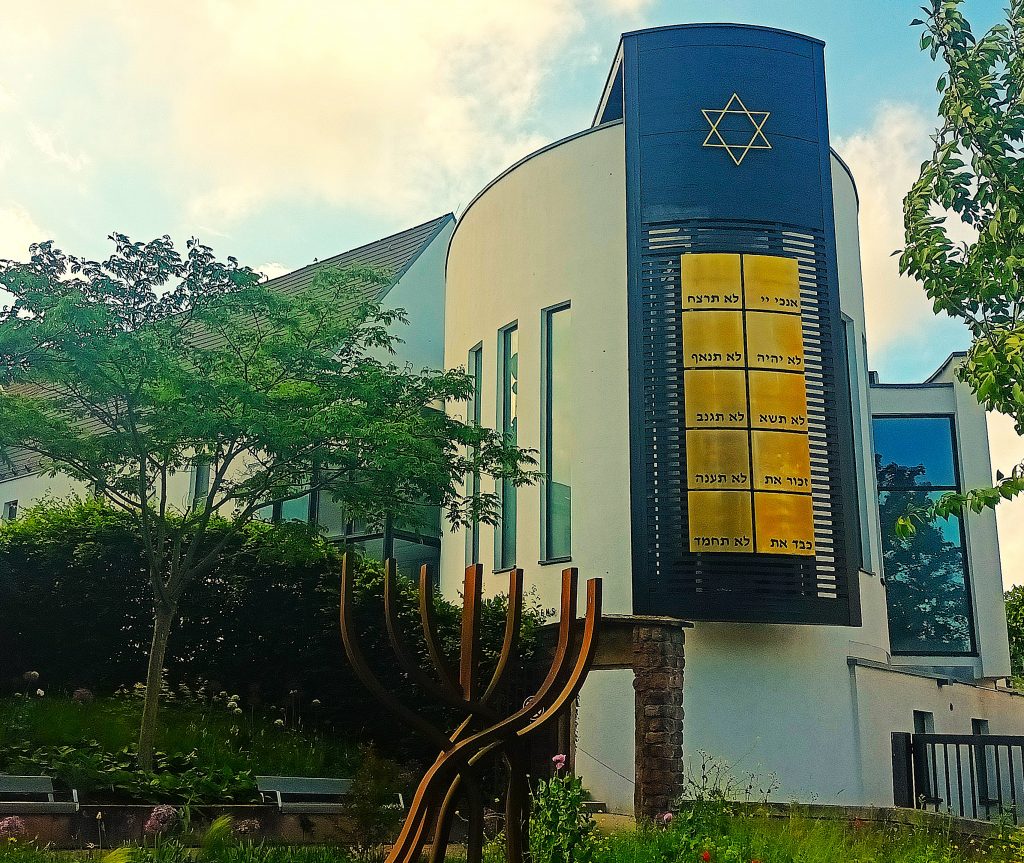
In the 1990s, it was decided to build a new synagogue as an extension of the former medieval church of St. Guido. The Beith Shalom Synagogue was consecrated on 9 November 2011. It also houses a community centre.
The medieval Jewish cemetery of Speyer lay opposite the Judenturm (Jews’ tower) to the west of the former Jews’ quarter in Altspeyer (today between Bahnhofstraße and Wormer Landstraße).
After Jews resettled in Speyer in the 19th century, a new cemetery was built at St. Klara Klosterweg and remained in use until 1888. The former mortuary and a part of the western wall are still in place. In 1888, the Jewish cemetery was moved to the new city cemetery built in the north of Speyer along Wormser Landstraße, where it now occupies the southeastern section.
How to get there
When you leave Speyer railway station on Banhoferstrasse, you will find yourself in Adenauer Park. Named in honour of former German Chancellor Konrad Adenauer, it is the site of the grave of another former chancellor, Helmut Kohl.

After crossing this pretty little park, you will come to St.-Guido-Stiffts Platz. Don’t be surprised to find a sign in two languages, German on one side and Hebrew on the other, indicating the location of the Kikar Yavne . This square is named in honour of the Israeli city of Yavne, with which Speyer has been twinned since 1998.
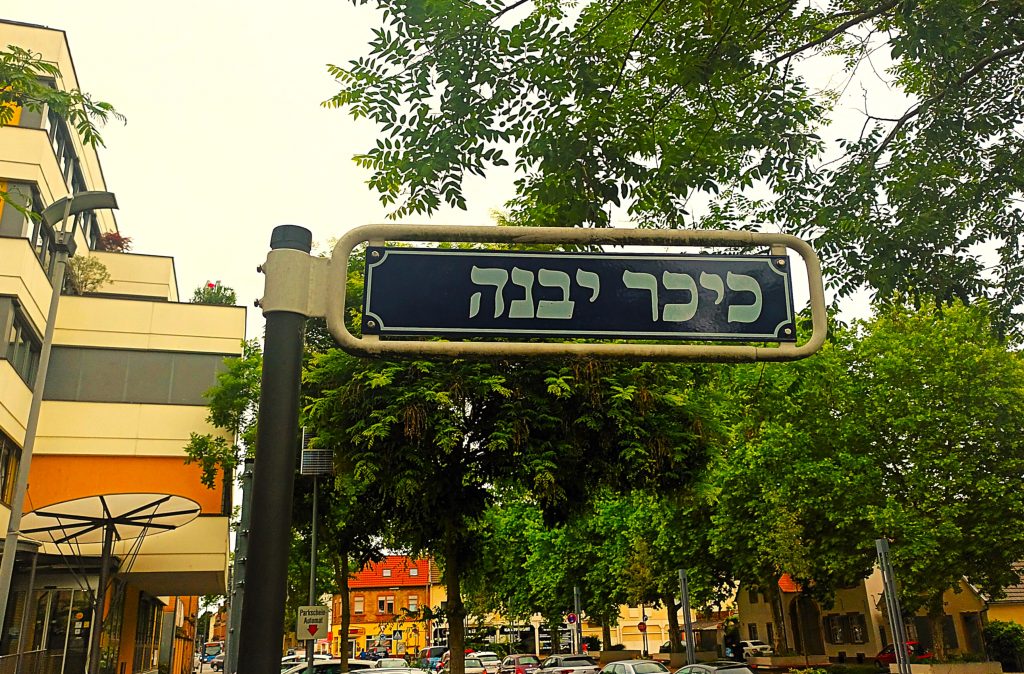
Take the small alleyway called Weidenberg and you will come to a pretty little park full of flowers, where you will see a metal menorah sculpture and, just behind it, Speyer’s Beit Shalom synagogue .
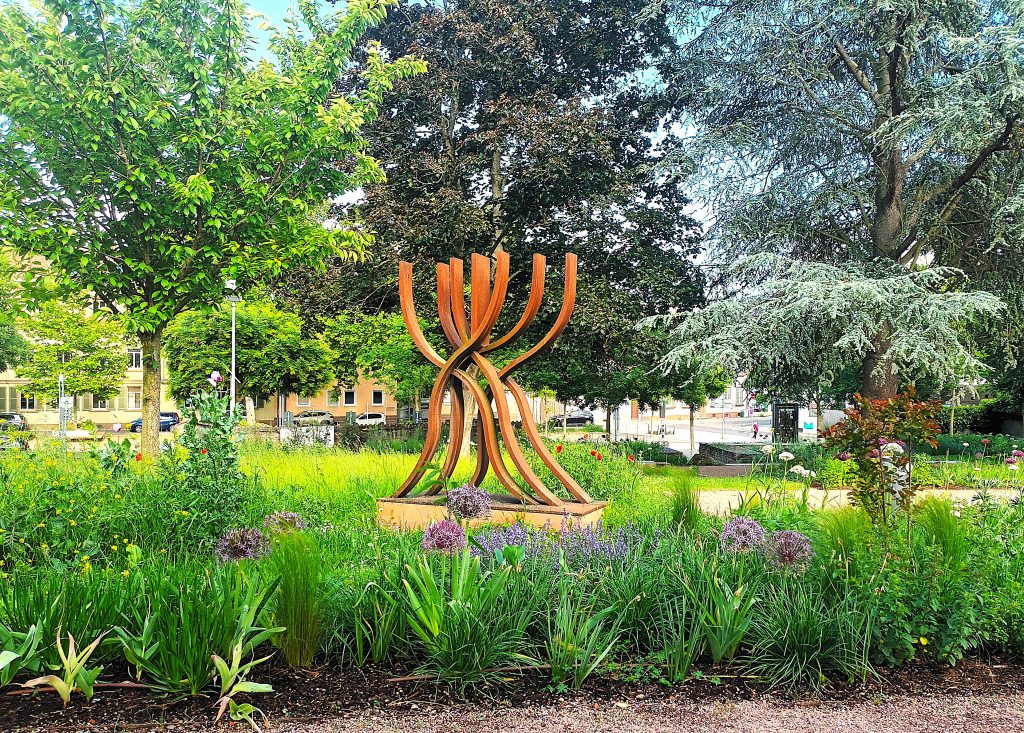
Next, walk down Wormser Strasse and the adjacent narrow streets with their colourful houses and lush vegetation to reach the heart of the old town. Stolpersteine have been placed opposite number 9 on the street.
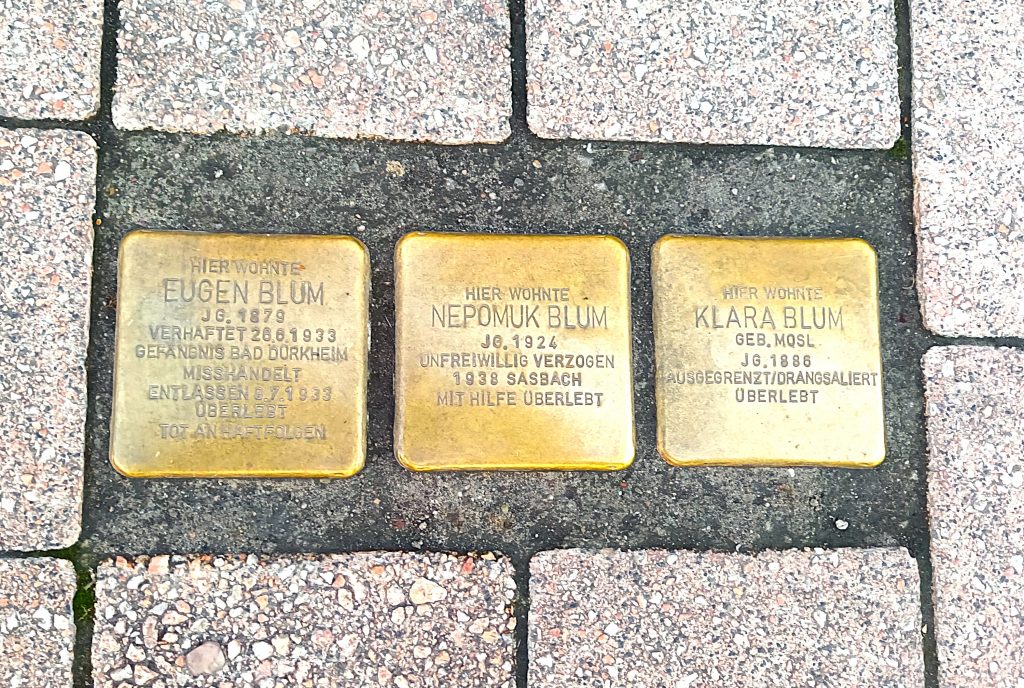
At the end of this street is the unmissable Maximilian Strasse. On the right, you can see one of the city’s most famous monuments, the Altpörtel, a 55-metre-high medieval gate built in the 13th century.
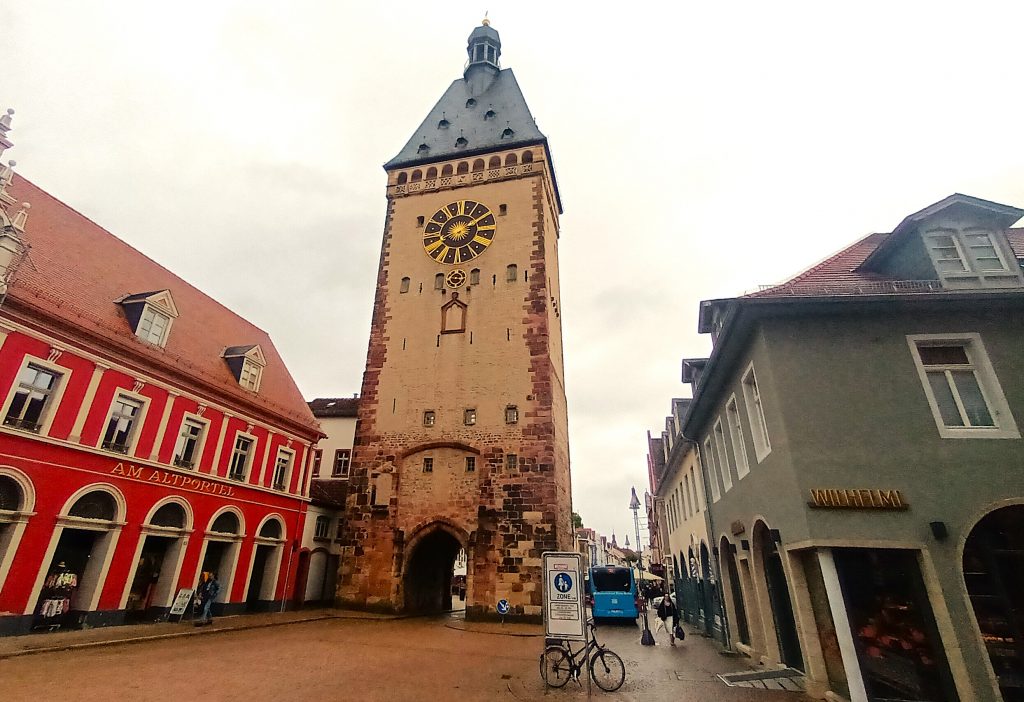
Maximilian Strasse is the main shopping street in the old town. It connects the main ancient monuments from the Altpörtel to Speyer Cathedral. Opposite the beginning of Wormser Strasse, 50 metres from the Altpörtel, is the Galeria Speyer, a large department store located on the site of the synagogue destroyed during Kristallnacht .
If you take the Karlsgasse alleyway that runs alongside the store, you will find the Memorial erected in 1992 in honour of the Jews of Speyer who were deported during the Holocaust.

Then turn left onto Hellergasse, which continues into Kutschergasse, and you will arrive at the small market square. Crossing it diagonally, you will come to Kleine Pfaffengasse , where the Jewish Museum of Speyer, the SchPIRA and its mikveh , is located.
Just before the museum, on your right, you will see Judengasse and Judenbadgasse, named after the Jewish alley and the Jewish ritual bath, respectively.

The SchPIRA is relatively small. It contains a few ancient objects, remnants of the old synagogue and gravestones, which appear to date from the 13th century.
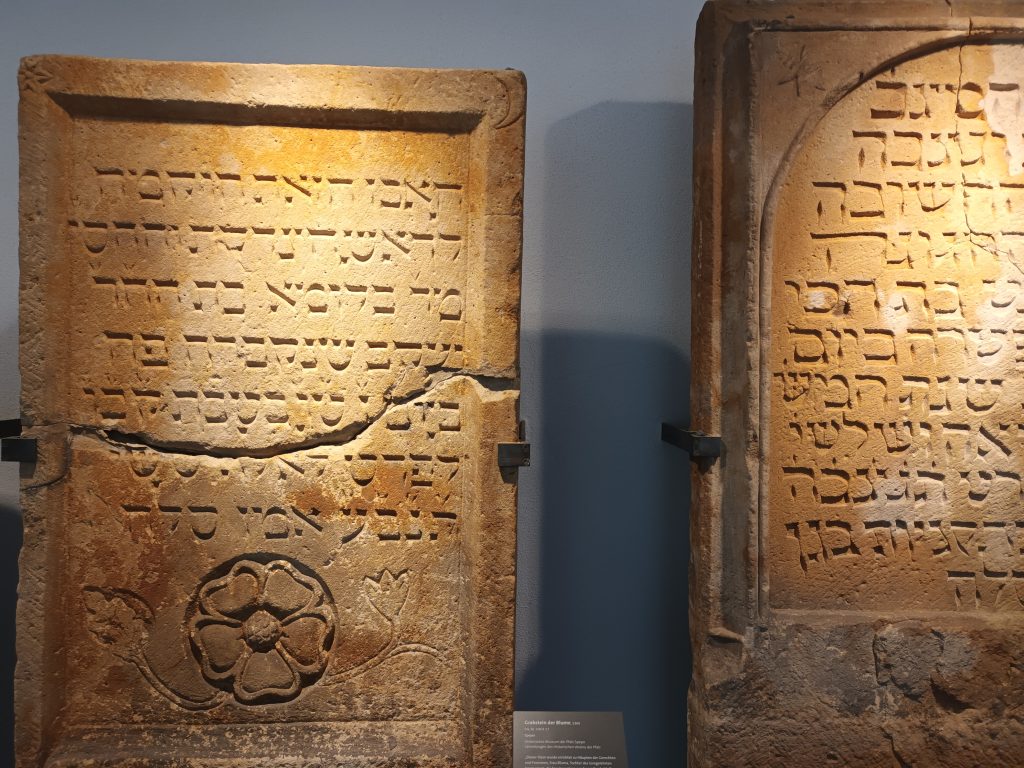
A model of the old mikveh is on display so that visitors can see what it looked like as a whole. On the floor is a map of ancient Speyer.
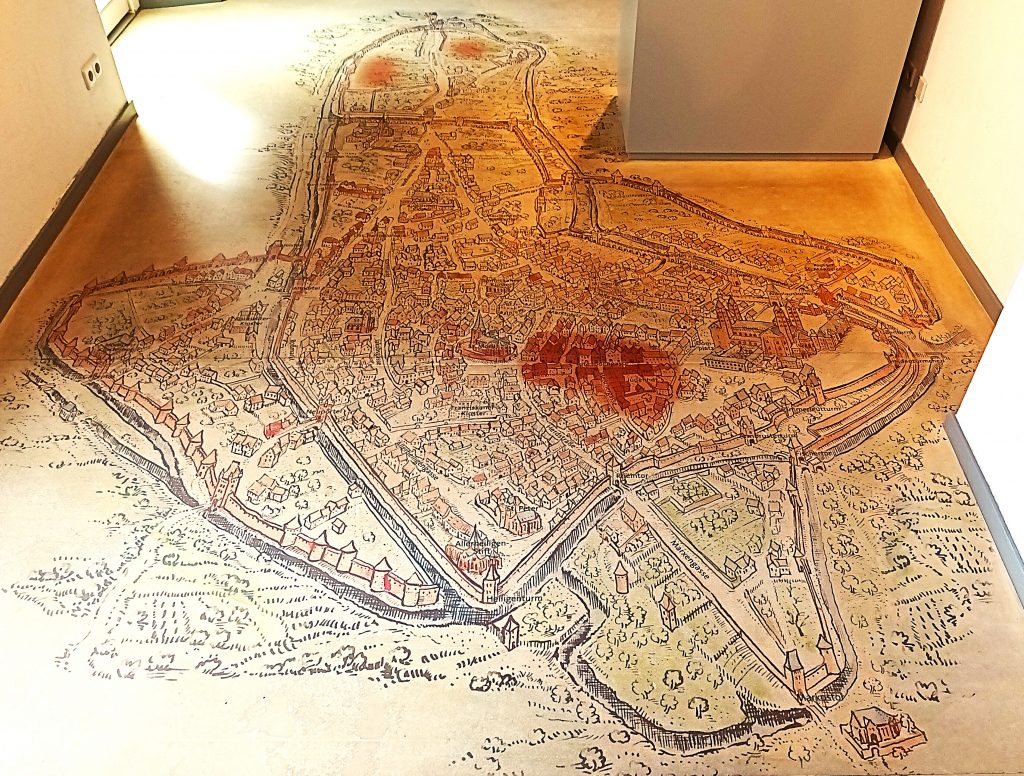
In the next room, a few panels trace the history. Seats allow you to watch presentation videos in German or English at your leisure. Two films are available in English. The first lasts 12 minutes and tells the story of the synagogue, its evolution over time and the necessary (re)constructions. A particularly interesting element in this presentation is the construction of the women’s hall. In some synagogues at the time, women were not just seated behind or above the men, but had their own room. A few windows connected this room to the men’s room so that the women could follow the prayers.
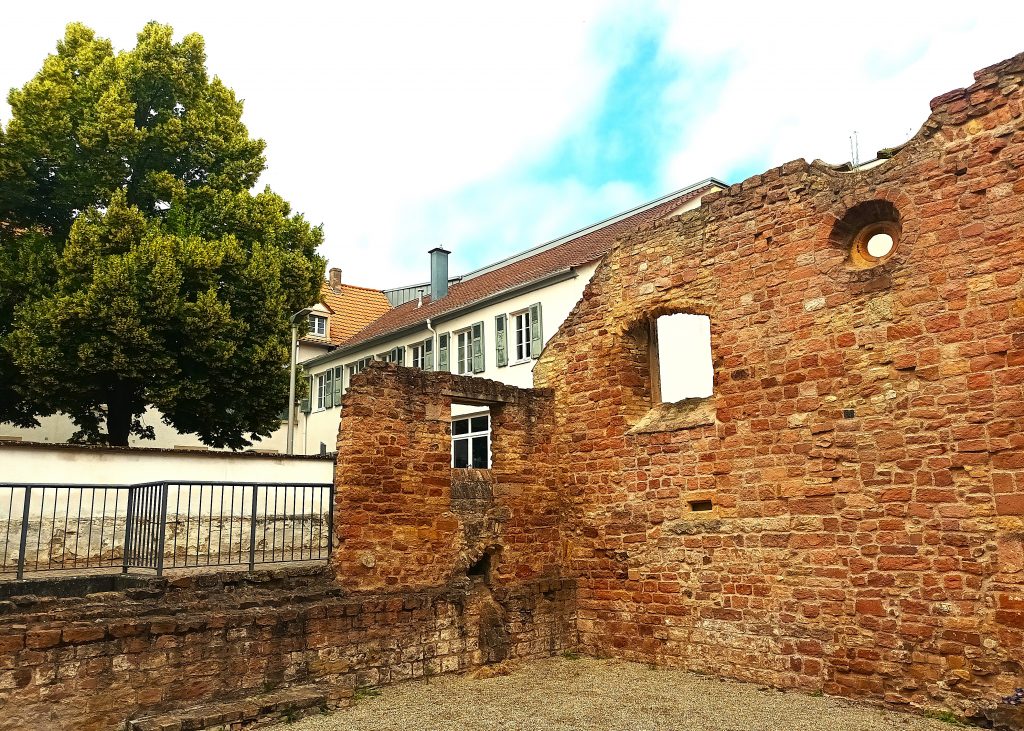
The video shows the architectural evolution of the synagogue and the influential role played by this community at the end of the Middle Ages. It also mentions its destruction, following classic anti-Semitic accusations of poisoning wells, as was the case throughout medieval Europe. The other video is devoted to Jewish rituals, with a view to explaining their meaning to visitors.
In the museum’s small flower-filled garden, you will see a few sculptures, including one entitled ‘The Sages of Speyer’, in memory of all the eminent rabbis who trained and taught there.

Opposite the small inner garden, on the right, you can see the remains of the synagogue with its two rooms. Red and yellow stones bear witness to the architectural evolution of synagogues over time. Some windows connecting the men’s room to the women’s room are still intact. These windows, actually six small openings, were cut into the wall between the two rooms. There was also a connecting door between them, located at the western end of the wall. Benches were positioned around the women’s prayer room. One of them is still preserved today.
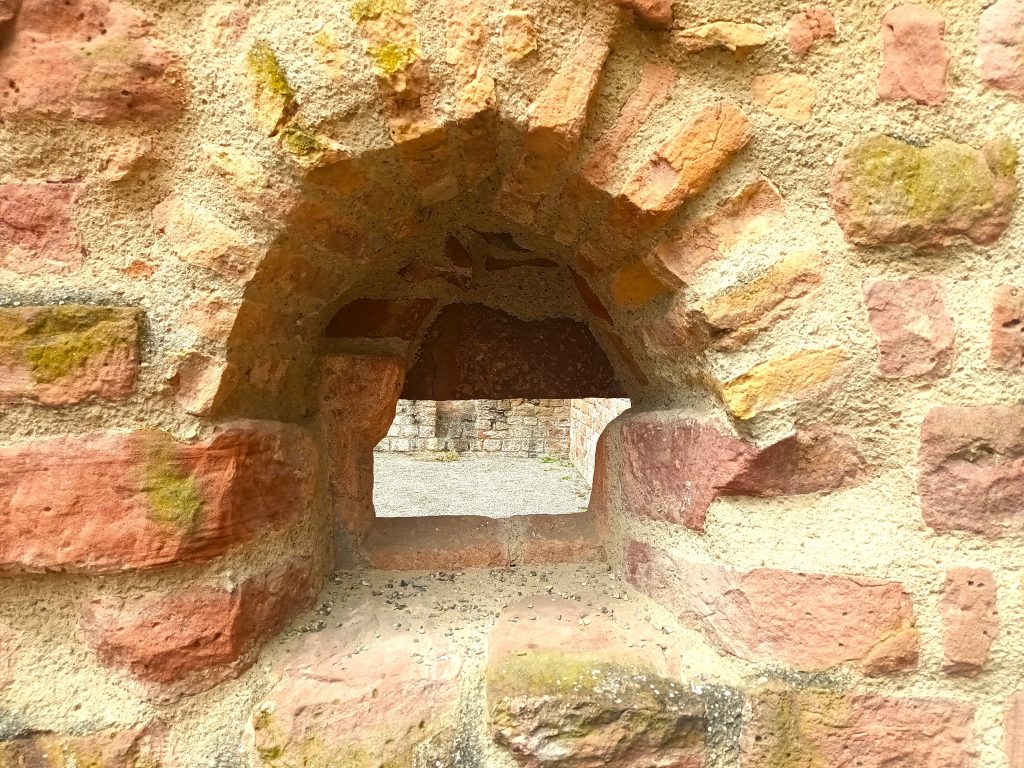
The synagogue, consecrated in 1104, was built as a Romanesque room approximately 10 metres wide and 17 metres long. The place of worship was damaged during the pogrom of 1349 and repaired in 1354 with several modifications to its construction. After the expulsion of the Jews in the early 16th century, the synagogue was converted into a municipal arsenal before finally being demolished.
The first architect to work on the synagogue was not Jewish, as Jews were prohibited from practising certain trades at that time, particularly those related to craftsmanship. In 2025, restoration work was carried out on this former synagogue.
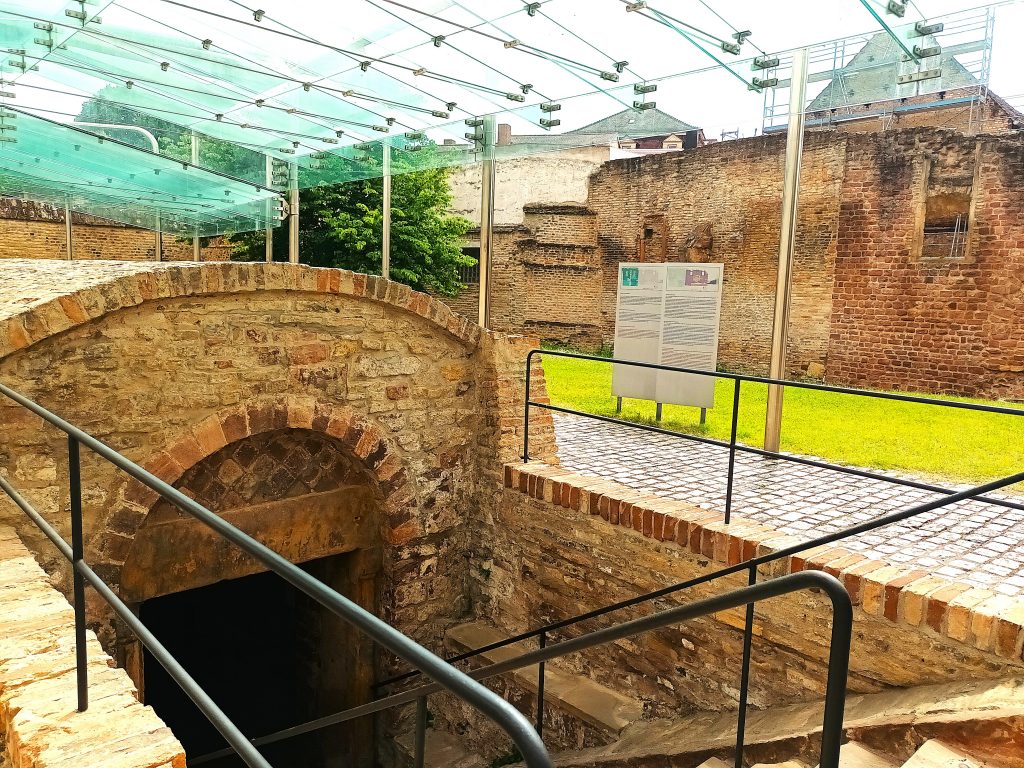
Right next to the remains of the synagogue is the famous Speyer mikveh. The ritual bath fell into disuse in the 16th century, but its ruins are now the oldest visible remains of a mikveh in Central Europe. Today, this European archaeological heritage site has been made accessible to the public and the pool is still fed by groundwater. The first mention of the mikveh dates back to 1128. It was therefore probably built at the same time as the synagogue, at the beginning of the 12th century. It is very well preserved and lit, allowing you to descend to the place where the ritual bath was located, where water still flows abundantly.
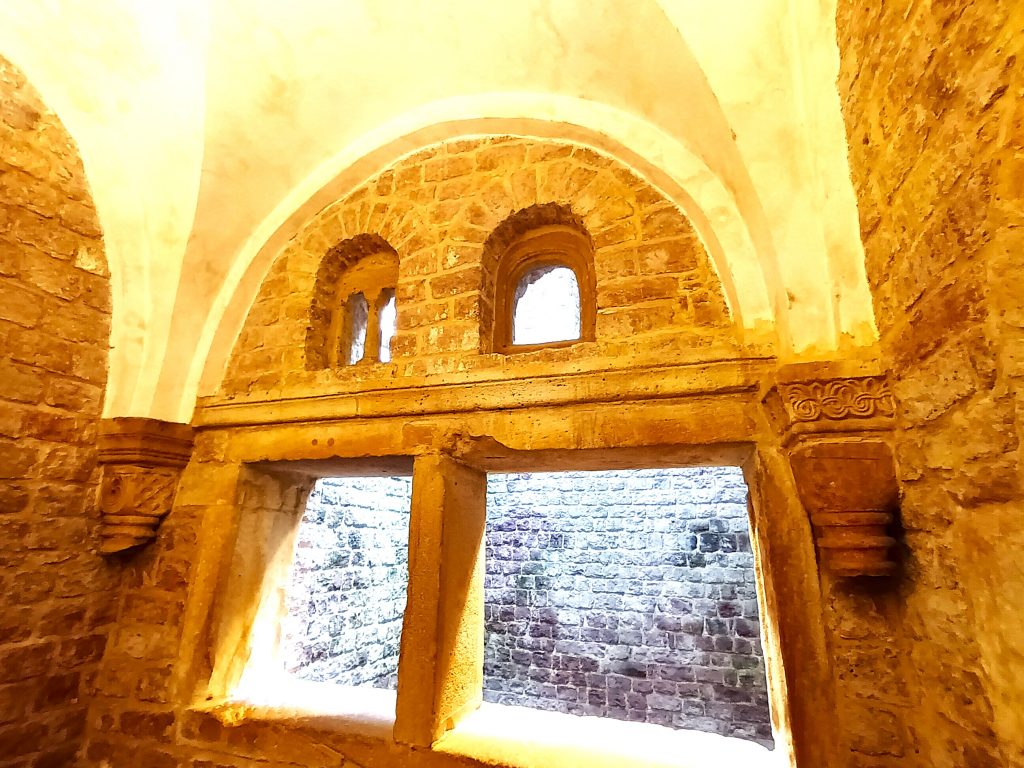
The Speyer mikveh is considered today to be the best preserved in Europe. A barrel-vaulted staircase leads through a vestibule to a square well located 10 metres below ground level. The mikveh is decorated with rich colourful ornamentation from the Romanesque period. A two-part window opens up a view of the basin. The mikveh is now covered with a glass structure to protect it. The bath is no longer officially in use today, but its use can be arranged outside official opening hours for tourists.

All around are explanatory panels about the construction of the mikveh, as well as the chronology of Jewish life and the heyday of the Speyer community, and its contemporary revival.
Leaving the SchPIRA museum, turn right onto Kleine Pfaffengasse and continue for 100 metres to Domplatz, where you will find the beautiful and immense Speyer Cathedral, built from the 11th century onwards under Conrad II.
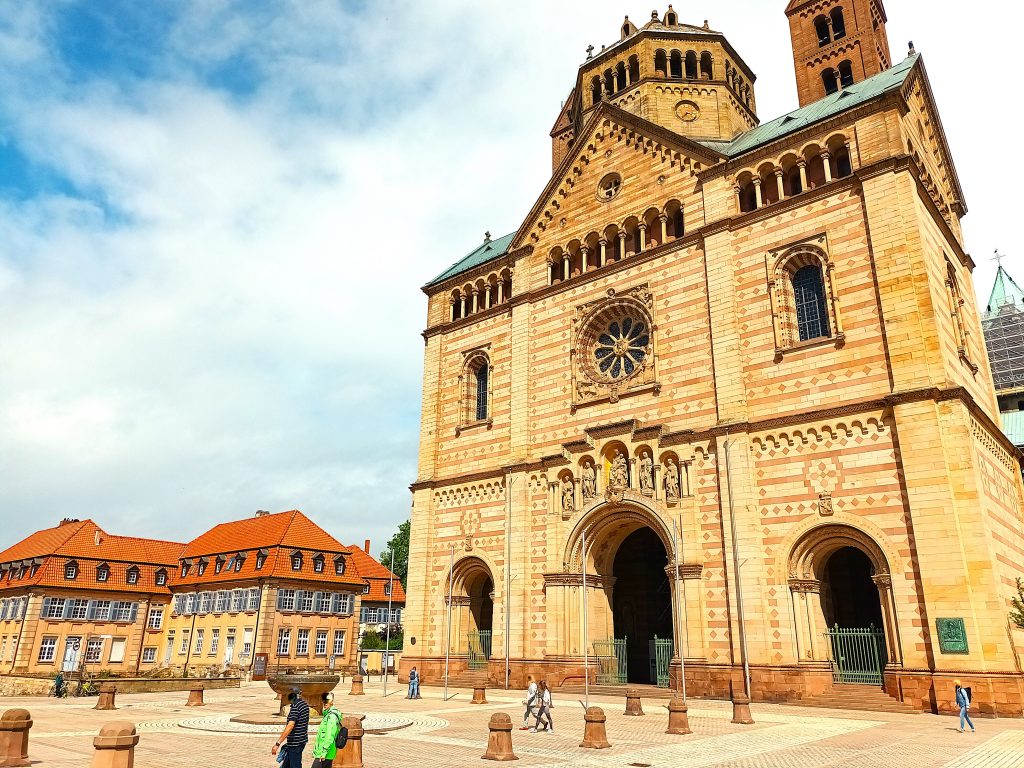
At the entrance, you can see famous scenes from the Bible carved in wrought iron. Inside, as in many German cathedrals, beautiful organs are sometimes played to the delight of visitors. Paintings and statues inside and outside the cathedral pay tribute to the Bible and German rulers.

To round off your walk, we recommend the lovely park just behind the cathedral, where you can see contemporary sculptures and enjoy the peaceful greenery.

As the cultural and municipal services proudly point out, Worms has long been a central city for many religious movements. Thus, within a small area in the heart of its old town, you will find the impressive cathedral, churches, as well as the municipal buildings and the old Jewish quarter with its museum and synagogue.
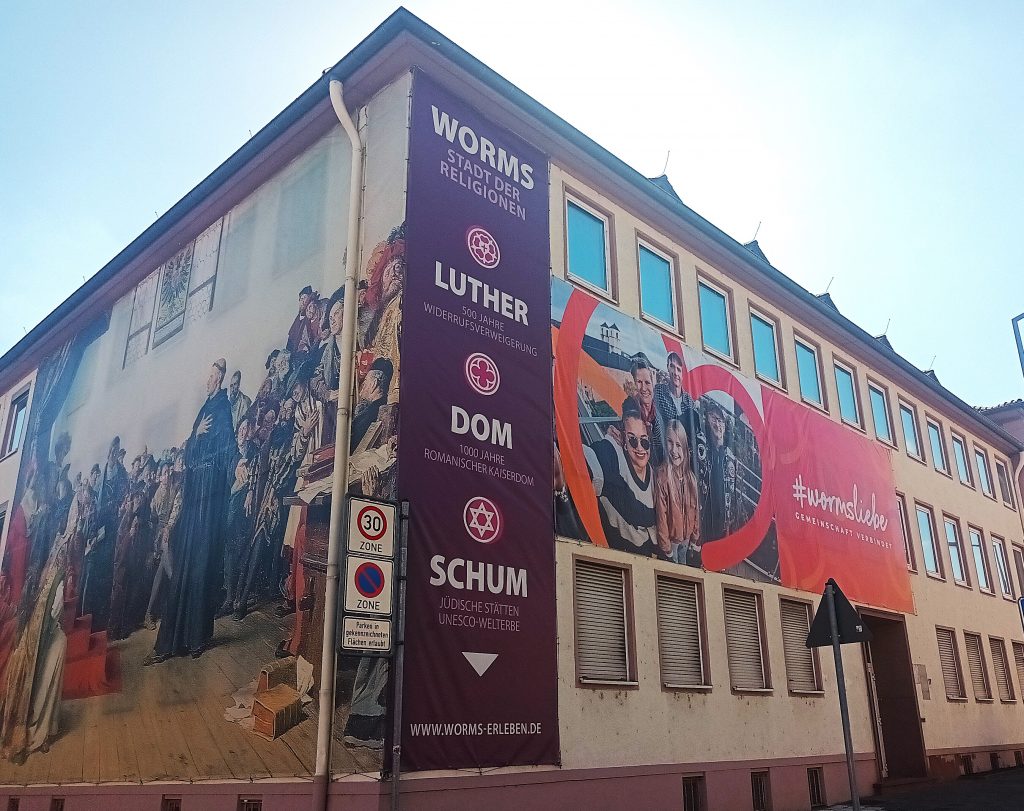
History
The Jewish presence in Worms dates back to the mid-10th century. They were mainly merchants and lived on what is now the Judengasse, meaning ‘Jewish street’.
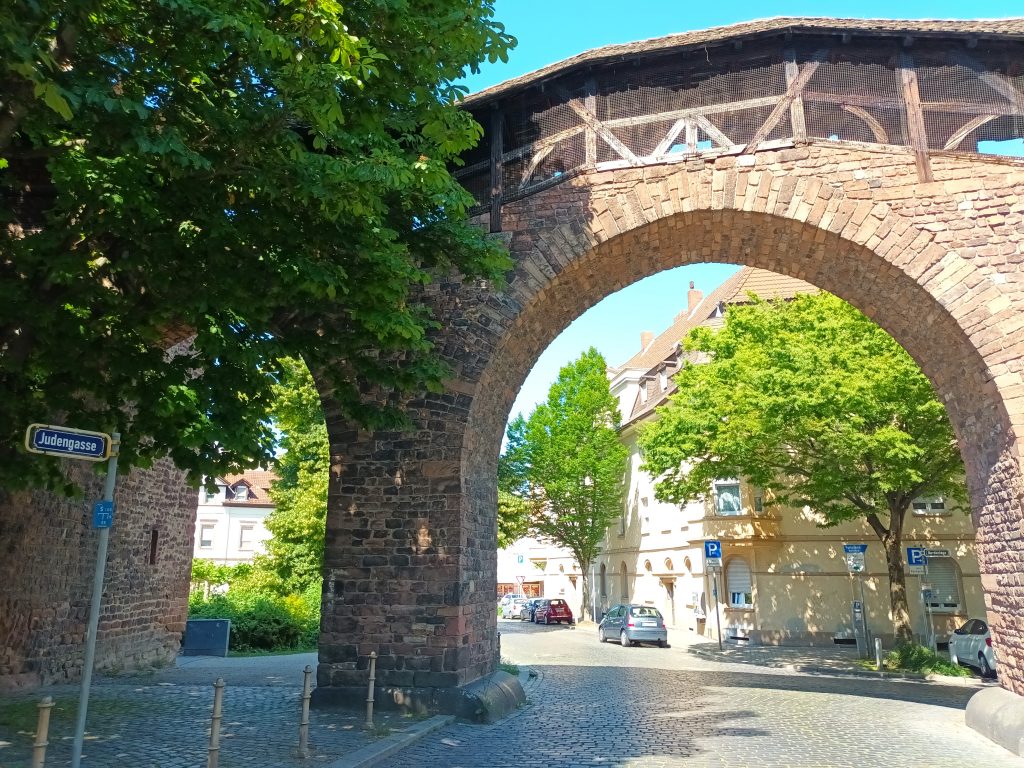
Near the city walls, the first synagogue in Worms was built in 1034, thanks to a donation from Jacob and Rachel Ben David. This made it easier to welcome great European scholars, and Worms became, like the other cities of the SChum, famous for its yeshivot and illustrious students and teachers, including Rashi.
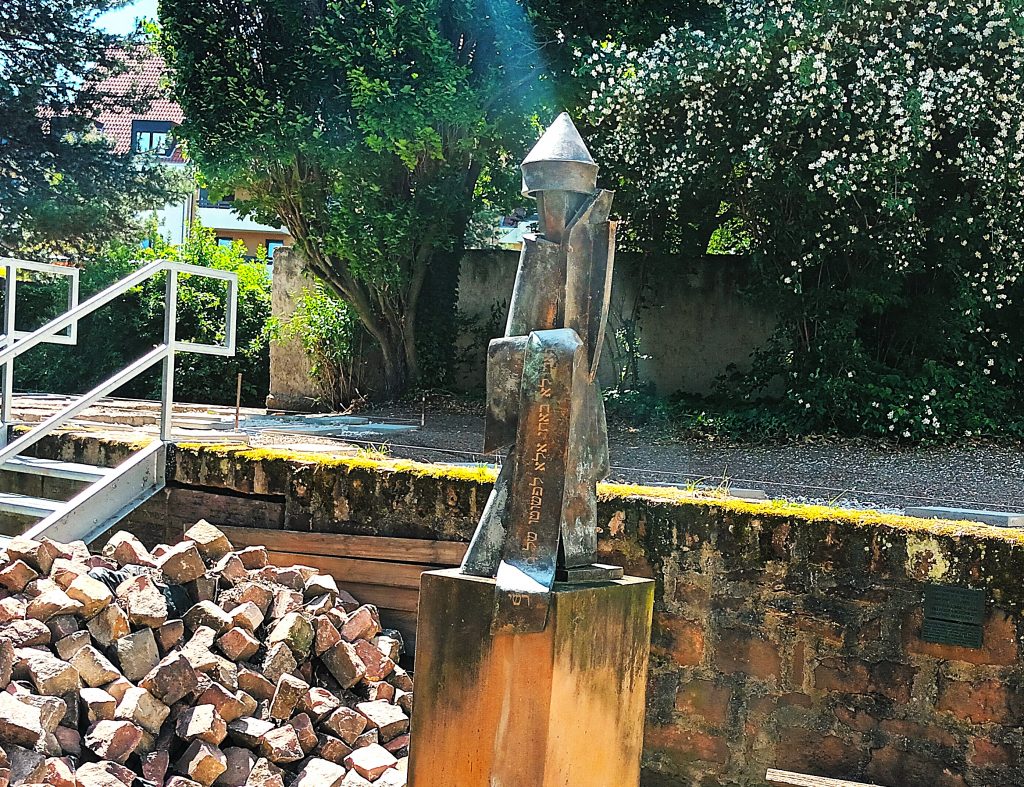
It was during this same period that the Jews obtained land at the other end of the city to establish a cemetery. Burials took place there uninterruptedly until 1911.
The mikveh probably dates from the end of the 12th century. Built by the community thanks to donations from a certain Joseph, it was dug 7 metres deep to reach the spring water. It included a room for changing and another for cleaning before immersing oneself in the mikveh water.
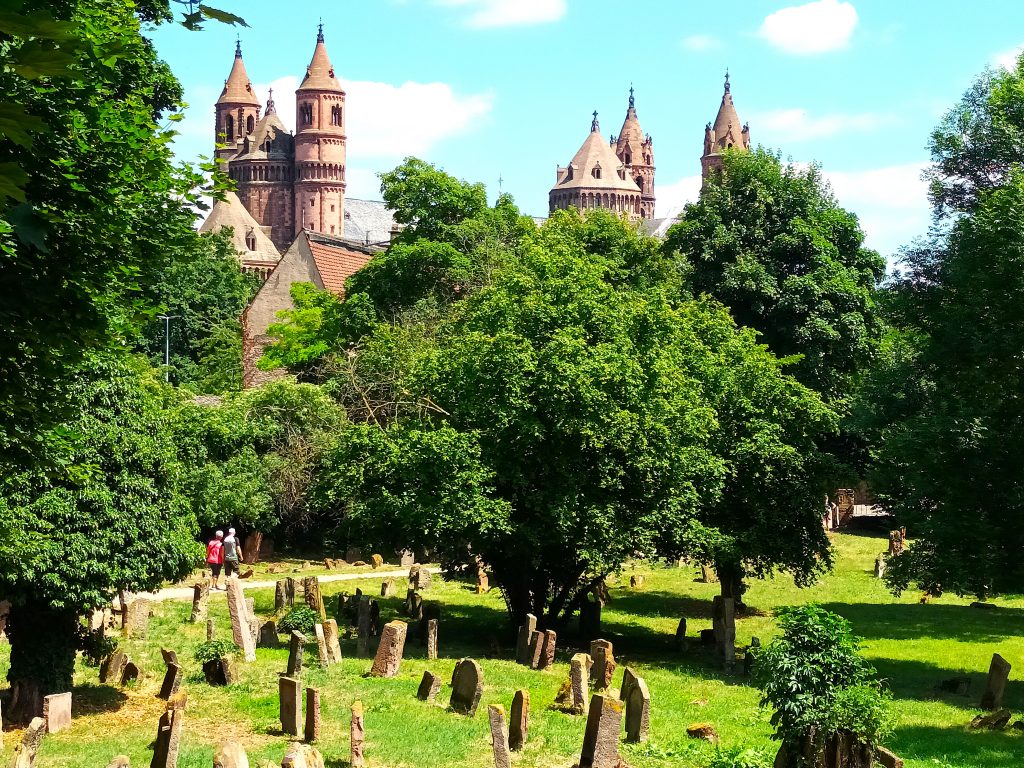
The synagogue had to be rebuilt following the destruction caused during the Crusades of 1096 and 1146. It was reopened in 1175. Meir and Judith bar Joel made a donation in 1212 to build a prayer room for women, adjacent to the men’s room. Built in the same spirit as in Speyer, the Frauenschul was connected to the men’s hall by a door and five small windows that allowed the women to hear the prayers. It was not until the 19th century that this space was opened up to allow women to participate more fully in the prayers.
During the persecutions of 1349, the year of the Black Death, more than 400 Jews were murdered, the Judengasse was destroyed, and their property was looted. The synagogue was rebuilt in Gothic style. From that moment on, the Jewish community of Worms suffered an irreparable decline, particularly in terms of intellectual and religious production.
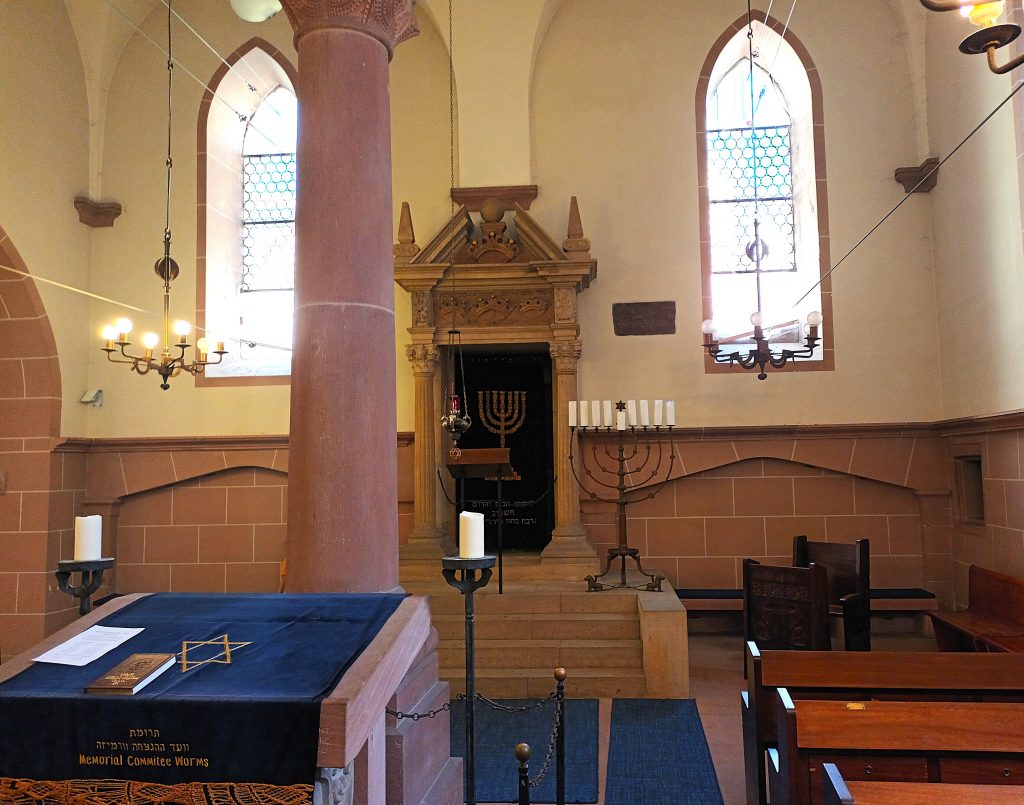
At the end of the 14th century, just under 200 Jews lived on Judengasse. A few students joined them, and by 1500 the Jewish community numbered around 250.
Forced to live in the ghetto, the number of Jews nevertheless increased thanks to the support of Emperor Ferdinand I (1503-1564), who prevented the municipality from expelling them. Thus, from the end of the 16th century to the end of the 18th century, between 500 and 700 Jews lived on Judengasse. However, Louis XIV’s troops destroyed the city in 1689 during the War of the Palatinate Succession, including its Jewish quarter.
As in various other European cities conquered by French troops in the early nineteenth century, Jews were granted the same rights as their fellow citizens. With this equality finally achieved, Jews contributed greatly to the economic, intellectual and political development of Worms. Proof of this successful integration, Ferdinand Eberstadt (the son of a family established in Worms since the 17th century) was even mayor of Worms from 1849 to 1852.

The intellectual momentum of the 19th century also encouraged changes within the Jewish community. The Levi Synagogue was built in 1875, opposite the other synagogue, following rich but tense debates between traditionalists and liberals. It was named in honour of its founder, Leopold Levy.
The Jewish community in Worms had 1,000 members in 1933. On 3 June 1934, the synagogue celebrated its 900th anniversary, despite fears about the Nazi takeover.
During Kristallnacht on 9-10 November 1938, the old synagogue in Worms was destroyed once again. The Levy Synagogue was severely damaged that night and suffered further damage during an Allied bombing raid on the city in 1945. Only a few walls remained standing, to such an extent that in 1947 there was no option but to demolish it.
In March 1942, 75 Jews were rounded up and sent to Sobibor and Belzec. In September 1942, another 93 were sent to Theresienstadt and five to Treblinka. In total, 460 Jews from Worms were murdered during the Holocaust.
The synagogue was rebuilt between 1959 and 1961. The project was made possible thanks to the support of Jews who had managed to flee during the war, as well as the current communities of Mainz and Worms, the city of Worms, the state of Rhineland-Palatinate and the Federal Republic of Germany.

Behind this synagogue is a place of study known as the Yeshiva Rachi, named after the great exegete who studied in Worms. Since 1982, this building has housed the Jewish Museum of Worms, but it is not the first of its kind. The first Jewish museum in Worms dates back to 1924. It was the work of Isidor Kiefer (1871-1961), an active member of the Jewish community in Worms. He went into exile in the United States in 1933 after the Nazis came to power. During Kristallnacht, the museum was destroyed in the pogrom. Only a few rare pieces from the museum were saved.
The dozen or so Jews living in Worms today are connected to the community life in Mainz.
Itinerary
Leaving Worms station, turn right onto Bahnhofstrasse and follow the street to the end.
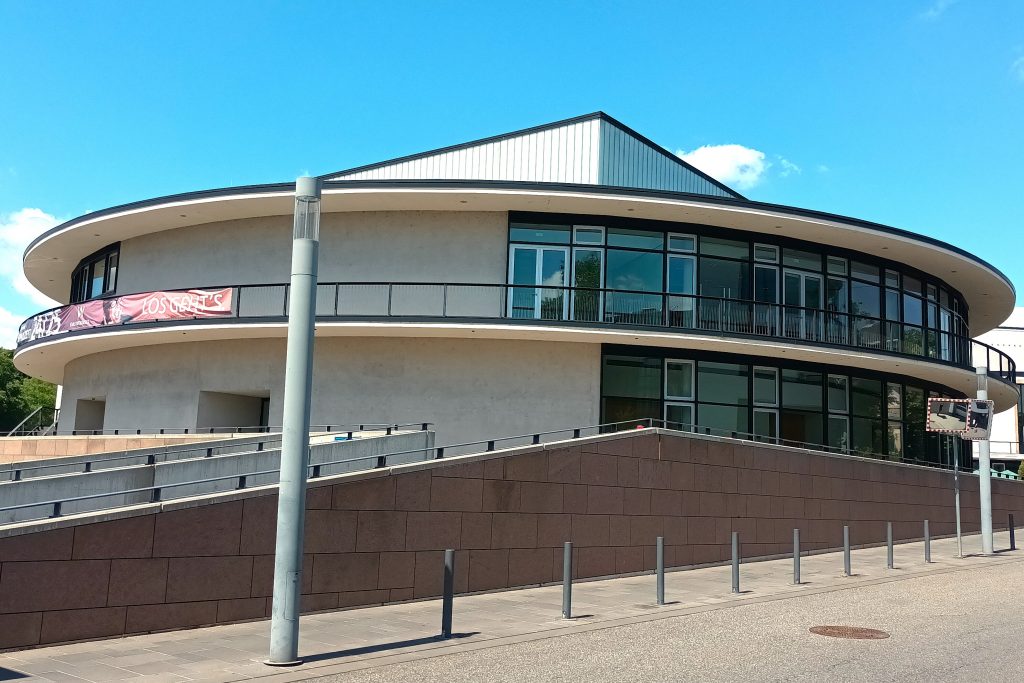
Opposite the theatre, which hosts many cultural events, turn left to reach the old Jewish cemetery in Worms.

The cemetery consists of several sections, the main one at the entrance and the others overlooking it, which were built when the cemetery was enlarged.
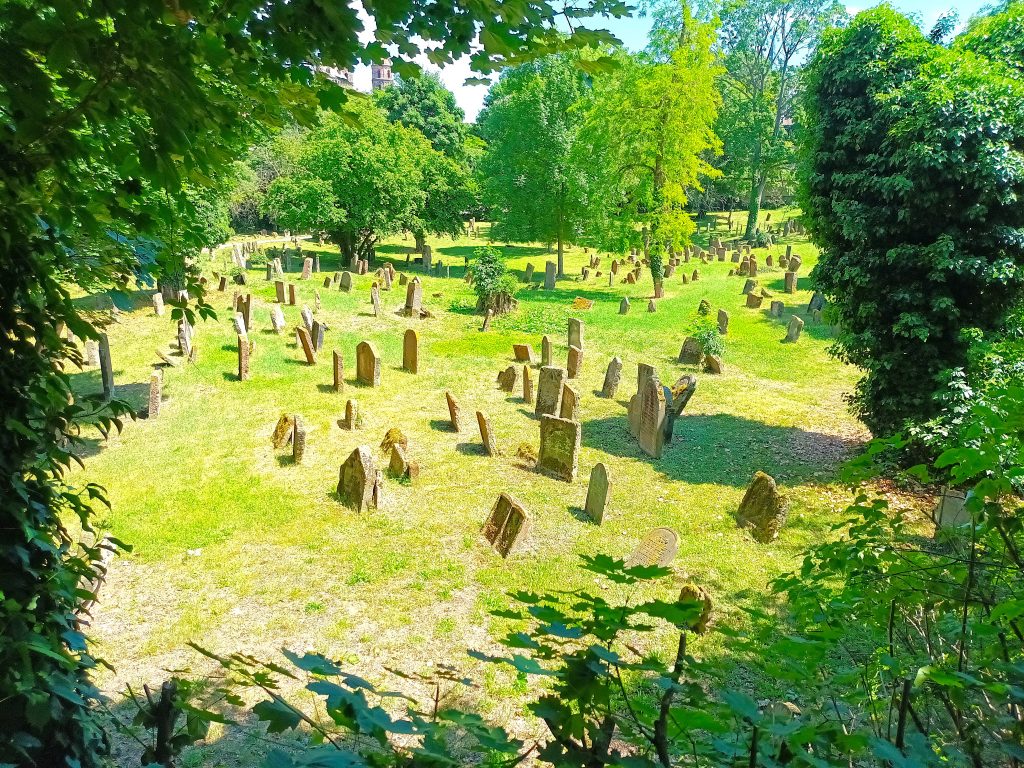
The Jewish cemetery of Worms is probably the oldest in Europe. Dating back to the 11th century, 836 graves have been recorded. Some are very ancient and others more recent, which can be seen on the small path above leading to the different sections.
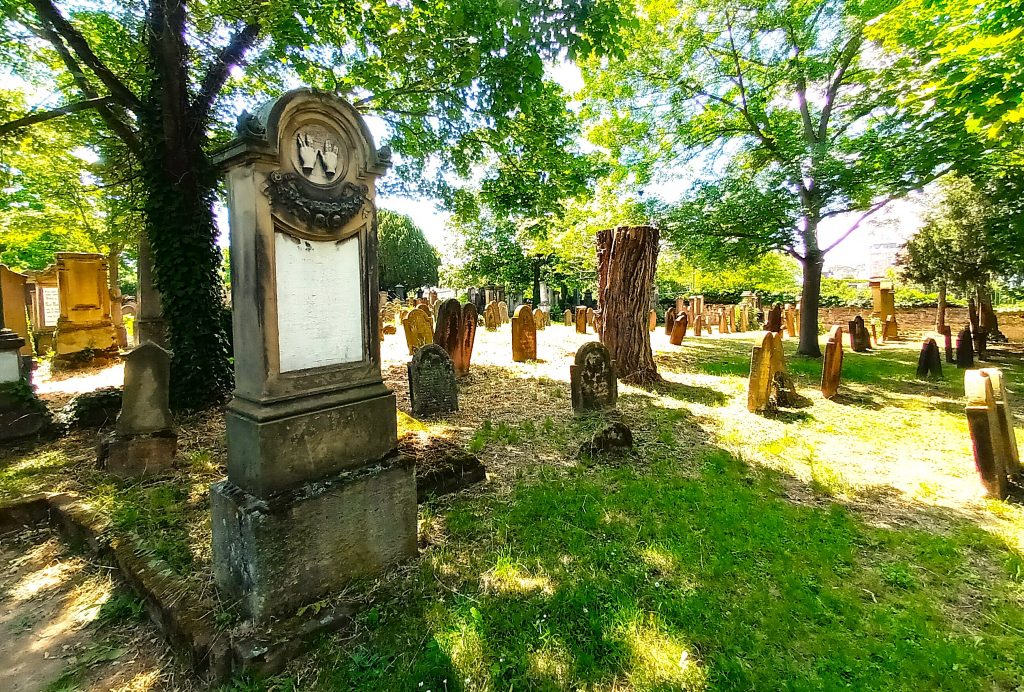
After this visit, head back up towards the old town along the ramparts. You will come to numerous religious buildings, including the cathedral and churches of different denominations.
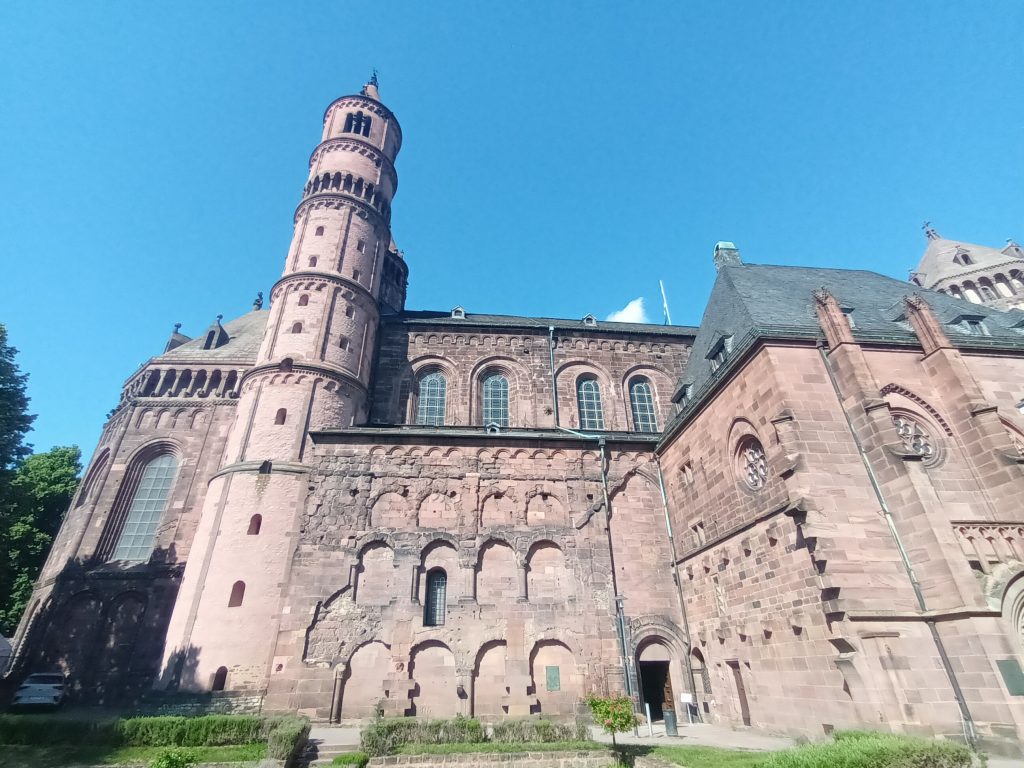
To reach the Judengasse, you cross the shopping street Kämmererstrasse, lined with fountains: the Siegfriedbrunnen (in honour of Siegfried, hero of Norse mythology),
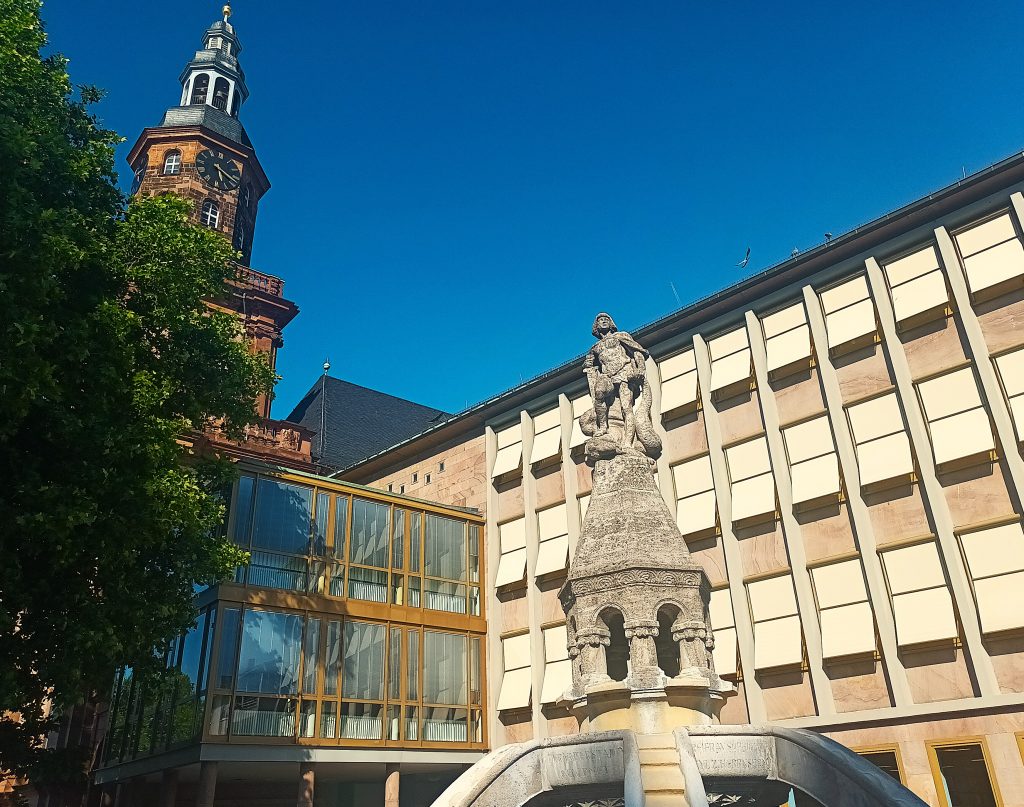
the Winzerbrunnen (the Winegrowers’ Fountain pays tribute to the local wine culture and historical figures associated with viticulture)
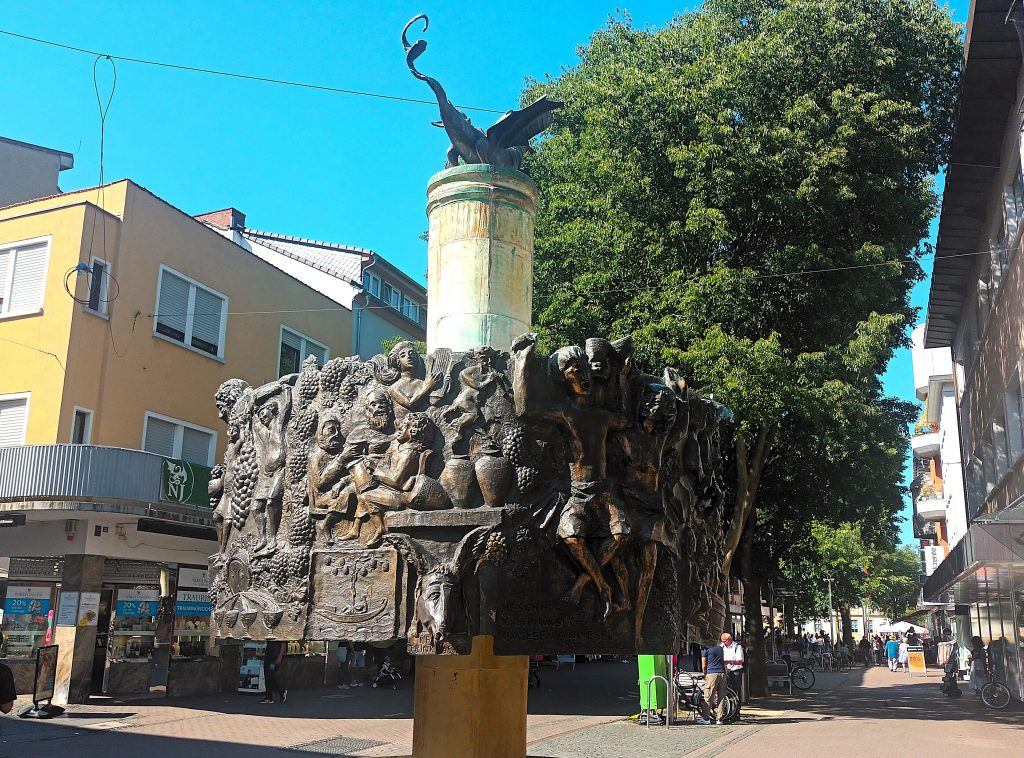
and finally, the Ludwigsbrunnen (in honour of Grand Duke Louis IV of Hesse and the Rhine), on the square of the same name, celebrating the city of Worms.
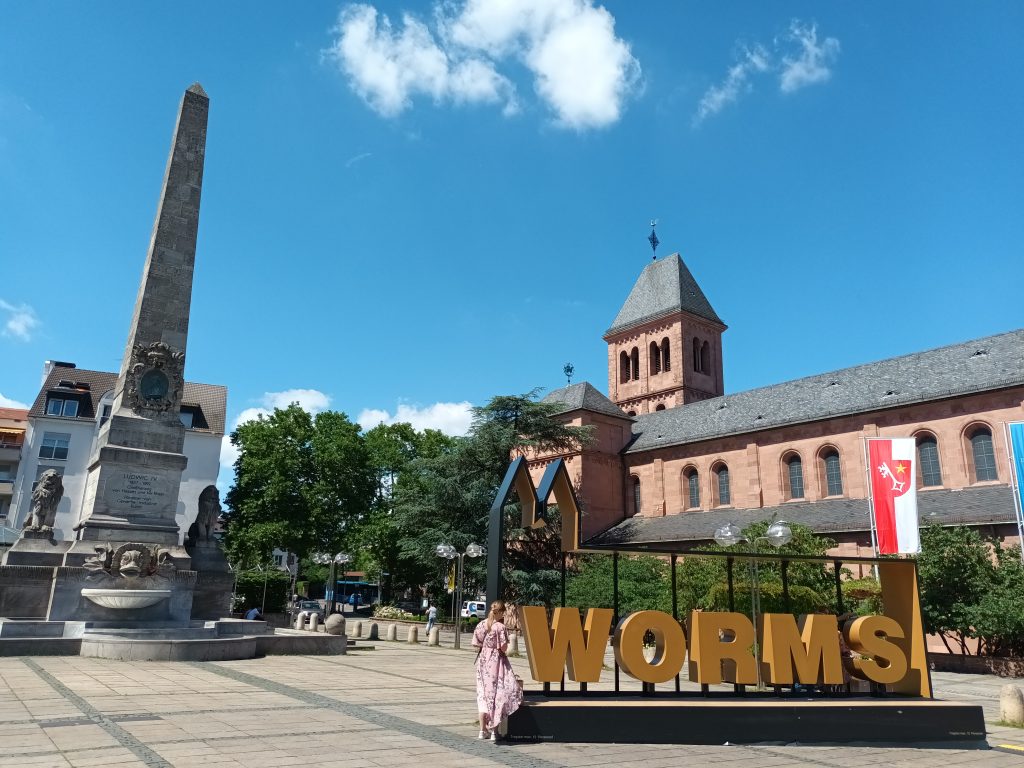
At the end of this street, arriving at the Martinspforte, turn right into Judengasse.
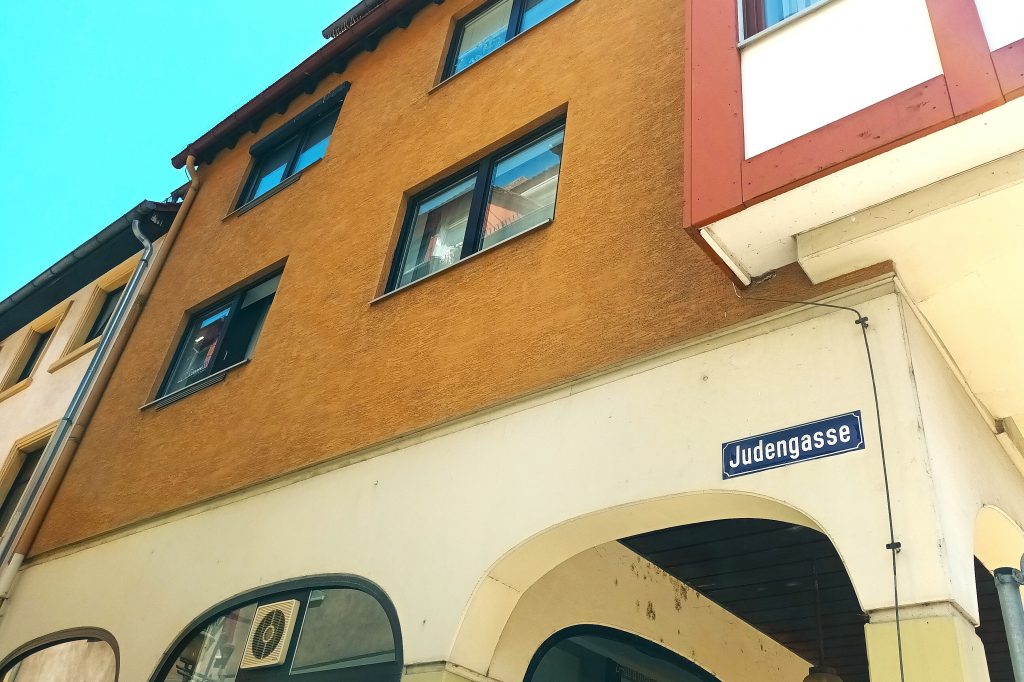
At the beginning, you will see a kindergarten named in honour of Anne Frank. This section of the street is paved with old cobblestones, among which you will also find other types of cobblestones, known as Stolpersteine, marking the places where Jews lived before being deported during the Holocaust.
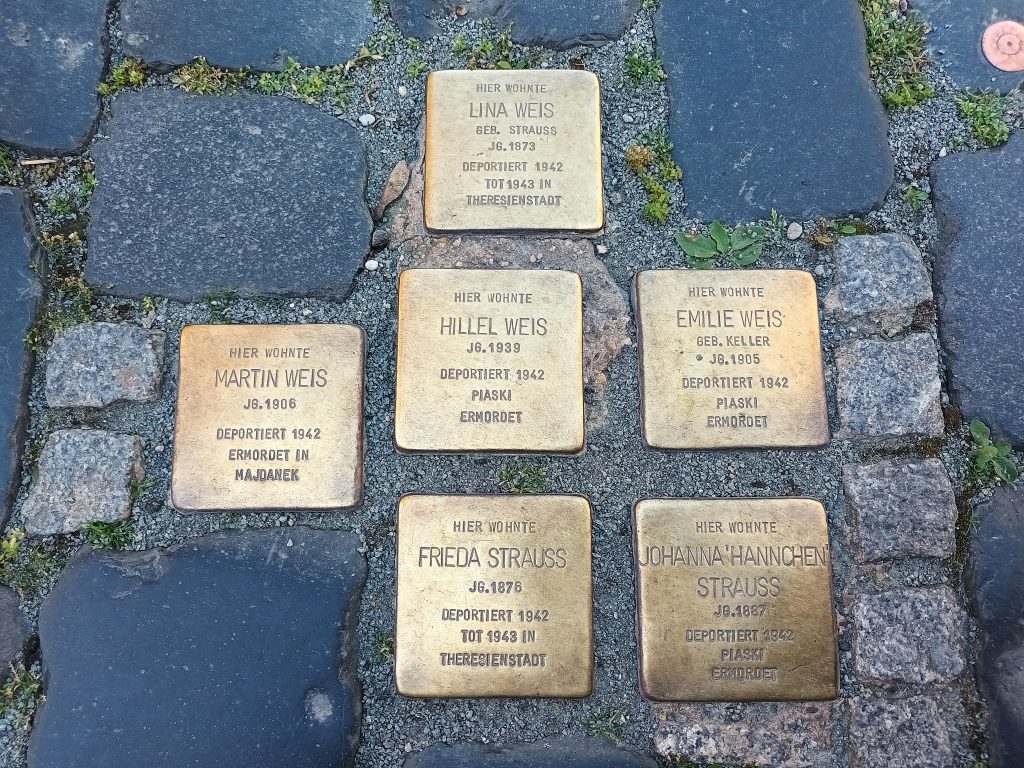
Judengasse leads to the synagogue and the Jewish Museum . Opposite the entrance to the synagogue is a commemorative plaque on a wall marking the site of the Levy Synagogue, which stood here from 1875 to 1947.

Upon entering the museum, visitors are greeted on the right by a video that tells the story of the building and provides a general overview of Jewish rituals.
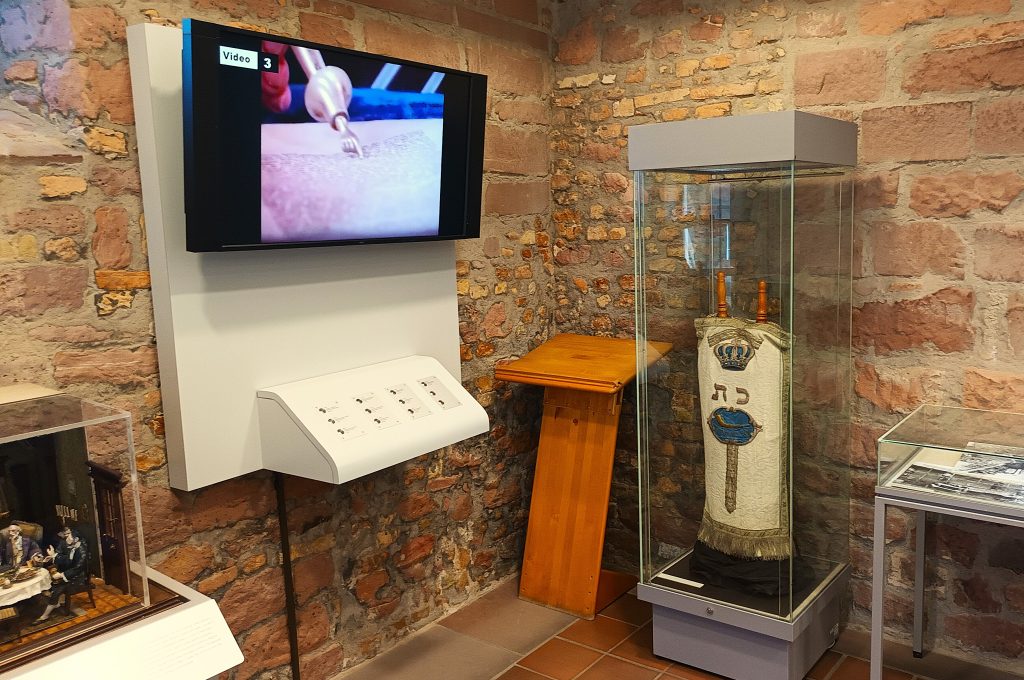
Next to the video is a Sefer Torah. In the same room, visitors can see ancient objects and manuscripts protected by glass cases.
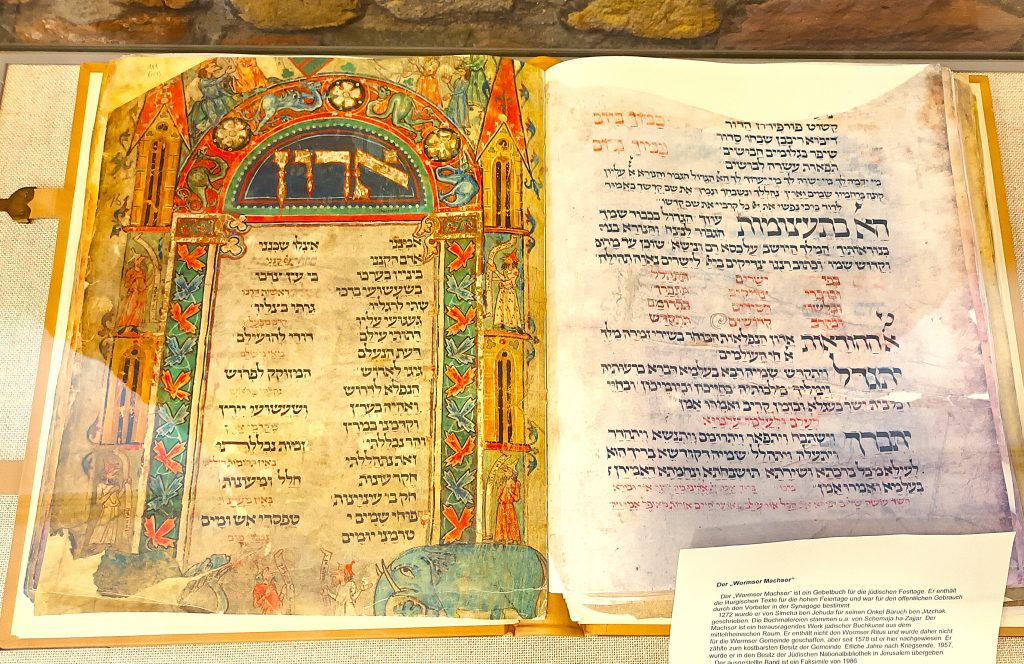
Among these important documents is the famous Mahzor of Worms, a collection of liturgical texts used by the synagogue’s cantor. This mahzor was written in 1272 by Simha Bar Judah. The original version is kept at the National Library of Jerusalem. The one on display at the museum is a reproduction dating from 1986.
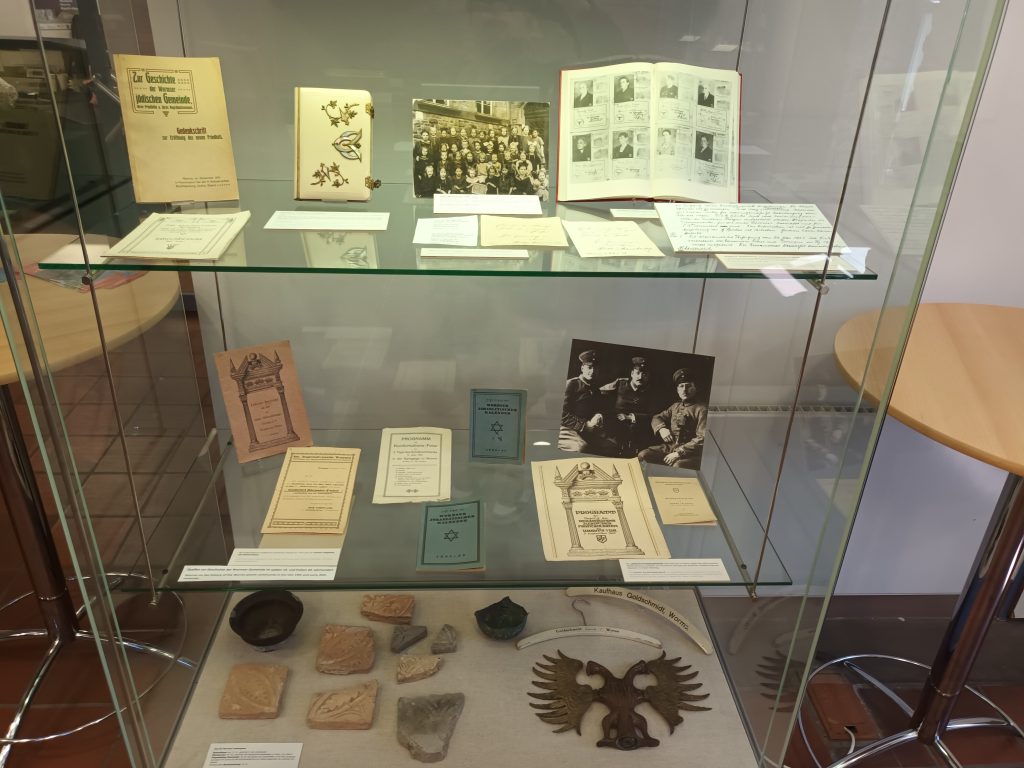
Other objects include books, of course, but also photos of schoolchildren and Jewish soldiers during the First World War. There are also portraits of prominent figures from the community and even coat hangers from the Goldschmidt store in Worms. This was the best-known and largest textile store in Worms, occupying most of the buildings between Domgasse and Hofgasse before the war.

The room on the left consists mainly of panels presenting a wide variety of subjects: the general history of the Jews in the Schum region, the creation of the first Jewish museum by Isidor Kiefer, the celebration of the 900th anniversary of the synagogue in 1934, its reconstruction after the war, and a sideboard with the Hebrew word ‘Zakhor’ , meaning ‘remember’, in whose drawers you can read the biographies of Jews from Worms who were deported during the Holocaust.
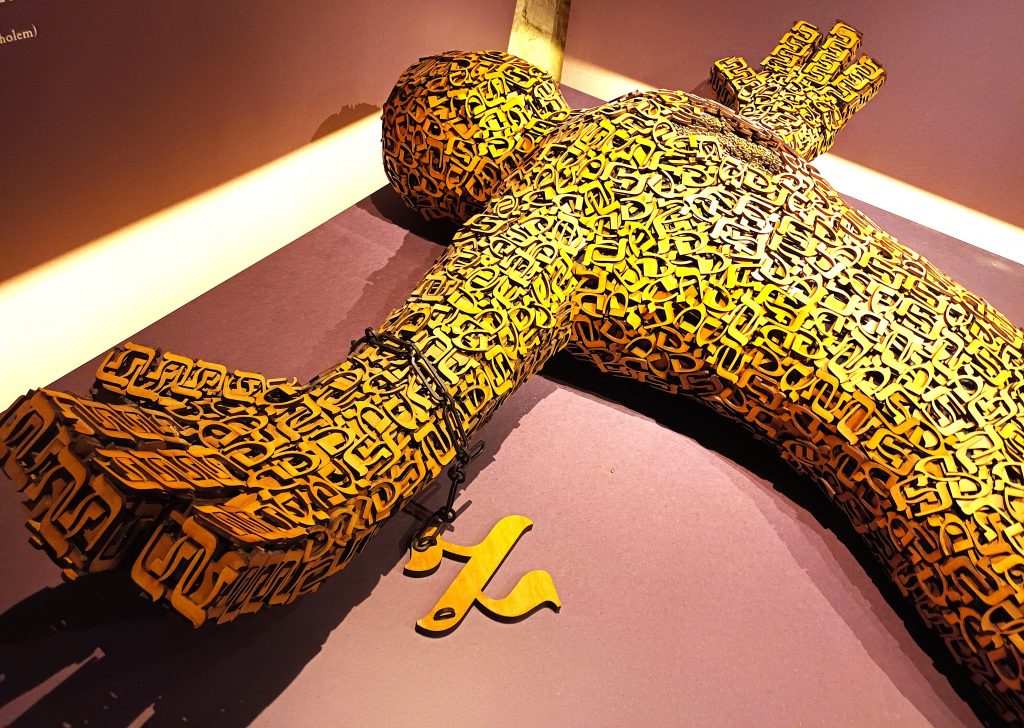
Descending to the basement of the museum, you are welcomed with open arms by a work representing the Golem, created by artist Joshua Abarbanel. Lying with his arms outstretched and the Hebrew letter alef attached to his wrist, the first letter of the word ‘emeth,’ meaning ‘truth,’ which gives the Golem its strength. In search of truth and protection for Jews in the face of threats. This Golem made of letters is reminiscent of the ‘Body of Knowledge’ at Goethe University in Frankfurt, a work that also contains some Hebrew letters.
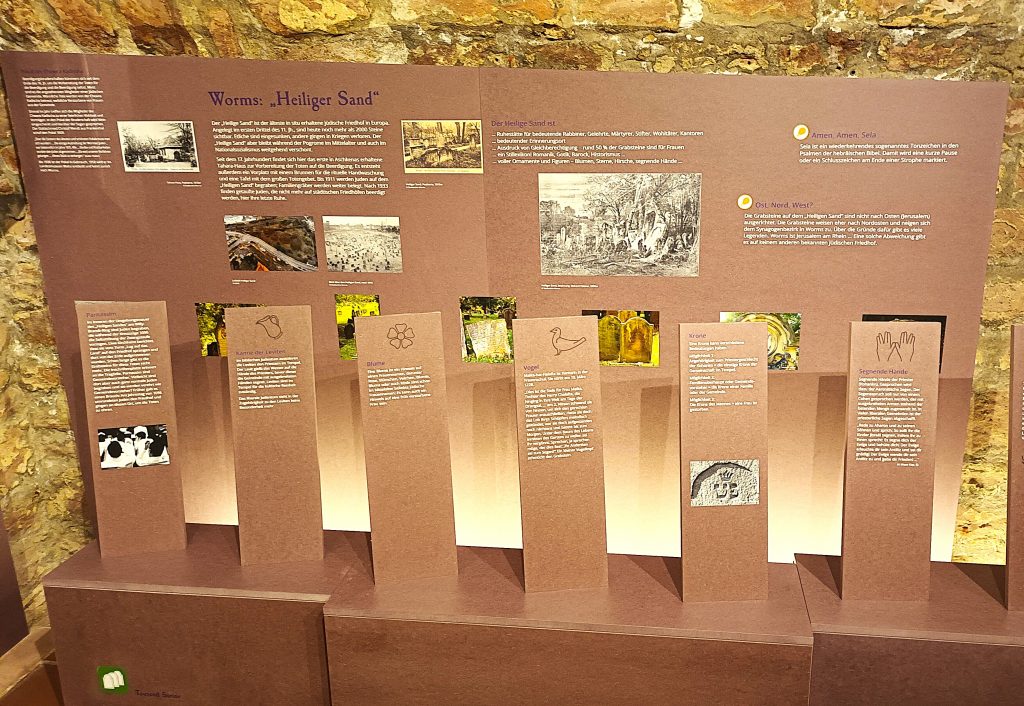
There is also a very interesting presentation of the symbols placed on the graves, including drawings of animals and flowers, and the meaning of each of these symbols. There is also a table listing the French and German cities linked to the thinking of Rashi.
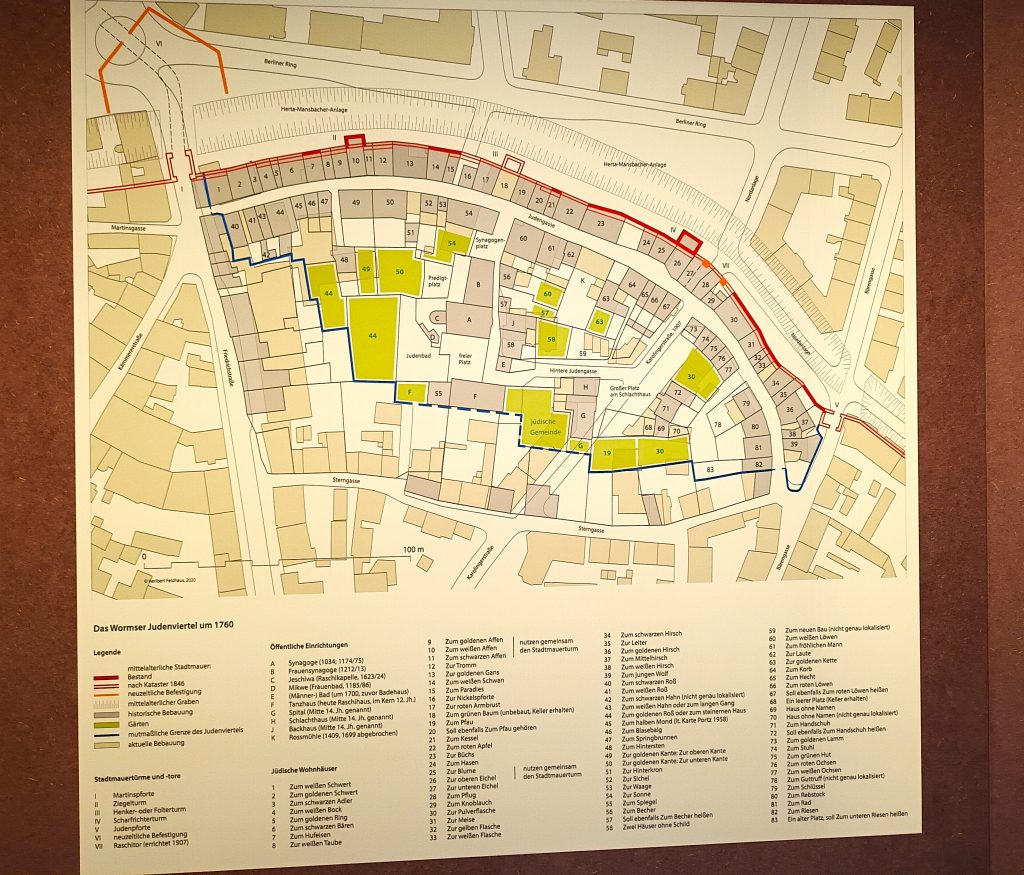
A map of the Judengasse in 1760 has been reconstructed with its dwellings, reminiscent of the Jewish Museum in Frankfurt with its presentation of people’s stories and moments in their lives that we can (re)discover and share. This is an attempt to rehumanise Jewish life, which has been the victim of massacres over the centuries.
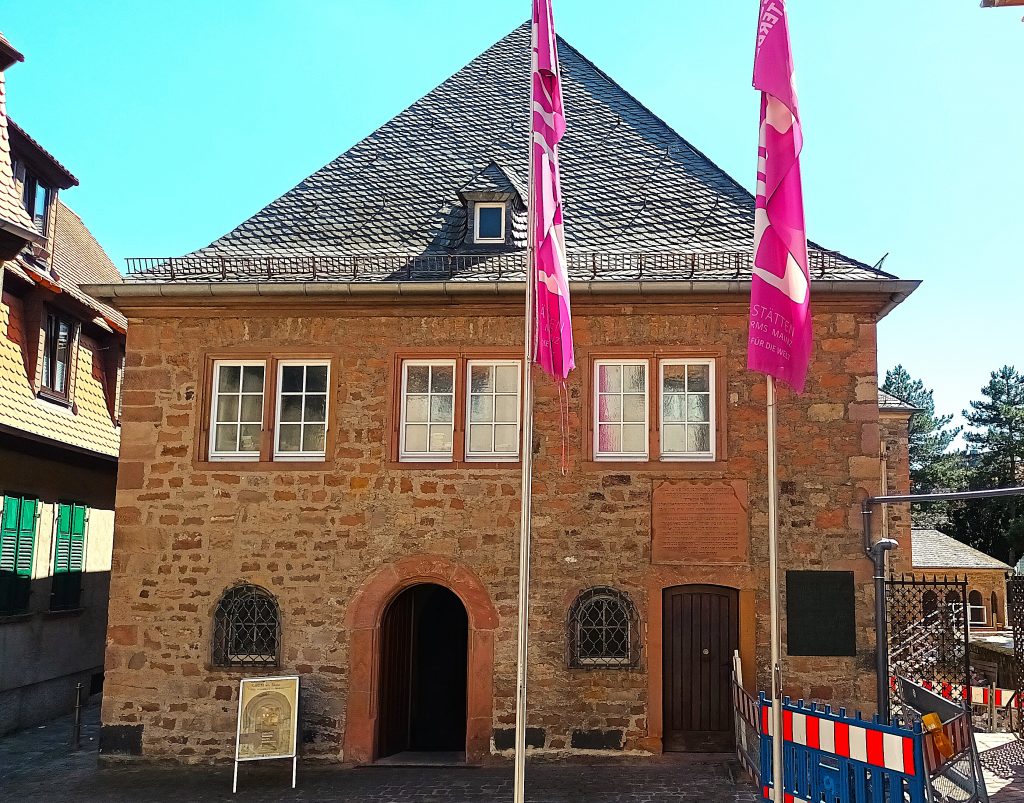
On leaving the museum, you will find the remains of an old well before visiting the synagogue. Restored 1001 times after suffering repeated destruction, it now welcomes tourists.
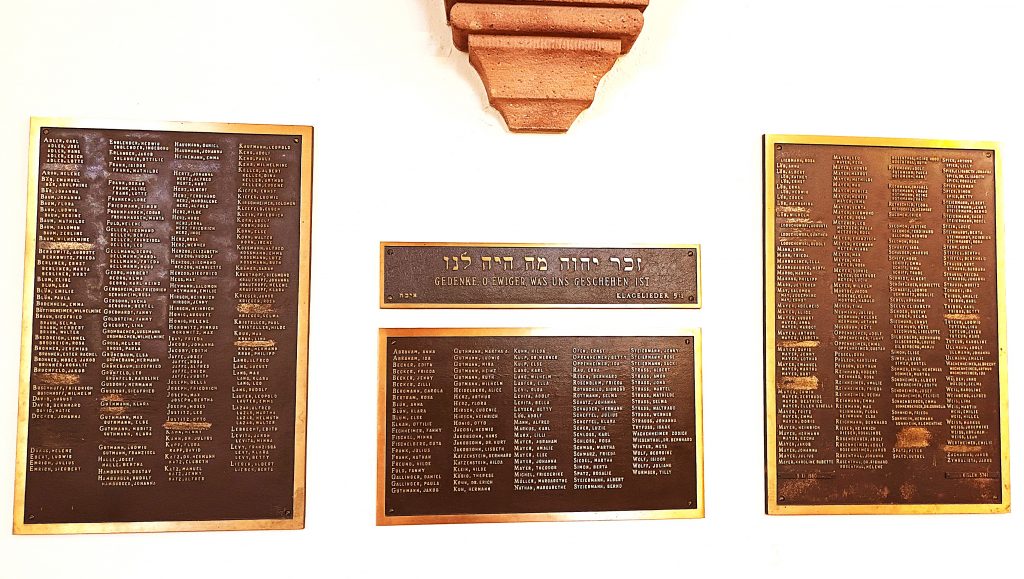
The first room pays tribute to those who have disappeared and displays old objects. The second room, with its benches, menorah, teva and aron illuminated by the light-coloured walls, chandeliers and rays of sunlight streaming through the windows, seems to be waiting for the faithful to return.
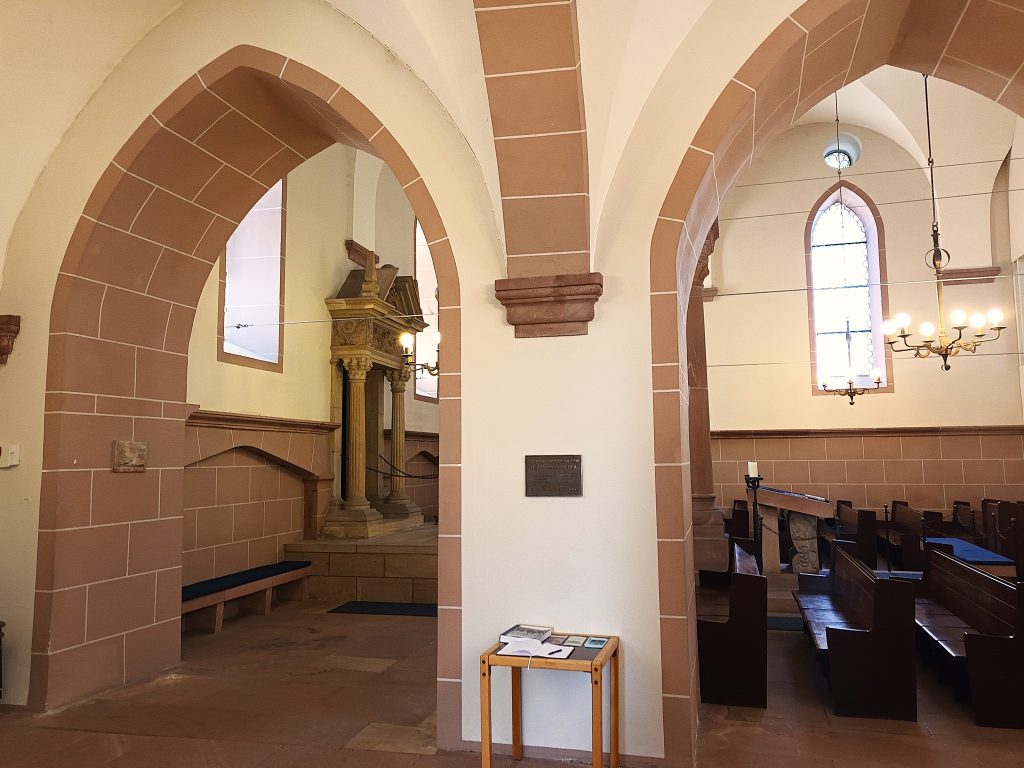
On leaving, to the right of Judengasse, a little further on is another well, and the street leading to the beautiful remains of the city walls, a symbol of present and future protection for the Jews?
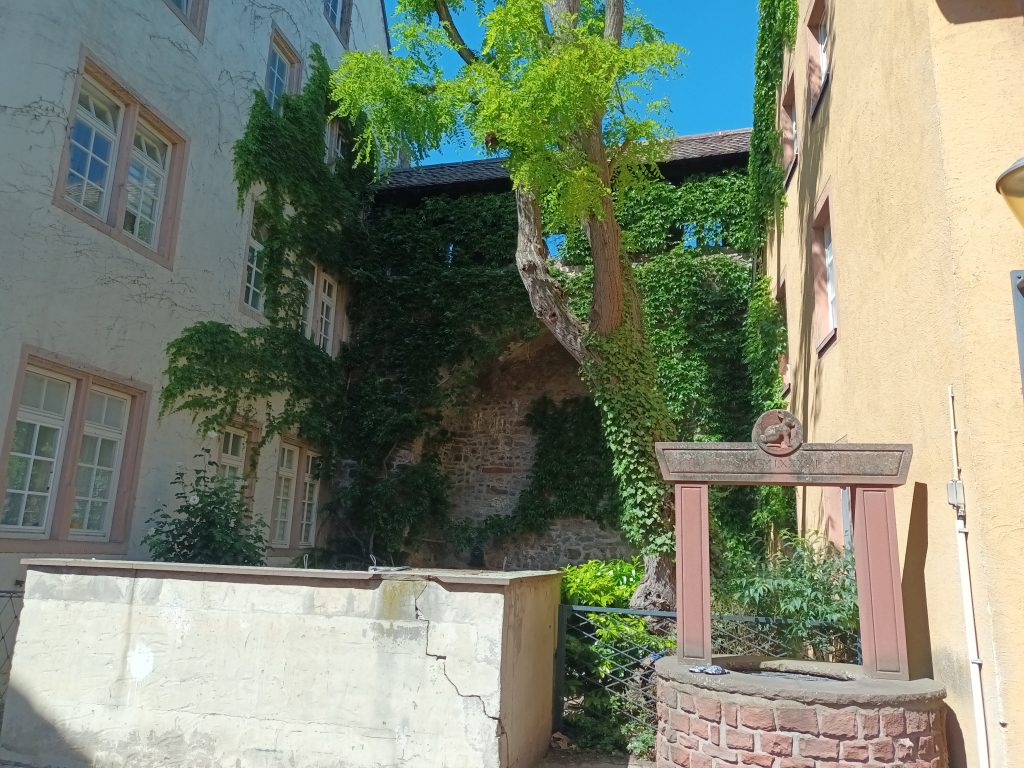
An ancient Roman city, Mainz is known for its university, museums and places of worship, its monuments including the Castle of the Electors, its popular festivals… But Mainz is above all known as the birthplace of Johannes Gutenberg (1400-1468), the man who revolutionised printing.
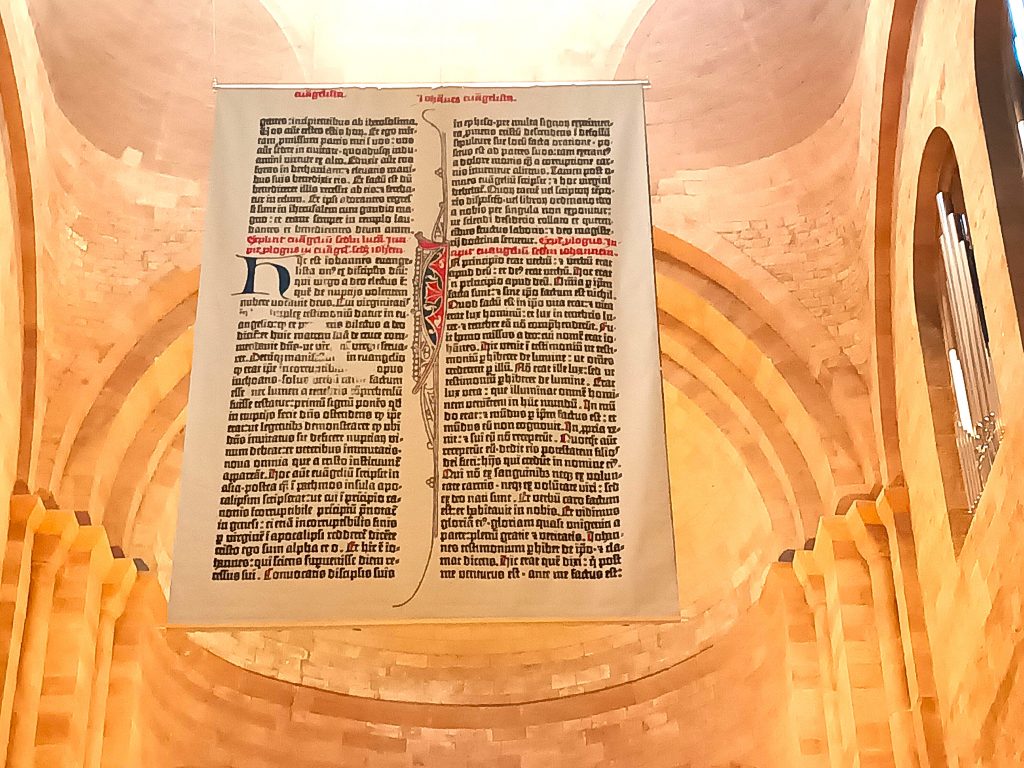
Mainz celebrates Gutenberg’s presence and influence in many different ways, including a museum dedicated to him, statues, squares and, in 2025, the largest pages of the Bible, measuring 5 by 7 metres, hung at the top of the cathedral in honour of the 625th anniversary of Gutenberg’s birth.

ShUM, the famous acronym which, in Hebrew, takes the first letters of three mythical cities: Speyer, Worms and Mainz. Three cities along the Rhine that represent the cradle of Ashkenazi Jewish thought. From the 10th century onwards, and for several centuries thereafter, this region remained one of the centres, if not the largest, of medieval Jewish thought. This was thanks to the great khakhamim who were born, studied and/or taught there.
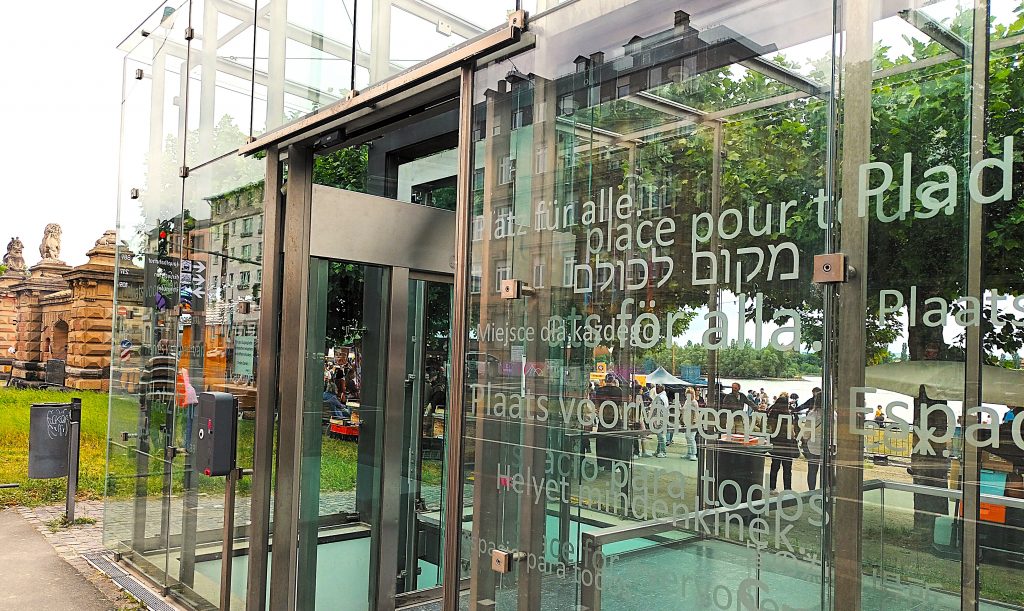
ShUM means ‘garlic’ in Hebrew. What is certain is that the debates between thinkers of the same generation, and especially later with their disciples, were very varied and very spicy. This curiosity, this requirement inherited from the Bible to end discussions with a question rather than a period or an exclamation mark, encouraged debate, the evolution of thought, its sharing, its generosity… a questioning in the noble sense of the word. It is therefore no coincidence that Rashi, the most famous and respected exegete of the Bible in the Jewish world today, studied in this region.

Mainz probably has the privilege of being the oldest of these Jewish communities. It dates back to the 10th century, if not earlier. Administrative documents confirm the presence of Jews as early as 906. They were expelled from the city in 1012, but were later allowed to resettle there. During the First Crusade, in 1095-1099, more than 1,000 Jews died, either murdered or committing suicide, refusing to convert by force. At that time, there was a synagogue, but it was burned down, along with the Jewish quarter. A few years later, Emperor Henry IV (1050-1106) allowed them to return and live in peace.

As a symbol of this spiritual and intellectual authority, numerous synods were organised in Mainz, notably in 1150, 1223 and 1250. The takanoth of ShUM were respected throughout Europe. Among the great names of this period were the Kalonymus family and, of course, Rabbenu Gershom. Born in Metz in 960, he established numerous yeshivot in both France and Germany. In the year 1000, he convened a synod where important decisions were made, including takanoth that revolutionised Judaism. Among these were the prohibition of polygamy and the requirement that a woman’s consent be obtained in order to initiate divorce proceedings. Rabbenu Gershom died in Mainz in 1028.
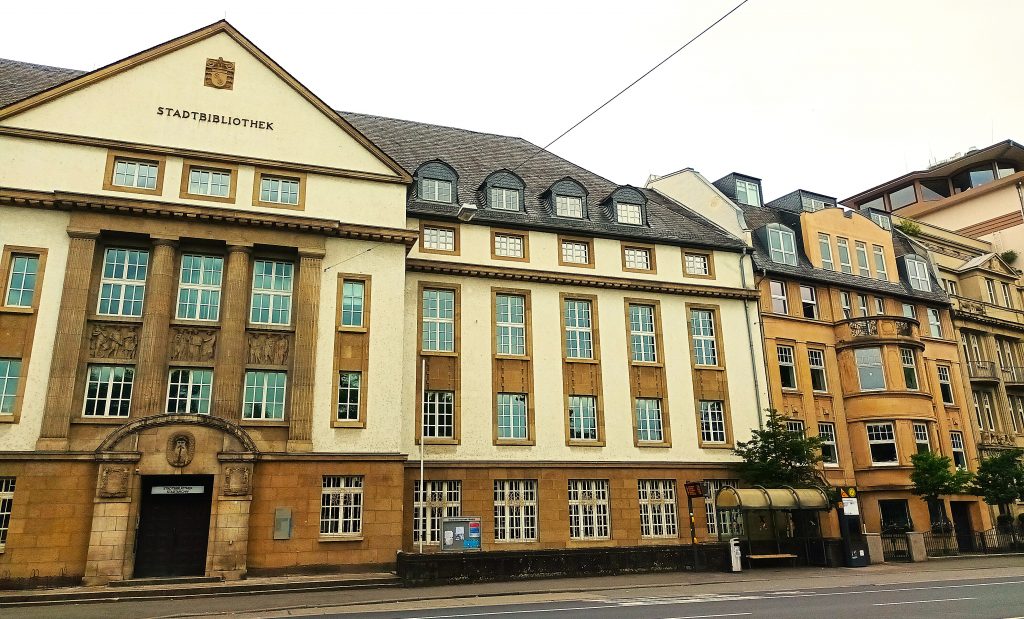
In the period that followed, the Jews of Mainz were alternately threatened and protected, depending on the rulers of the time. Thus, during the Second Crusade of 1146-1149, many Jews were murdered, but during the Third Crusade, in 1189-1192, the Jews of Mainz enjoyed the protection of Frederick I (1122-1190), who walked alongside the rabbi to show the population that he would oppose any hostility towards them.

The 13th and 14th centuries were particularly violent for the Jews of Mainz. Forced to wear distinctive signs in 1259, their synagogue was burned down, again, at the end of the 13th century. Following the Black Death of 1349, most of the Jews perished in the flames. Although the end of the 14th century and the 15th century were less bloody, the Jews were subjected to heavy taxation, and their synagogue was converted into a chapel.
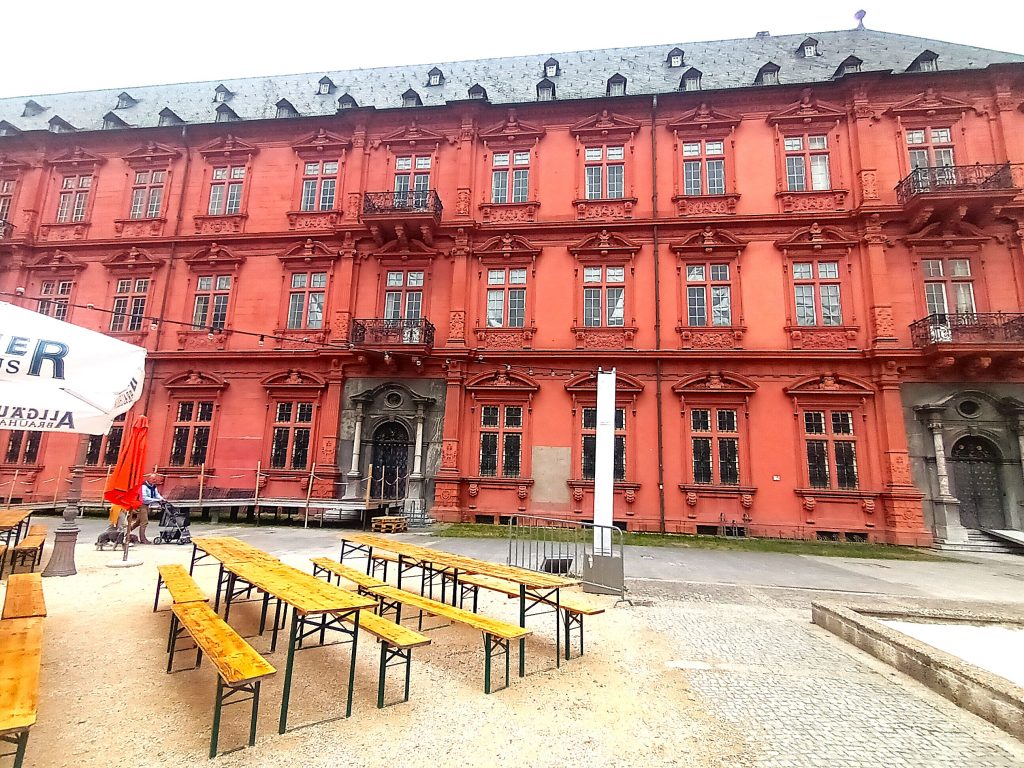
Very few Jews still lived in Mainz during the 16th century. It was only at the end of the century that the community regained some strength thanks to the arrival of Jews from Frankfurt, Worms and Hanau. A new synagogue was built in 1639. Their situation worsened during the French occupation from 1644 to 1648. It was only following the influence of Joseph II’s policy of tolerance and the revolutionary spirit in France that their situation improved at the end of the 18th century.
In the 19th century, Judaism in Mainz finally experienced a real renaissance. Although this was not the golden age of the ShUM, great Jewish thinkers and rabbis engaged in very fruitful discussions and even vigorous debates, which gave rise to different currents and schools of thought. The Jewish population of Mainz grew from 1,620 in 1828 to 3,104 in 1900.
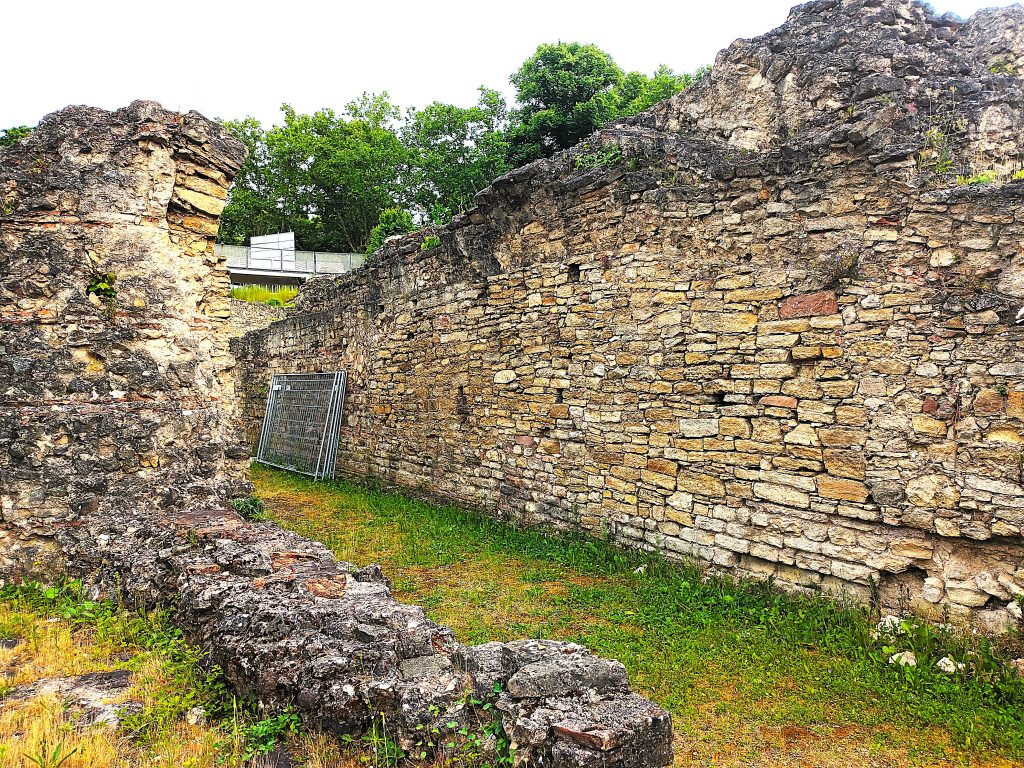
At the beginning of the 20th century, this number gradually declined. By 1933, when the Nazis came to power, there were only 2,730 Jews in Mainz. During Kristallnacht, the city’s three main synagogues were burned down. Although nearly half of the Jews managed to flee before the deportations, most of those who remained were murdered during the Holocaust.
After the war, a small community attempted to reorganise itself. There were 80 Jews in 1948, barely more than 100 twenty years later. Most were elderly. As a sign of the changing relationship, Mainz was twinned with the Israeli city of Haifa in 1981.
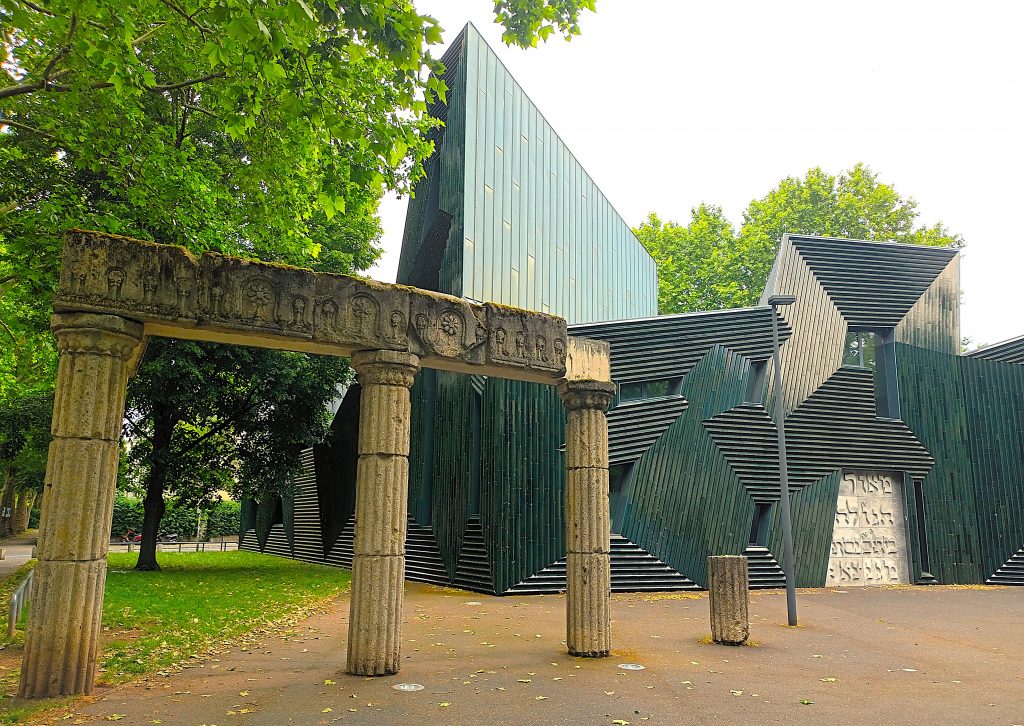
Thanks to the arrival of Jews from the former Soviet Union, the community was able to rebuild itself, reaching 1,000 members in 2005. A symbol of this revival is the stunning new synagogue , both in terms of its design and architectural achievement, which was inaugurated in 2010.
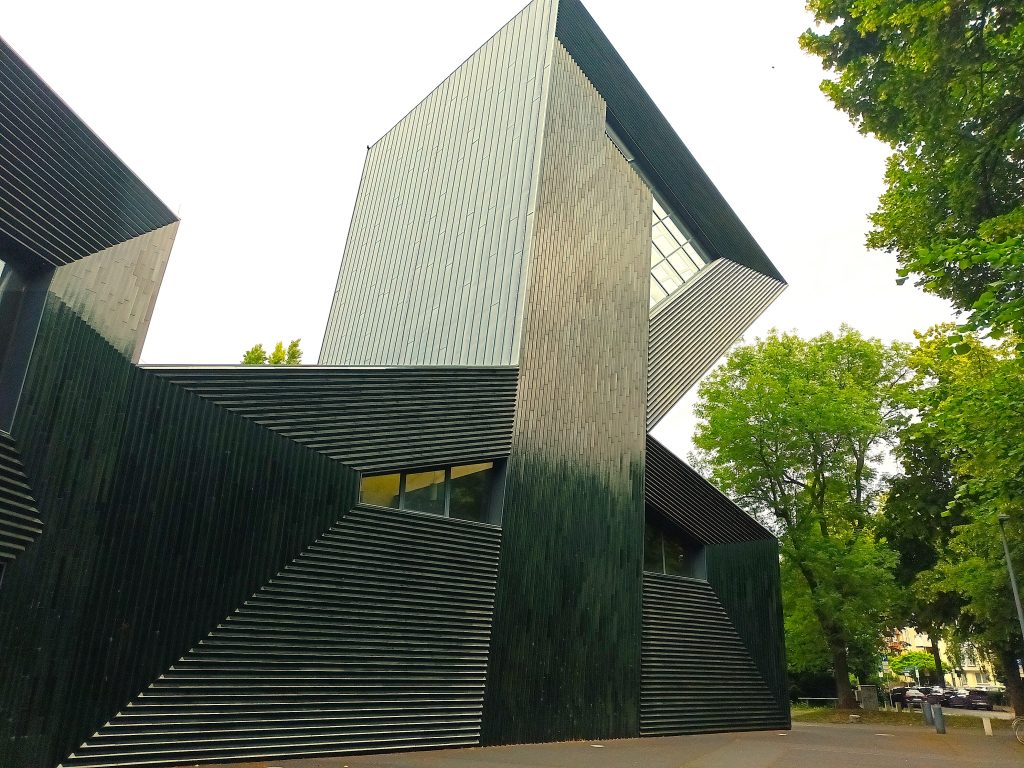
The Kedusha Synagogue, which also houses a community centre and an exhibition on the history of Jews in Mainz, was designed by architect Manuel Herz.
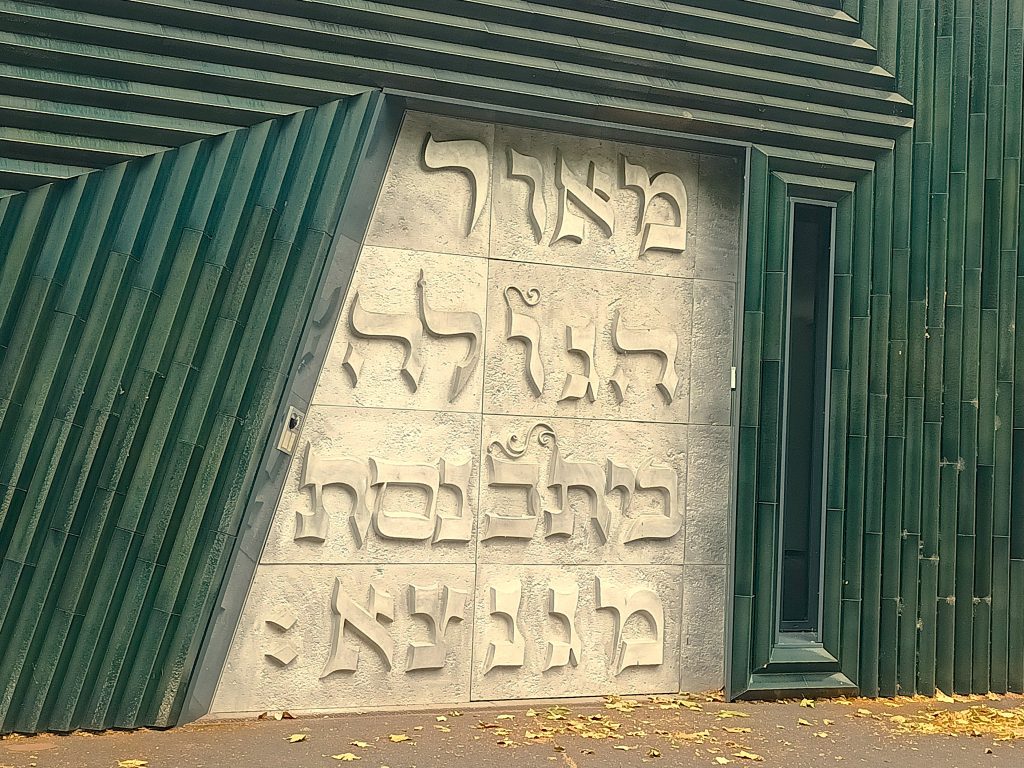
Its highly complex architectural form evokes the word ‘kedusha’, meaning ‘holiness’.
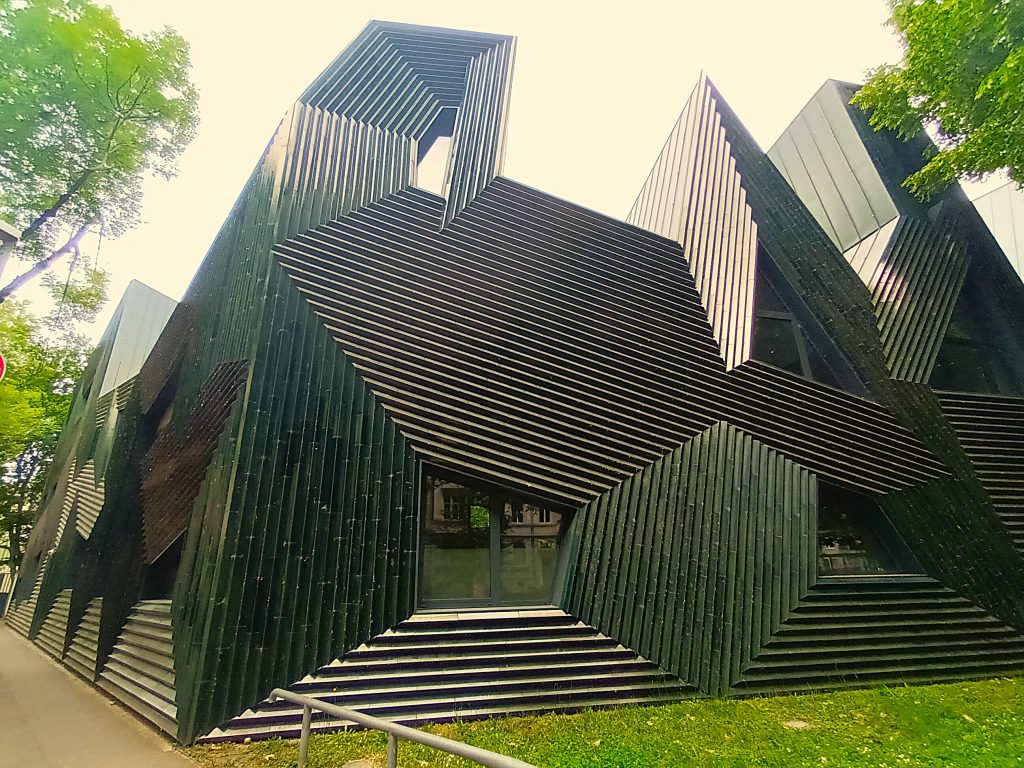
This Jewish community, which was reborn at the turn of the 21st century, allowed the few Jews still living in Worms to join in religious and festive celebrations.

Near the Gutenberg Museum, a high school has been named in honour of Anne Frank, featuring a Warhol-inspired work with her portrait in several colours.


Stolpersteine (stumbling stones) have also been laid in the city.
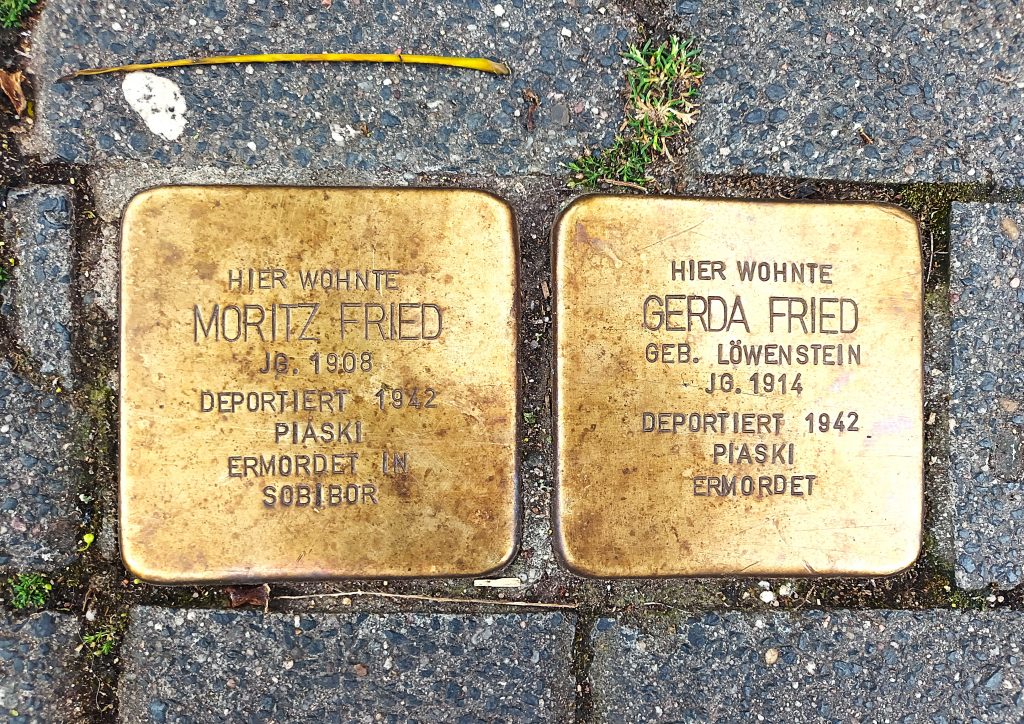
The old Jewish cemetery in Mainz , along with the one in Worms, is a very important part of the cultural heritage. This is because they are among the oldest Jewish cemeteries in Europe.
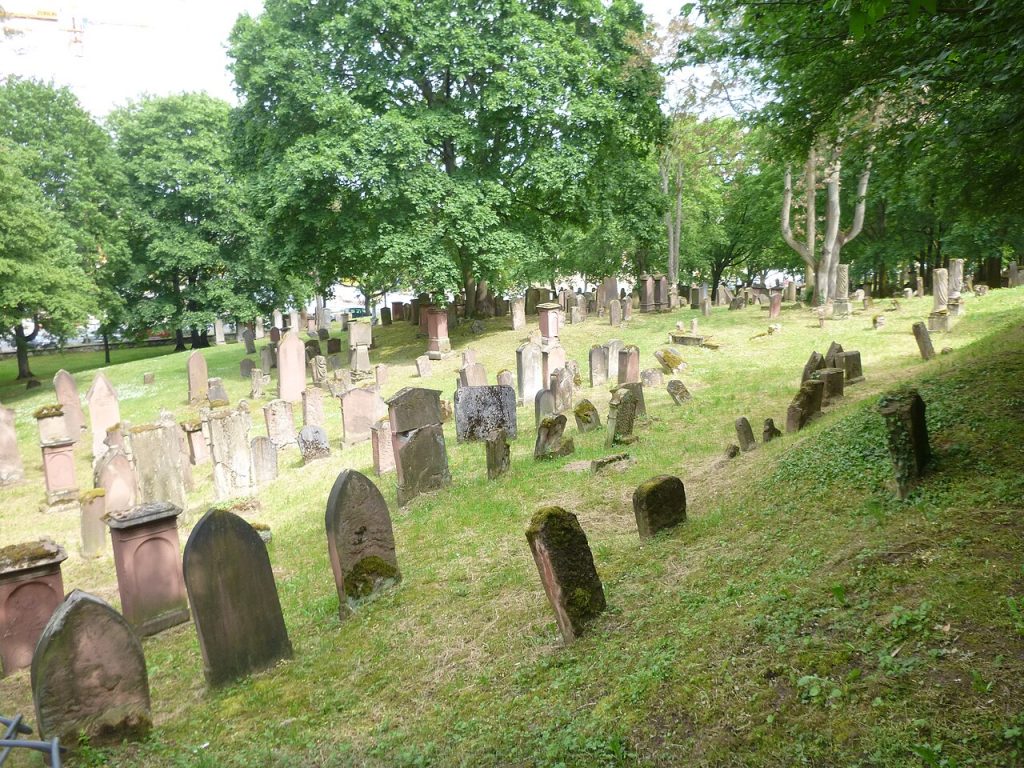
The one in Mainz was used from the 11th century until the 19th century. It consists of several sections, with a new one being built in the 17th century. It was used until 1881, before the opening of the city’s new central cemetery.
Like the opera house in the business district, Frankfurt is above all a city of encounters and fruitful exchanges in all fields and between different populations since the Middle Ages, but also a witness to and actor in great violence, as was the case during the Holocaust.

From Goethe to the prestigious university that bears his name, from the Main River, which flows alongside museums and rebuilt neighbourhoods, to its international airport, the fourth largest in the world and the fourth largest financial centre in Europe, this city of less than one million inhabitants offers visitors a chance to (re)discover and find inspiration, between the past and the future, a theme so dear to Hannah Arendt, like this artistic vision of David and Goliath in the heart of the shopping district…

History
The Jewish presence in Frankfurt dates back to the 12th century. The oldest residences were located in the city centre. As a free city of the Empire, Frankfurt welcomed Jews from 1150 onwards, mainly merchants from Worms. Over time, they were victims of pogroms, expelled and protected according to the political decisions of the day.
In 1460, the Frankfurt City Council decided to establish a Jewish ghetto. Over the next two years, the hundred or so Jews living in Frankfurt were forced to move to what is now known as the Judengasse (‘Jewish alley’). This was an area of the city separated from the rest by walls, where up to 3,000 people were crammed together in 1610. Large yeshivot developed there, attracting students from all over Europe, as in the cities along the Rhine.
Despite such restrictions, there was considerable interaction between Jews and Christians in various areas, including work and crafts, particularly the production of Jewish ritual objects by Christian craftsmen. There were also theological encounters between Jewish and Christian thinkers, not to mention moments of celebration and reunion in the city’s establishments.
Forced to live in the ghetto, institutions were developed to manage social, educational and religious affairs. Within this life cut off by the gates of the ghetto, trades diversified, whether in commerce, crafts, teaching, domestic service, etc. Although from the 17th century onwards, many Jews worked as merchants, particularly at fairs, trading textiles, spices and metals.
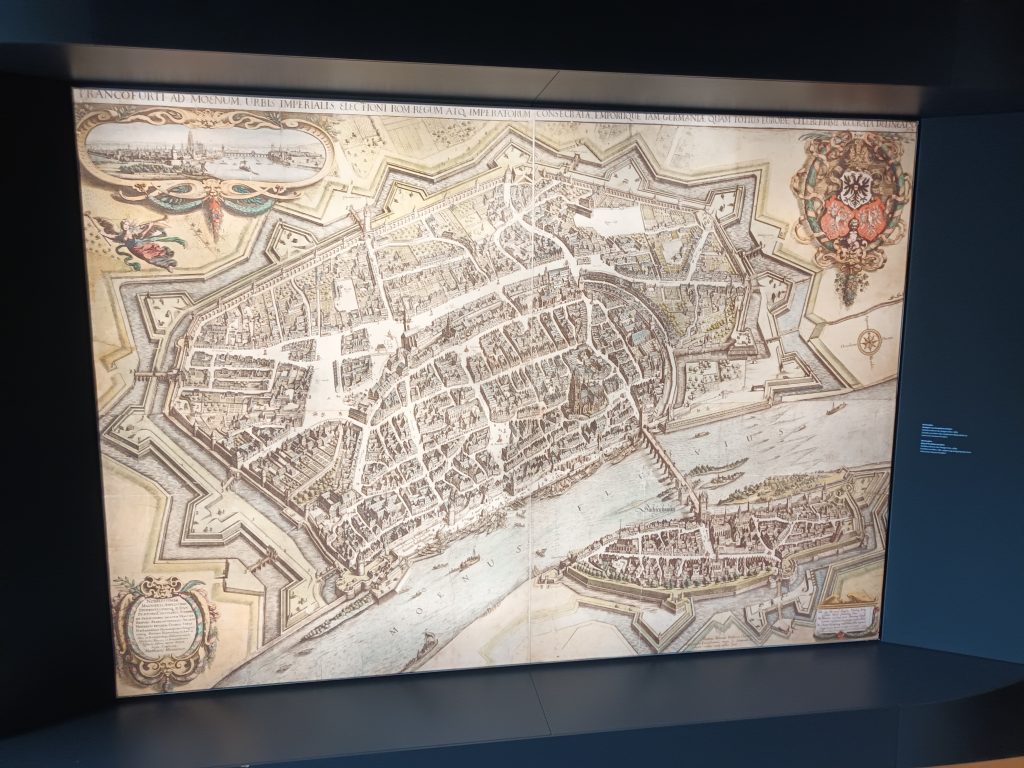
In the 1980s, ancient documents written in Yiddish were found in a geniza in the Veitshöchheim synagogue. Literary and musical production was very rich during these years of life in the ghetto.
It was not until the turn of the 19th century that Jews were allowed to leave the ghetto. During this century, Frankfurt became one of Europe’s main publishing centres for works in Yiddish. The continuity of exchanges and mutual inspiration between Jewish and Christian populations continued in the literary and musical fields. For example, Jewish songs were composed to Christian melodies and Christian tales were inspired by Yiddish works.
At that time, Mayer Amschel Rothschild (1744-1812), a student from a modest family, became interested in mathematics and finance. He did an internship at a bank in Hanover. Becoming a money manager in the Frankfurt ghetto, he diversified his activities and made a name for himself in the world of finance and at court. His five sons settled in London (Nathan), Paris (James), Vienna (Salomon), Naples (Carl) and Frankfurt (Amschel) to develop the dynasty known as much for its success as for its generosity.

Officially authorised to live in areas other than the Judengasse in 1811, the Jews first moved to the surrounding Ostend district and then a little further into the city. They played a full part in the cultural, educational, social and economic development of Frankfurt. But it was not until 1864 that they were considered fully equal citizens.
This gradual evolution can be seen in the works of Moritz Daniel Oppenheim (1800-1882), the first Jewish painter to receive an academic art education in Germany. His paintings depict family and religious scenes as well as portraits. They also depict figures participating in cultural and literary life, representing the way in which Oppenheim and many Jews fully embraced the emancipation that was finally within their grasp. In this spirit of encounters, a painting by Oppenheim from 1864 depicts Felix Mendelssohn Bartholdy’s visit to Goethe. The Jewish musician was proud to play for the prince of poets.
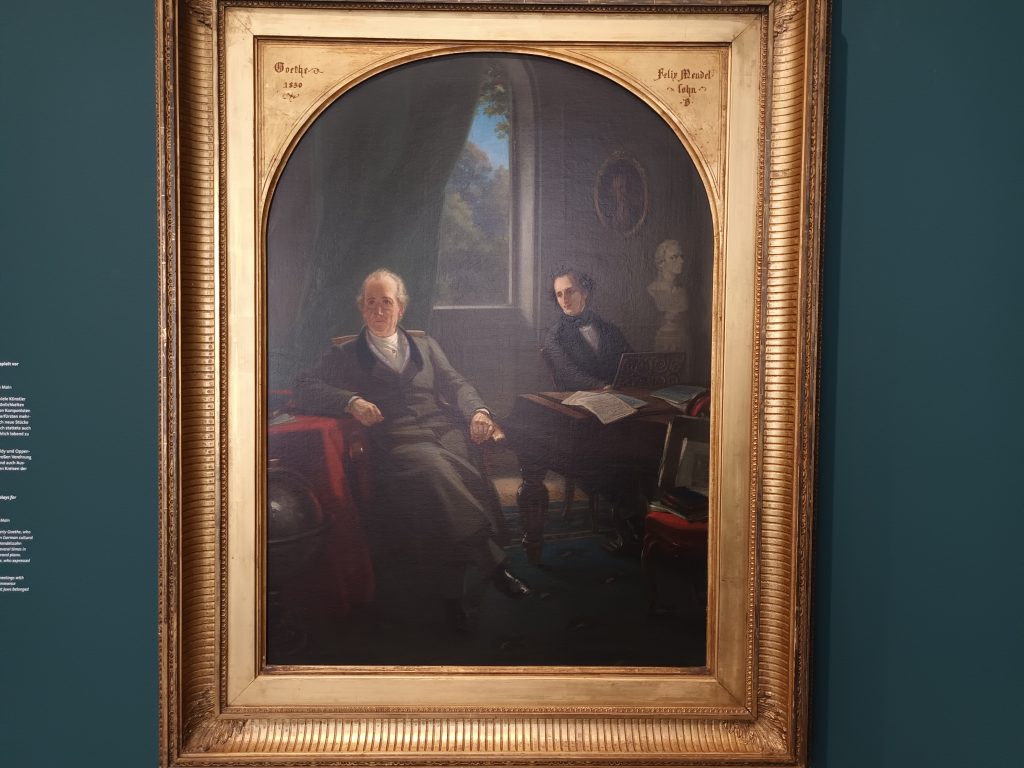
Jewish religious life in Frankfurt at the time was marked by this desire for initiative and diversity. In the 19th century, Rabbi Leopold Stein introduced liberal reforms. This encouraged passionate theological debates with Samson Raphael Hirsch, who was of an important figure of the neo-orthodox movement. Various places of study emerged, including the ‘Free Jewish Study House’ where Martin Buber (1878-1965) taught, led by Franz Rosenzweig.
Three synagogues represented this rich intellectual confrontation: the Masorti synagogue on Börneplatz with its rabbi Nehemias Anton Nobel (1871-1922), inaugurated in 1882; the neo-Orthodox Friedberger Henninger Synagogue of Rabbi Salomon Breuer (1850-1926), inaugurated in 1907; and the liberal Westend Synagogue, where Rabbi Georg Salzberger (1882-1975) established a Jewish adult education centre, inaugurated in 1910. When the First World War broke out, many Jews from Frankfurt fought in the armed forces.
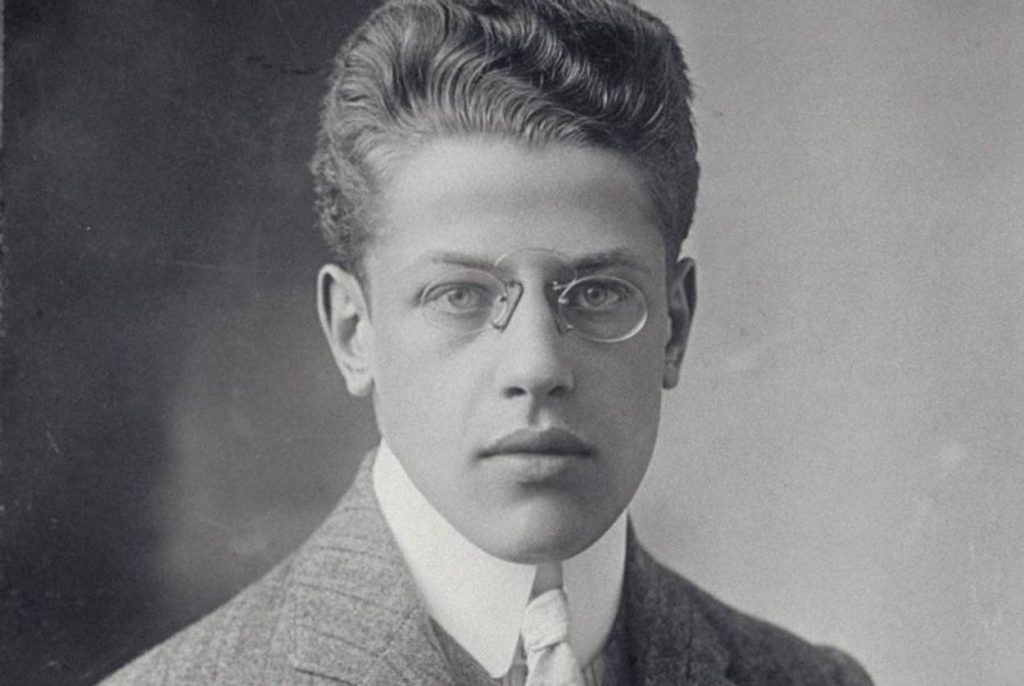
A major intellectual upheaval emerged in the 1920s at the University of Frankfurt with the meeting at the Institute for Social Research of great thinkers, mostly Jewish, the most prominent of whom were Max Horkheimer, Theodor W. Adorno, Herbert Marcuse and Erich Fromm. Encouraging a multidisciplinary approach and a non-dogmatic Marxist vision, as well as taking into account the evolution of society and the cataclysms caused by the wars, the Frankfurt School was born, whose most famous disciple today is Jürgen Habermas.
Nearly 30,000 Jews lived in Frankfurt between the wars. When the Nazis came to power in 1933, they quickly imposed restrictions on Jews, gradually excluding them from the society to which they had contributed so enthusiastically and in so many areas. This was followed by the pogroms of 1938 and the deportations from 1941 onwards.
Only a few hundred Jews managed to hide, protected by Righteous people. Some of the others managed to flee, but more than 10,000 were murdered in concentration and extermination camps. The synagogues on Borneplatz and Friedberg Anlange were destroyed during Kristallnacht on 9-10 November 1938, along with the Museum of Jewish Antiquities, founded in 1922. Although much of its collection was destroyed by the Nazis, nearly 1,000 objects were recovered and incorporated into the current museum.
80% of the buildings in the city of Frankfurt were destroyed or severely damaged. America played a major role in the reconstruction of the city, as well as in the fight against anti-Semitism. A process of denazification was undertaken throughout the country.
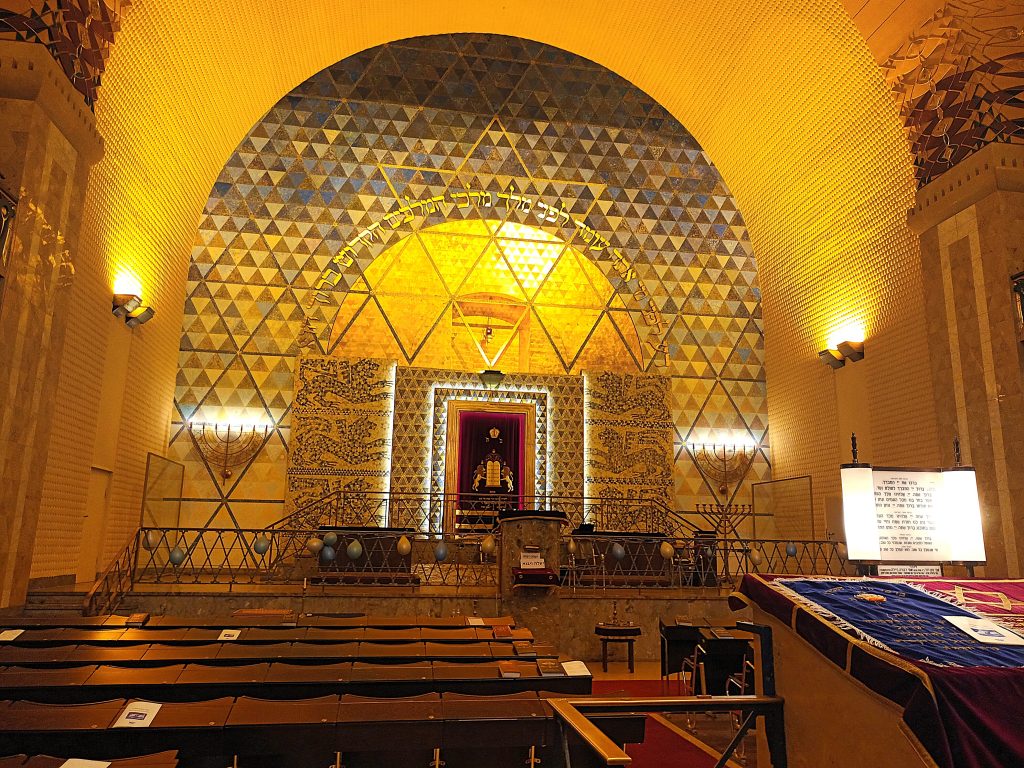
On the eve of Rosh Hashanah in 1945, Rabbi Leopold Neuhaus organised prayers in what remained of the Westend synagogue, the interior of which had been destroyed in the pogrom of 1938. The prayers were held in front of a few survivors and American Jewish soldiers stationed in the city. In 1948, the city and the region committed to subsidising repairs. It was therefore rebuilt and reopened in 1950. Today, it is home to an Orthodox congregation. A room inside the building is used for liberal service.
The desire to honour the memory of the many victims of the Holocaust, but also to highlight the importance of Frankfurt’s Jewish history, led to the creation of a commission to investigate this history, with the help of local authorities. Created in 1961, this commission included Max Horkheimer, Rabbi Kurt Wilhelm and Rabbi Georg Salzberger.

Jewish life was revived in Frankfurt mainly in the 1980s. One of the milestones was the creation of a community centre a few steps away from the Westend Synagogue. As in Vienna, Frankfurt has two museums: the Judengasse , dedicated to medieval Jewish life, and the Judisches , dedicated to contemporary Jewish life. The latter, housed in the former Rothschild Palace, was inaugurated on 9 November 1988 in the presence of German Chancellor Helmut Kohl, marking the 50th anniversary of the 1938 pogrom.
In 1987, during redevelopment work on Frankfurt’s Börneplatz, where one of the former synagogues was located, 19 former houses from the Judengasse were discovered. Opposition arose between the city council, which wanted to erect a municipal building on the site, and people who wanted to preserve these rare traces of the former Jewish ghetto. A compromise was reached and five of these former houses were included in the Judengasse Museum, which opened in 1992. These houses form the central element of the museum.
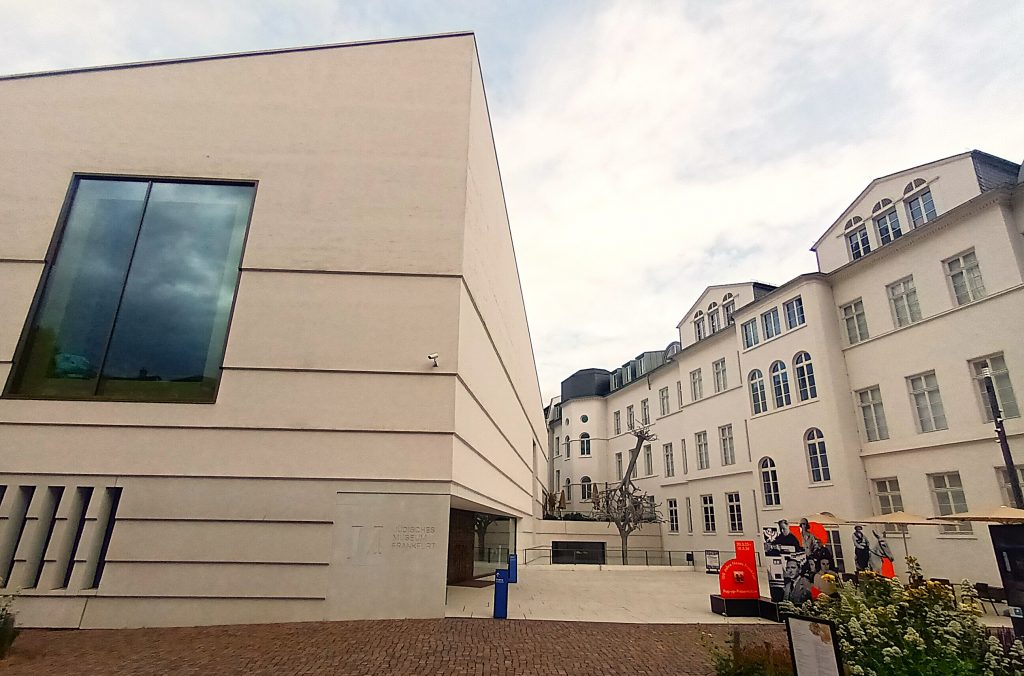
Following the end of the Cold War, many Jews from Eastern Europe settled in Frankfurt. Today, there are estimated to be more than 6,000 Jews living in Frankfurt.
In 2021, Goethe University Frankfurt inaugurated a department of Jewish studies named in honour of Martin Buber and Franz Rosenzweig. The inauguration took place on the 143rd anniversary of Buber’s birth. He had once taught at the university before being expelled by the Nazi regime.
As was the case in many other places in Europe, Jews in Frankfurt experienced a rise in anti-Semitism at the turn of the 21st century. This anti-Semitism has become increasingly violent since the pogrom of 7 October 2023. Among the regular victims of these attacks is the Maccabi Frankfurt football team. This was also the case during a violent attack in Grunburg Park in August 2025.
The Judengasse Museum
As you walk through the museum doors, you are plunged into the history of this particular place. Such as the day when the synagogue was burned down on Börneplatz. Then we read about the debates concerning the redevelopment of this space. A room shows how the neighbourhood has changed over time. Old objects are on display, including a menorah, a Megillah Esther and the Passover Haggadah, to explain Jewish rituals.
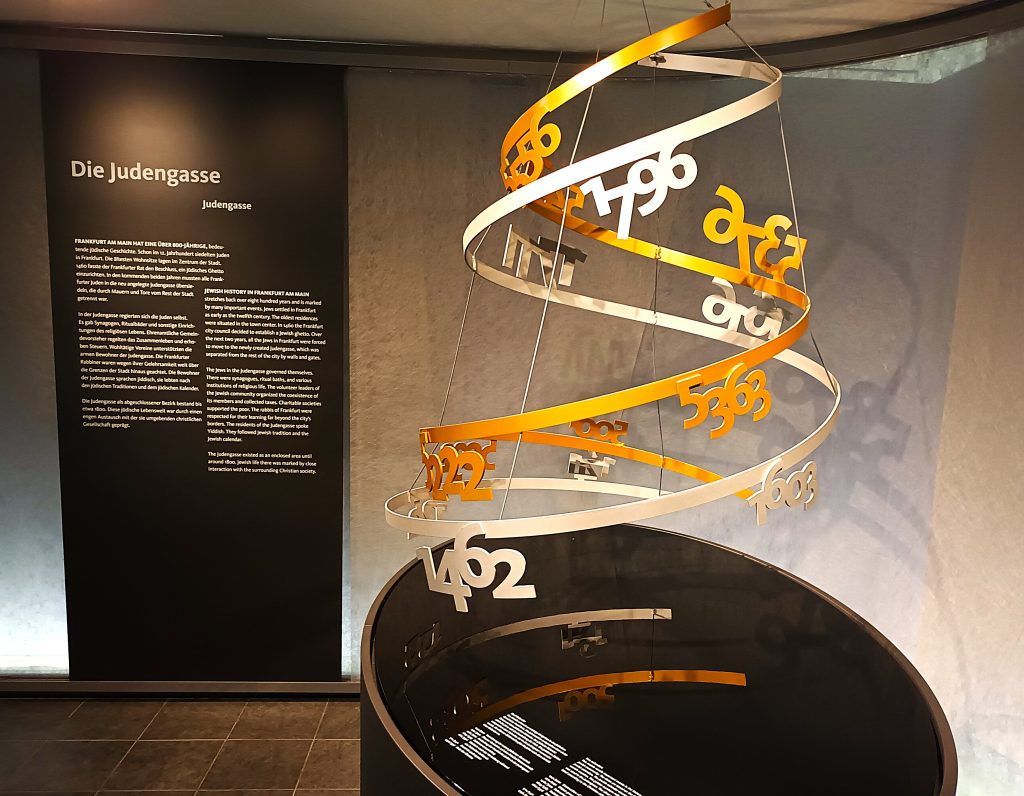
Panels present the property restrictions and heavy taxes imposed on the Jewish population when they lived in the ghetto. Decrees bear witness to the changing status of Jews in Frankfurt.
A very interesting feature of the museum is a table on which the former Jewish ghetto is drawn. Visitors can put on headphones and plug them into the holes corresponding to the different dwellings, institutions and shops. Recordings recount the daily life of the Jews at that time, describing the places, their roles and some of the people who lived there.
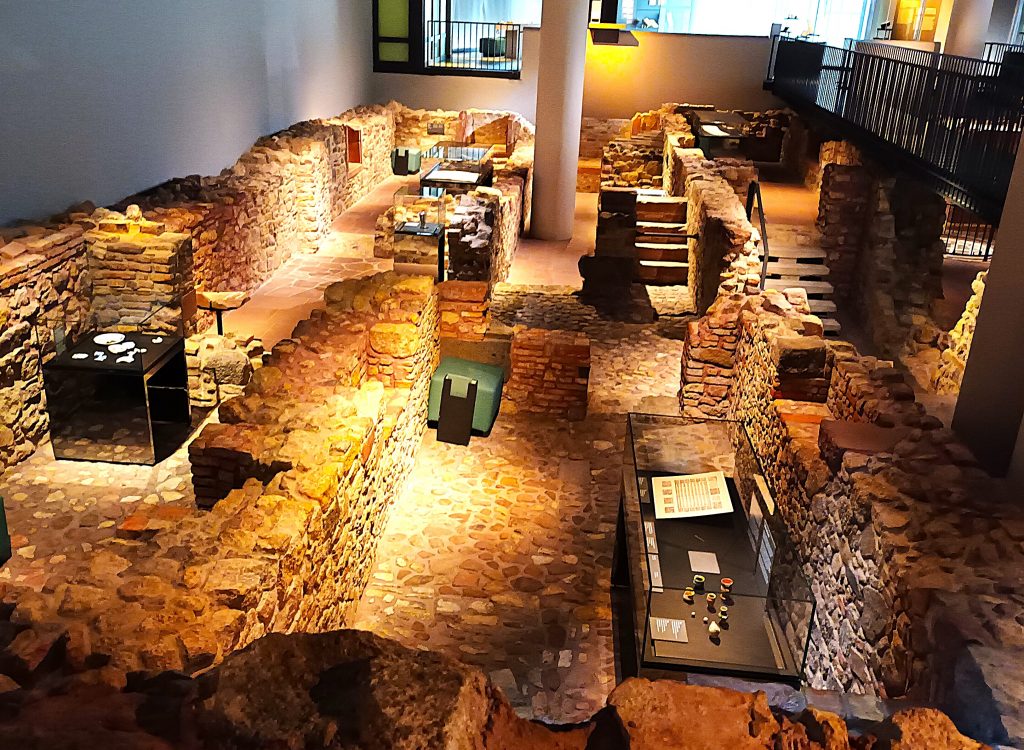
The museum is on two levels. The lower level houses the foundations of old buildings (houses, wells, mikvahs, etc.) from the ghetto and justifies why the museum was founded. Small books placed next to the seats explain the life of the Jews of yesteryear, as well as certain rituals, such as the preparation of matzos. Among the objects on display on this level are some found during the renovation of the neighbourhood, including an 18th-century circumcision cushion.
One area is dedicated to literature and music, with 13 ancient scrolls on display. Among them is an 18th-century book found in a genizah, with a drawing illustrating the text of a character who looks a little like a heel Marvel superhero. Among the most precious objects is a 14th-century mahzor.
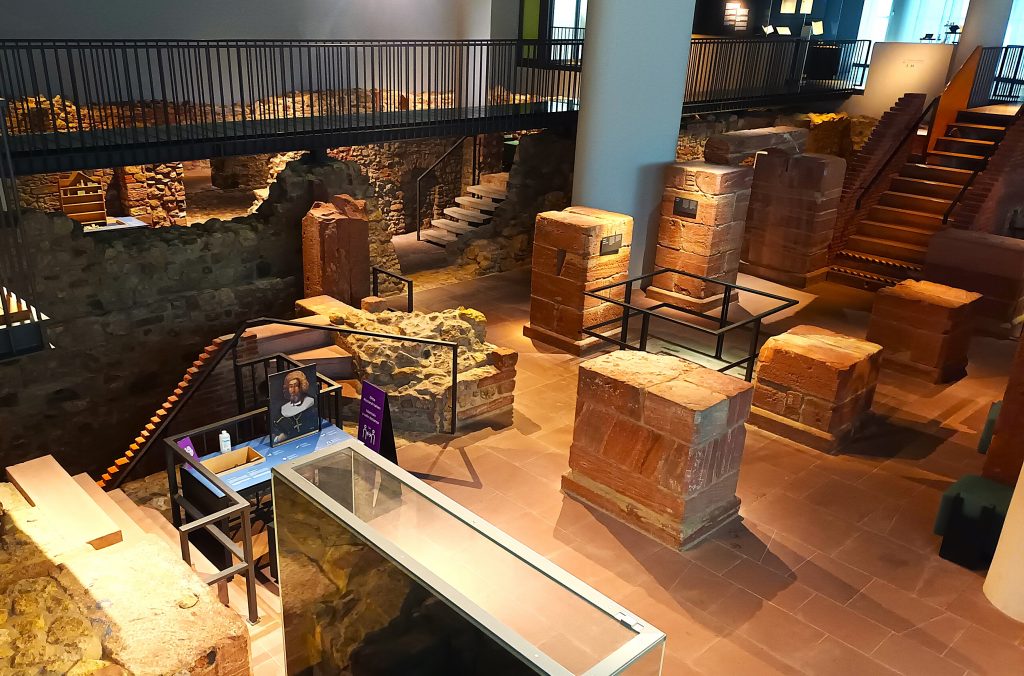
The museum makes a great effort to humanise the ancient life of the Jews of the ghetto, telling personal stories with objects that are just as personal. Maps showing where they lived are also displayed as part of this effort to reconstruct their lives. This shows that the traces of the past are not limited to stones. In the buildings they lived in and between the walls, writings, stories and words were shared by characters sometimes in colour, sometimes in pastel shades, reassured or anxious depending on the period.
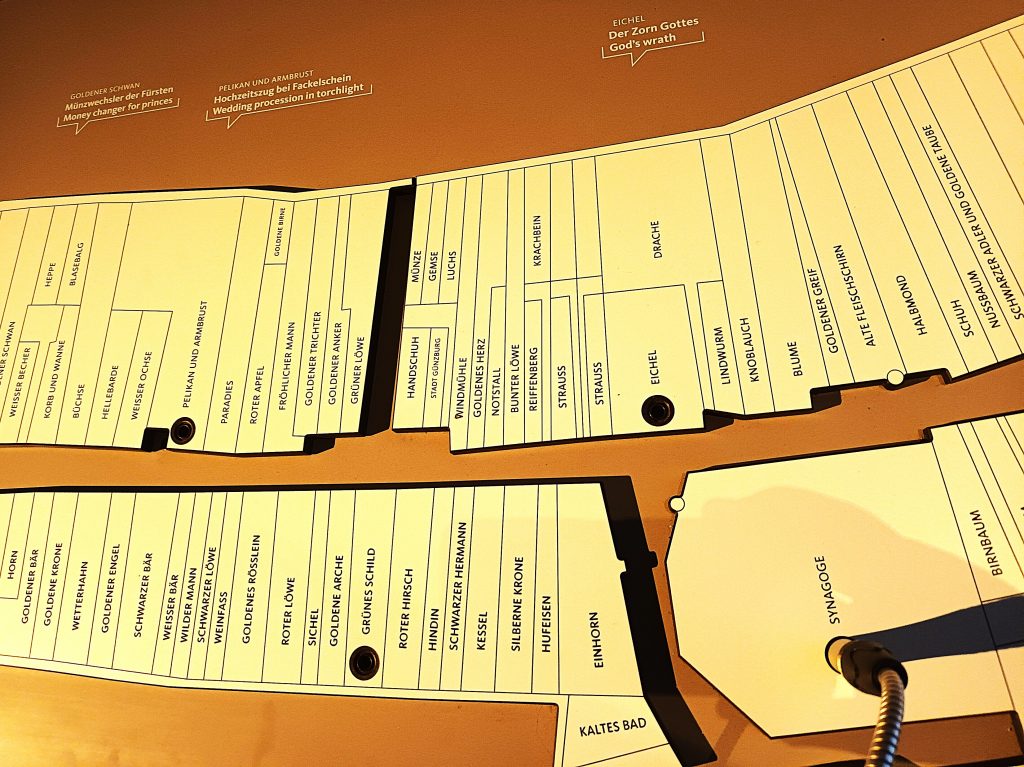
On leaving the room, panels tell the story of the Jews of Frankfurt through the centuries, summarised in a few photos of emblematic places and moments. There are other curiosities in this alley, such as pipes used as drains.

Once you have finished your visit to the museum, turn right and walk along the wall of the ancient Jewish cemetery , where stones have been placed in memory of the victims of the Holocaust. To visit this site, you must ask the museum for a key to gain access. As in the old Jewish cemetery in Prague and other German cities such as Worms, there are some very old gravestones.
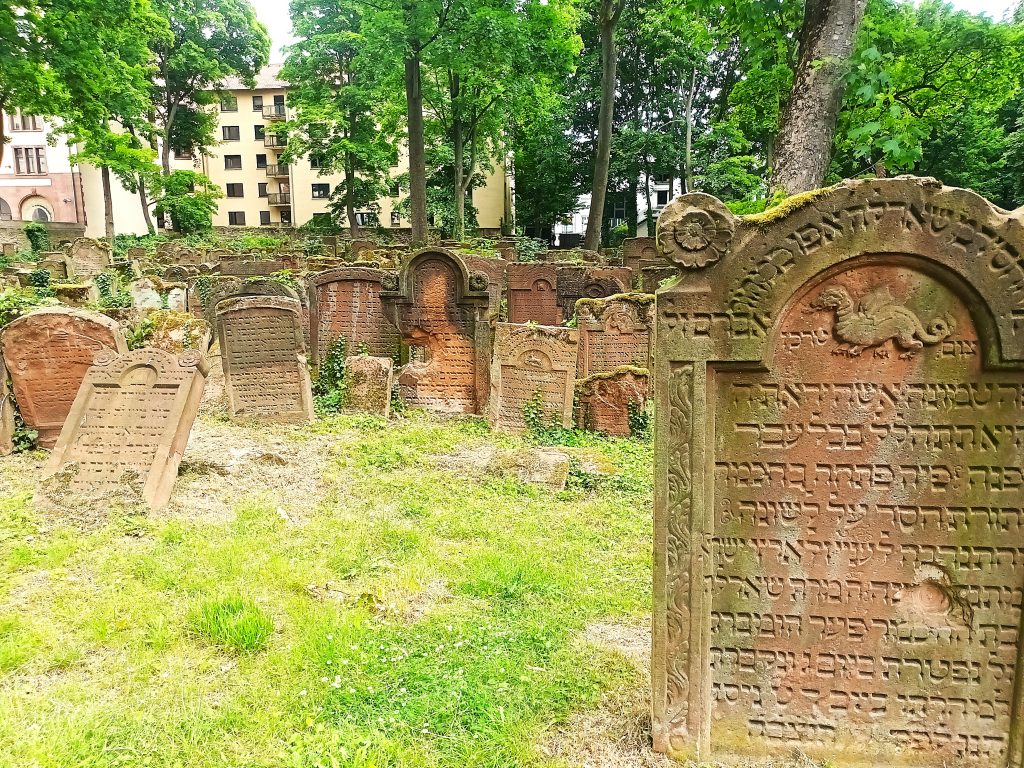
Between the city’s two Jewish museums is the ‘new old town’, which was restored after the war. Take the time to stroll around and discover a wealth of monuments, including official buildings, places of worship and museums.
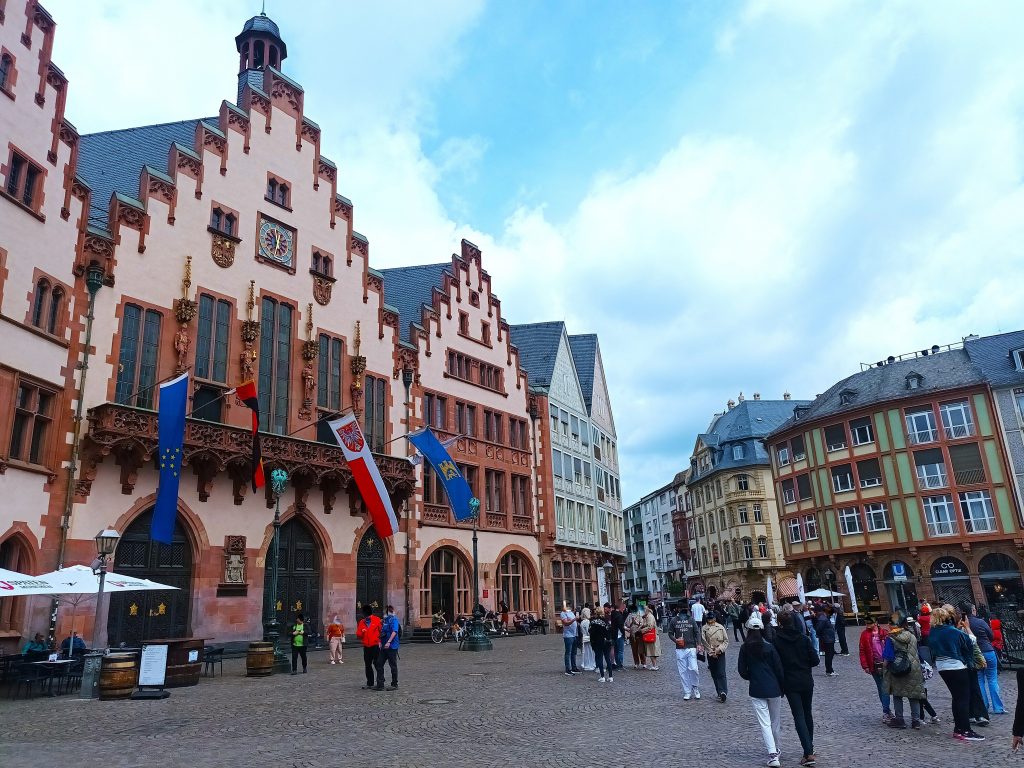
These include the beautiful Frankfurt Imperial Cathedral with its impressive organs.
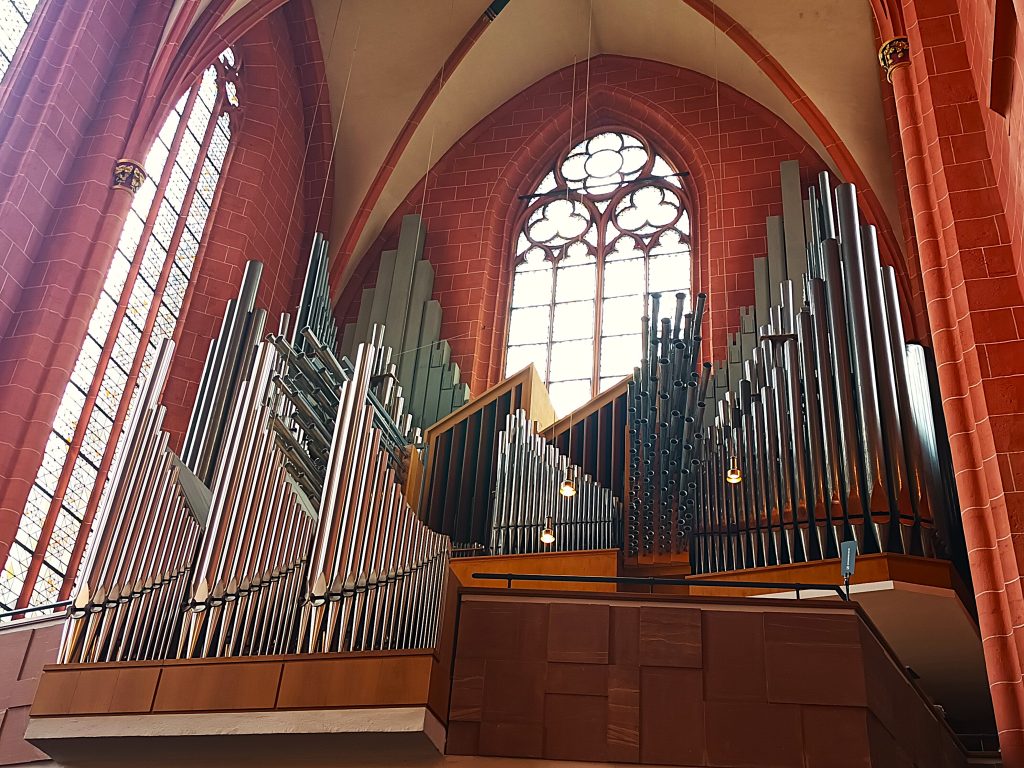
But also the historic Römerberg market square with its festive attractions in summer and winter, the Frankfurt History Museum, the Caricature Museum and the Goethe Museum.
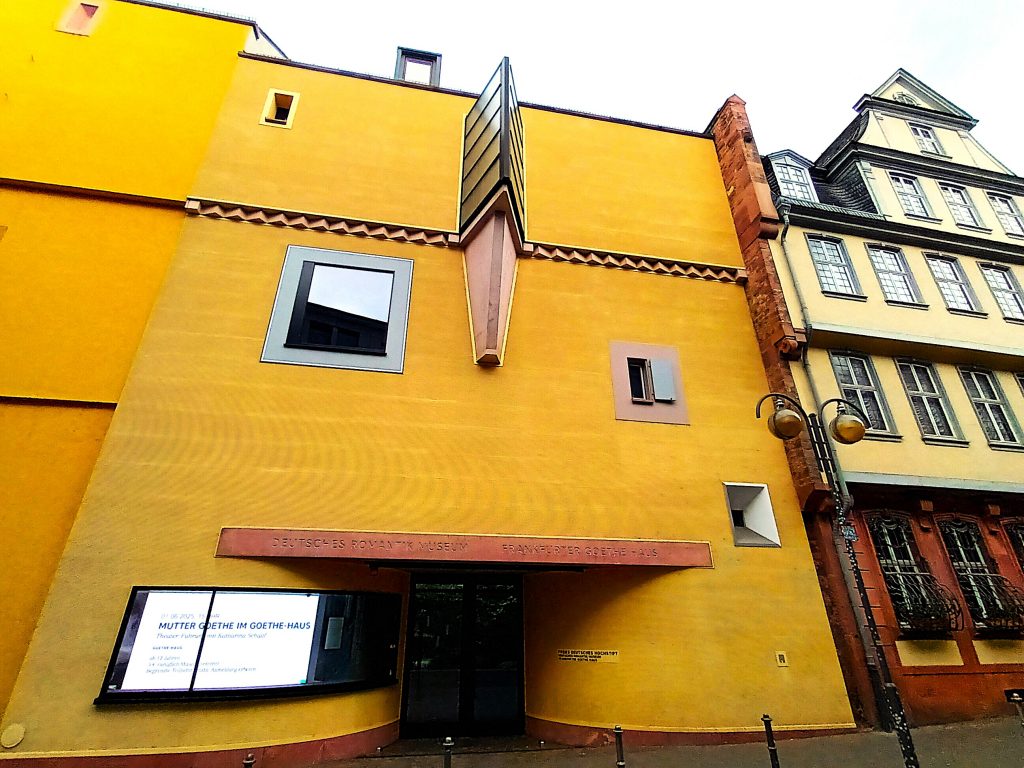
A bronze plaque designed by stonemason Uwe Risch, installed in 2000 at 22 Braubachstrasse, commemorates the persecution of the Sinti and Roma by the Nazis.
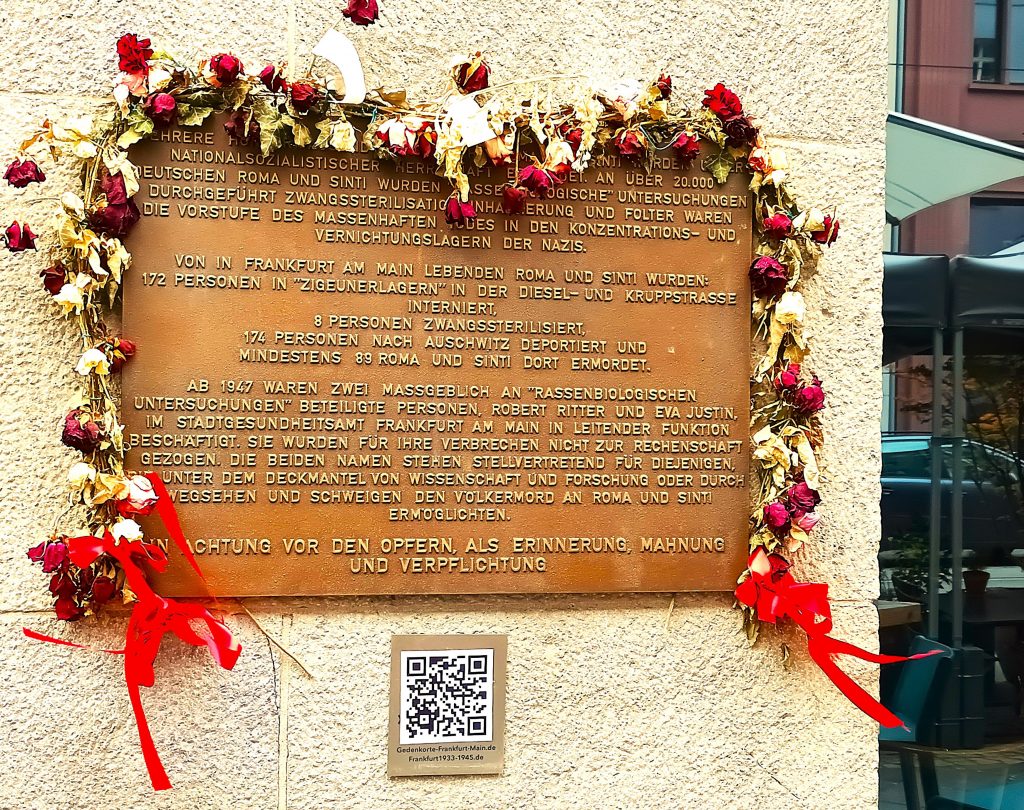
The Jewish Museum
The tour begins on the third floor, a new floor dedicated to contemporary Jewish life in Frankfurt. Visitors are greeted by a screen showing different faces belonging to different generations. Then, as they enter the room, the story of these people is told through old photos and personal objects. Among the moving and surprising photos is one of the German ice hockey team’s visit to the 2017 Maccabi Games. They can be seen posing in uniform in front of the Western Wall, some even with their skates on!

We travel through the 20th century, evoking discrimination, anti-Semitism, the liberation of Frankfurt by American soldiers, and their work to denazify the country and its institutions. But also personal stories of people who managed to survive and believed in a possible return to Germany, as part of the eventual reconstruction of Jewish life in Frankfurt. Among the contemporary symbols of this reconstruction is Maccabi Frankfurt, with its moments of glory, but also the anti-Semitic attacks it has suffered and continues to suffer on a regular basis.
Another complex contemporary issue addressed is the restitution of artworks looted during the war. The museum presents the story of a painting by Matisse, which was stolen and recovered much later…
Leaving the large main hall, visitors enter a series of small rooms. The first tells how the building was bequeathed by the Rothschild family to be used as a Jewish museum. Next are paintings by Daniel Moritz Oppenheim. These include biblical works, such as an impressive Moses, as well as paintings depicting Jewish life in Frankfurt in the 19th century and the great meeting between Mendelssohn Bartholdy and Goethe.
Great minds do not always produce great ideas. The next room is dedicated to infamous anti-Semitic quotes from influential thinkers throughout history. Visitors then discover works by contemporary local artists and learn about the lives of Jewish residents of Frankfurt in the 20th century through a series of postcards, each telling a story.

The second floor of the museum is devoted to Jewish tradition and rituals: a kiddush cup, a shofar, two large menorahs and a parokhet. Another room presents the history of Jewish thought in Frankfurt, which, as we mentioned earlier, was quite rich.

And if you still have doubts or questions about the different currents of Jewish thought that arose and developed in Frankfurt in beautiful harmony, you can ‘ask a rabbi a question’. Combining biblical thought and technological tools, a device allows you to ask rabbis from different traditions questions on a wide range of topics. You can then listen to their recorded answers on these topics, compare them and draw inspiration from different interpretations.
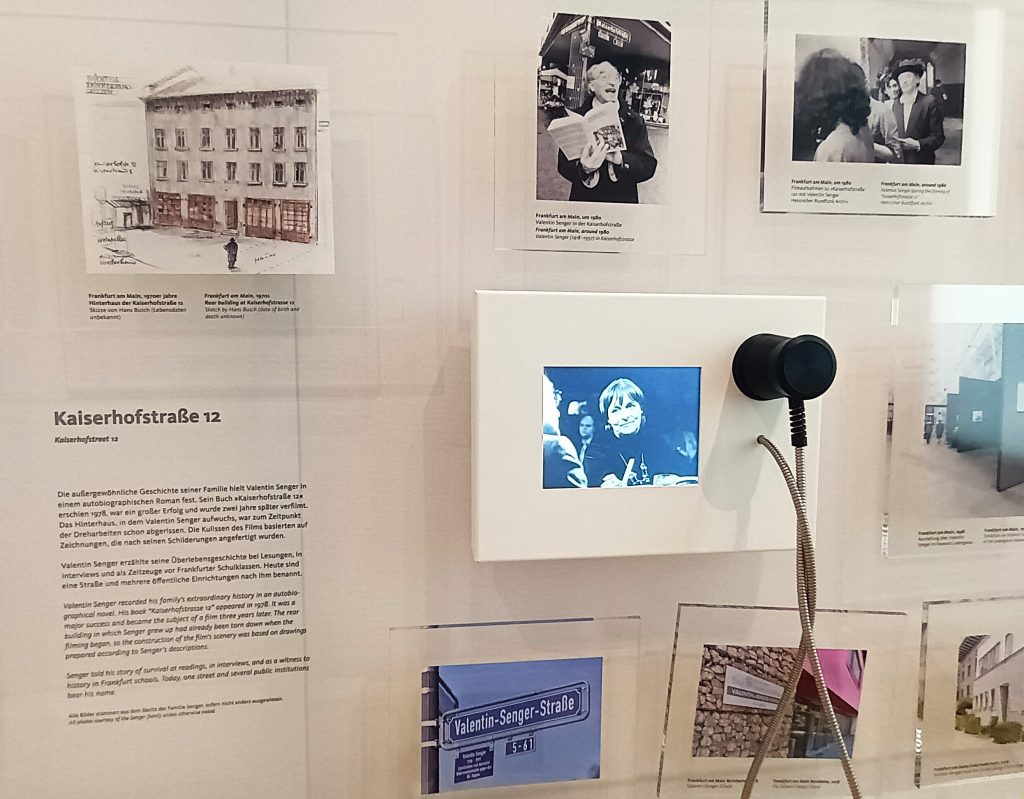
The first room on the first floor is dedicated to the Senger family. Photos and testimonials, as well as the book Kaiserhofstrasse 12, tell the story of this family of Russian origin and what happened to them during the war.
Another room briefly presents the history of the Rothschild dynasty. Its origins in Frankfurt and its development in Europe, as well as all the activities in which the family was involved. Among these activities, the most important was probably tzedakah. This term means ‘justice’ and not ‘charity’, as it is commonly translated. Justice for those who are fortunate enough to succeed in their field, while being generous to others through financial donations, their time and/or their talent. Visitors can discover the history of the five Rothschild sons, as well as the women of the family who played an important role.

The museum tour ends in the room dedicated to Anne Frank (1929-1945). It tells the story of the young girl and her father, who, after the war, shared his daughter’s writings in a spirit of Tikun olam.
From East to West
During the infamous Kristallnacht, from 9 to 10 November 1938, the Nazis launched pogroms across the country and destroyed many synagogues, homes and businesses belonging to German Jews. Among the synagogues destroyed was the Friedberger Anlage . The authorities built a bunker on its ruins in 1942. It was located in the Ostend district, which was developed in the mid-19th century to accommodate middle-class and working-class tradespeople and artisans.
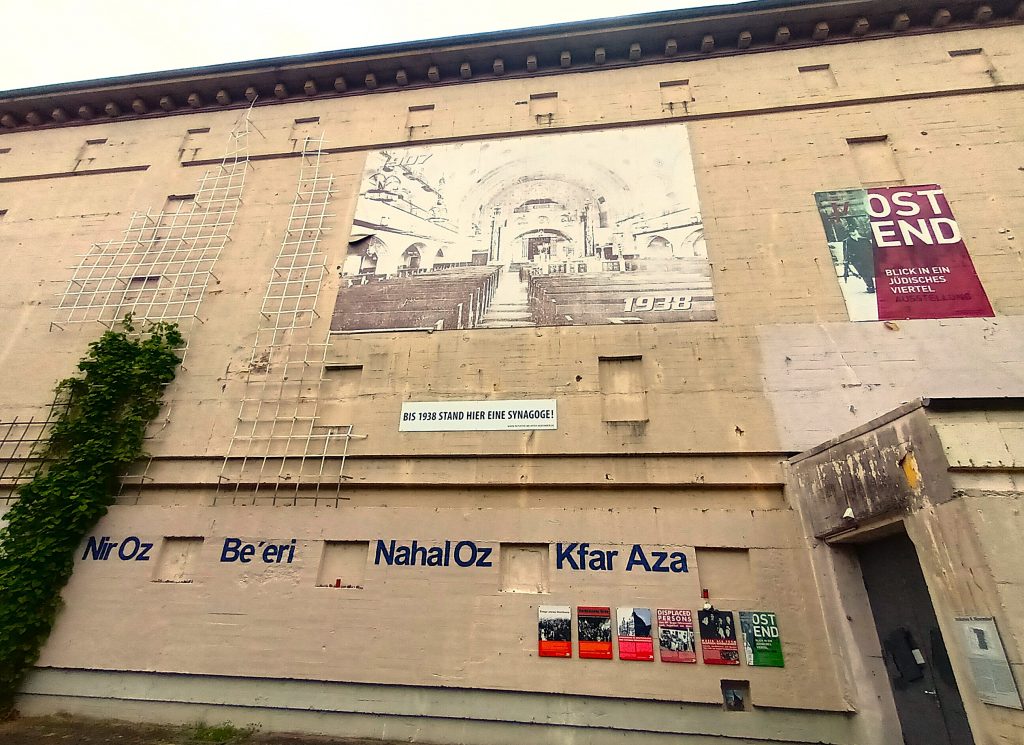
Many Jews had settled there in the early 19th century, when they were allowed to leave the ghetto. By 1895, Jews made up nearly a quarter of the neighbourhood’s population.
After the war, the bunker was converted into a memorial site, with an area recounting the history of the Jews in this neighbourhood from the early 19th century to the Second World War. On its walls are references to the kibbutzim that were victims of the pogrom of 7 October 2023.
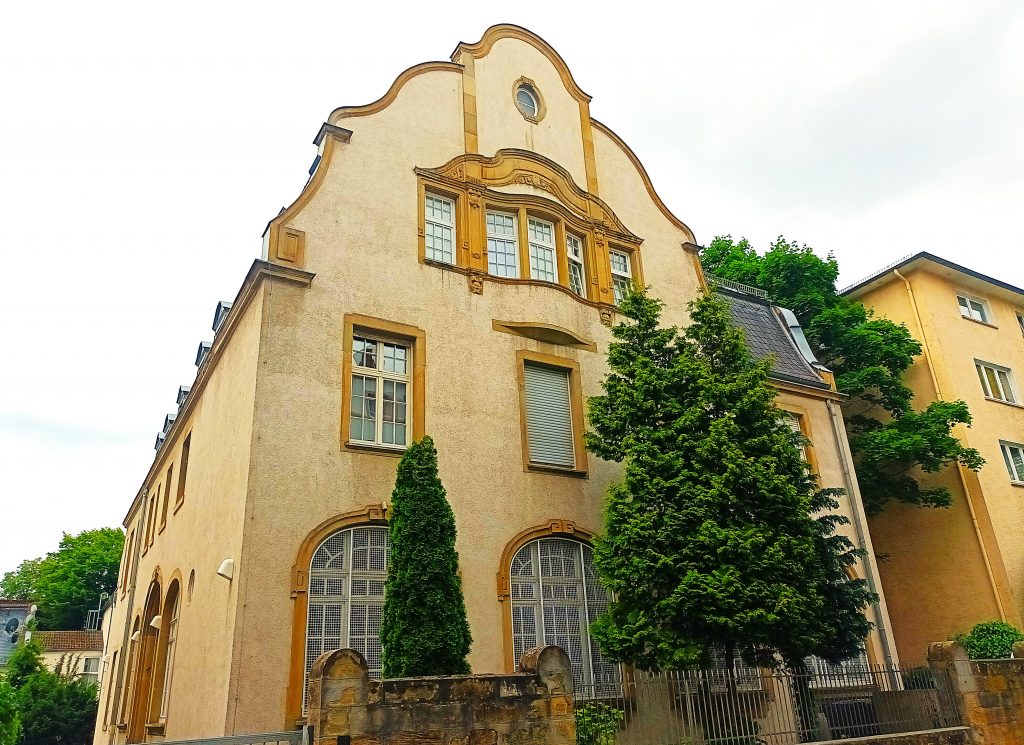
Although Jews tentatively returned to Ostend after the war, they more often chose to settle in Westend. In fact, only a few social institutions remain in Ostend, along with the Baumweg synagogue .

This former building, which housed a Jewish kindergarten confiscated by the Nazis, became a synagogue in 1945.
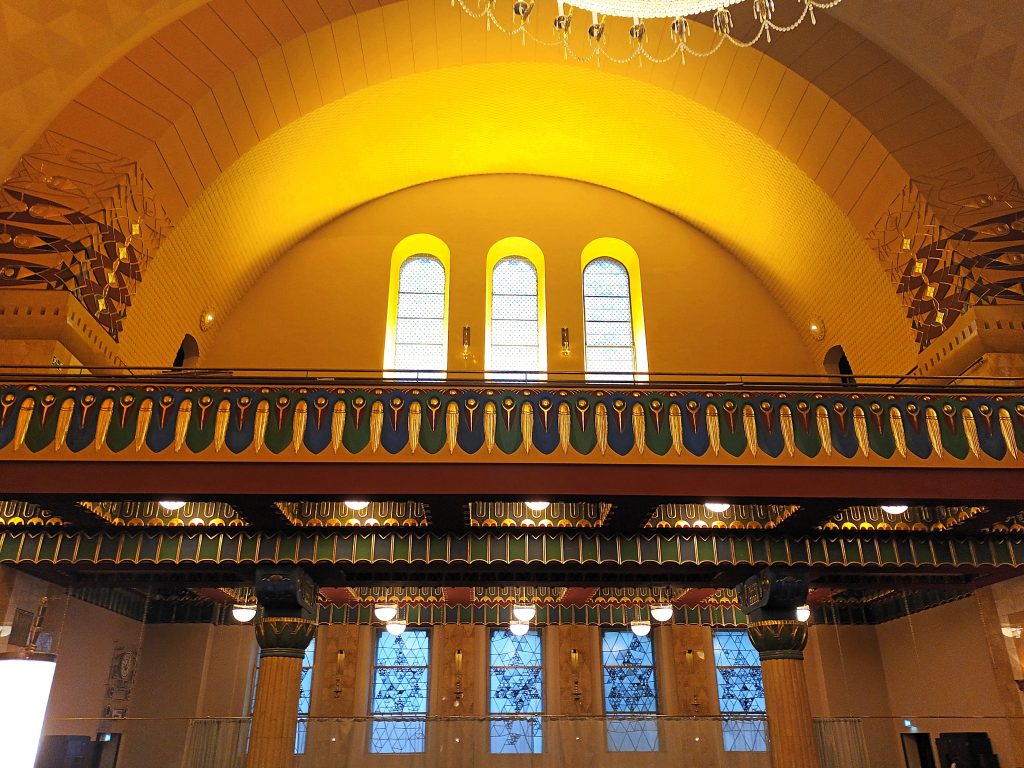
The Westend district is therefore home to most of the contemporary institutions, as the website of the Jewish community in Frankfurt points out. The Westend synagogue is undeniably one of the most beautiful in Europe, restored to its original splendour a few decades after its partial destruction.
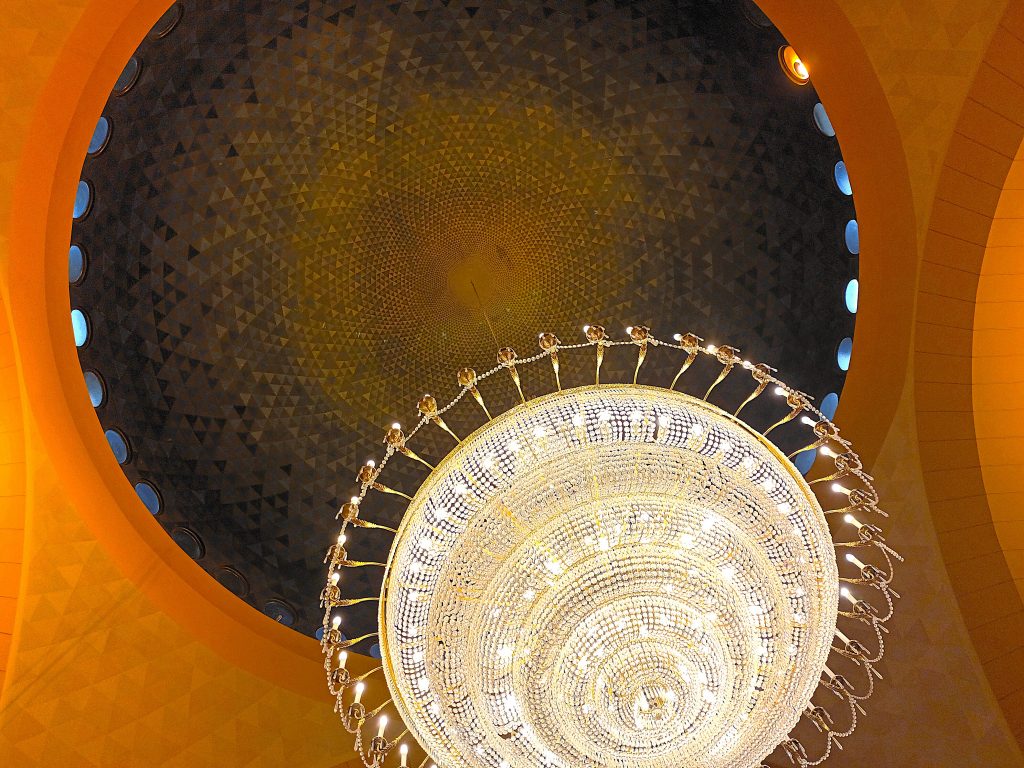
A few hundred metres above the synagogue is the beautiful campus of Goethe University Frankfurt. With its buildings, each dedicated to a faculty, and its long lawns that surround them, it has a light-hearted atmosphere. An American-style campus with a deep German spirit, it is reminiscent of the Ramat Aviv campus and the Hebrew University of Jerusalem.
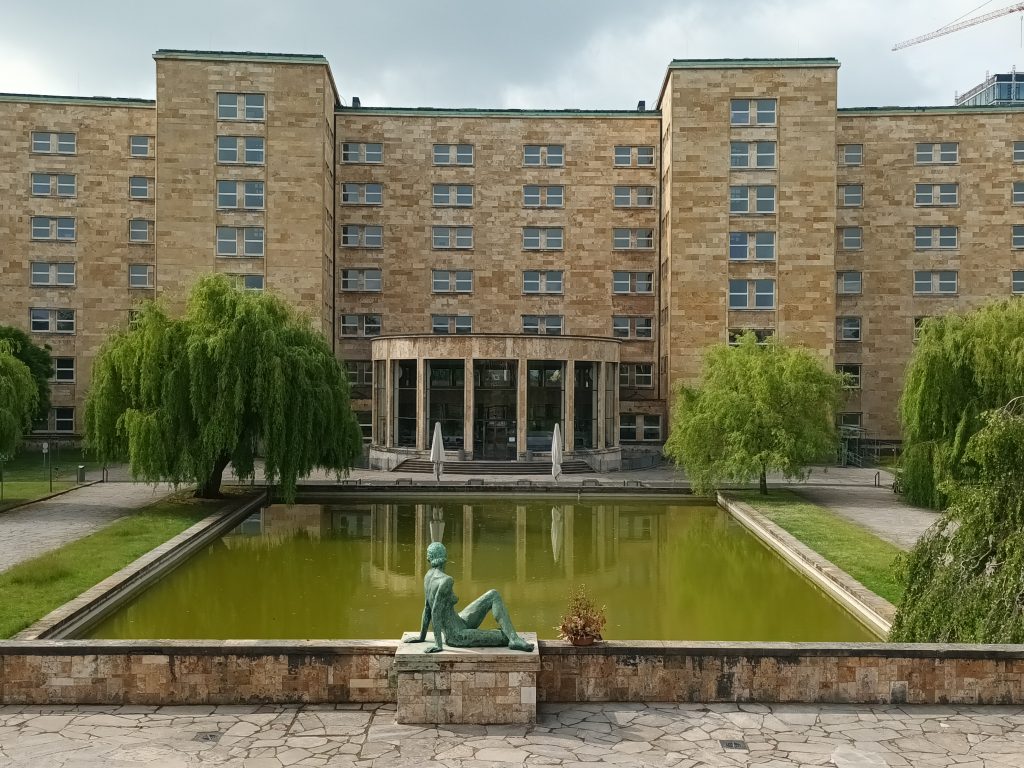
On Theodor W. Adorno Platz , named in honour of one of the founders of the Frankfurt School, there is a desk, a chair, a lamp and other objects placed on the desk, all under a glass dome. This work by Russian artist Vadim Zakharov was unveiled in 2003 to mark the 100th anniversary of the thinker’s birth.

About 20 yards away is another intriguing work symbolising the open-mindedness and exchange of ideas in the city, and in particular its university: the ‘Body of Knowledge’, created by Spanish artist James Plensa in 2010 and composed of letters from different alphabets.
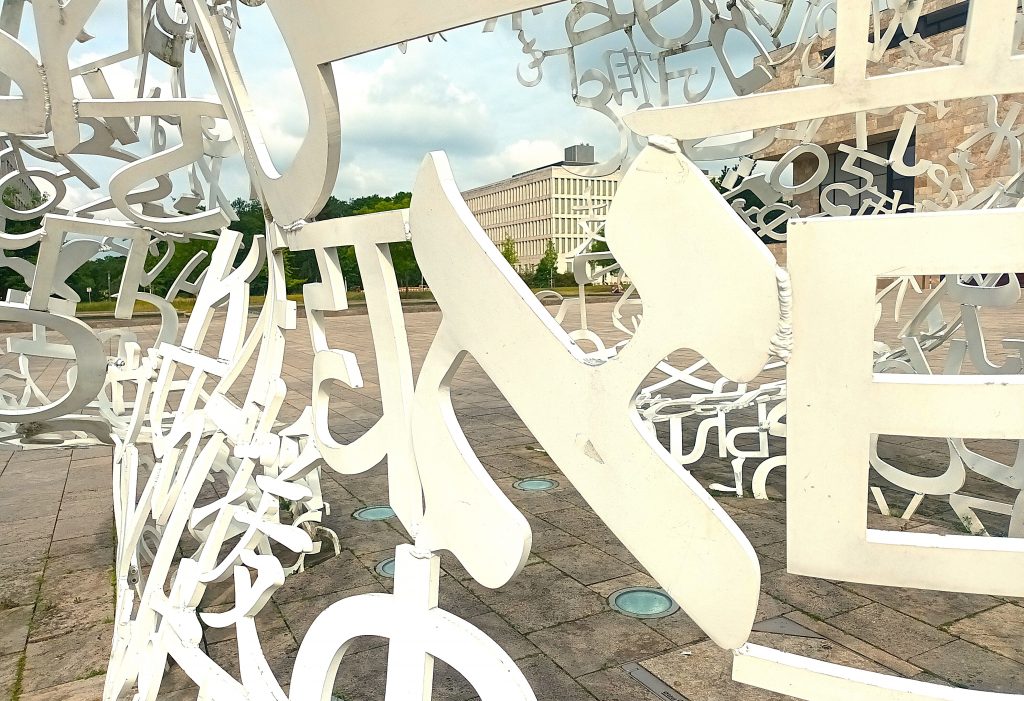
Going back up Theodor W. Adorno Platz and Max Horkheimer Strasse, two kilometres to the north, in the Dornbusch district, is Sinai Park. 300 metres away, on Ganghoferstrasse, you will see the former home of Anne Frank’s family before they moved to Amsterdam in 1934.
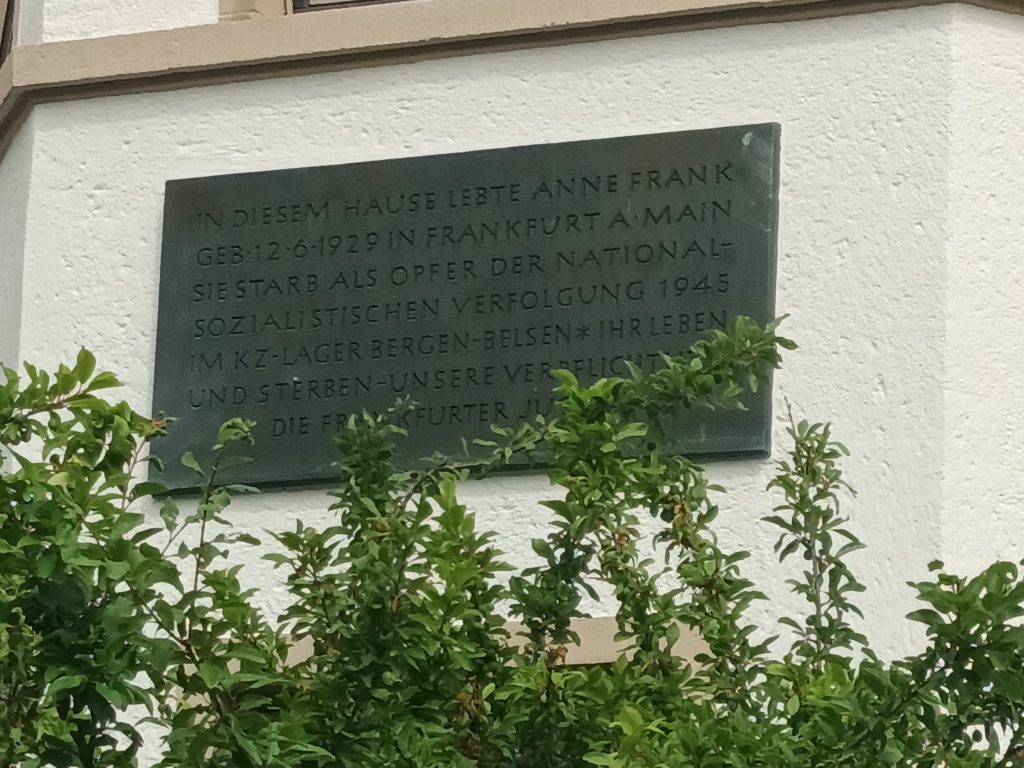
Three tram stops separate Goethe University from Anne Frank’s house, which is also a convenient way to return to the city centre.

And who knows, you might find yourself on a tram bearing the colours of Maccabi Frankfurt…
The small city of Friedberg possesses the deepest mikveh in Germany: seventy-two steps carved into the basalt lead the visitor to a natural spring situated eighty-two feet below the surface.
At the bottom of the staircase, a stone tablet dedicated to the builder of this bath displays the date of its origin in 1260.
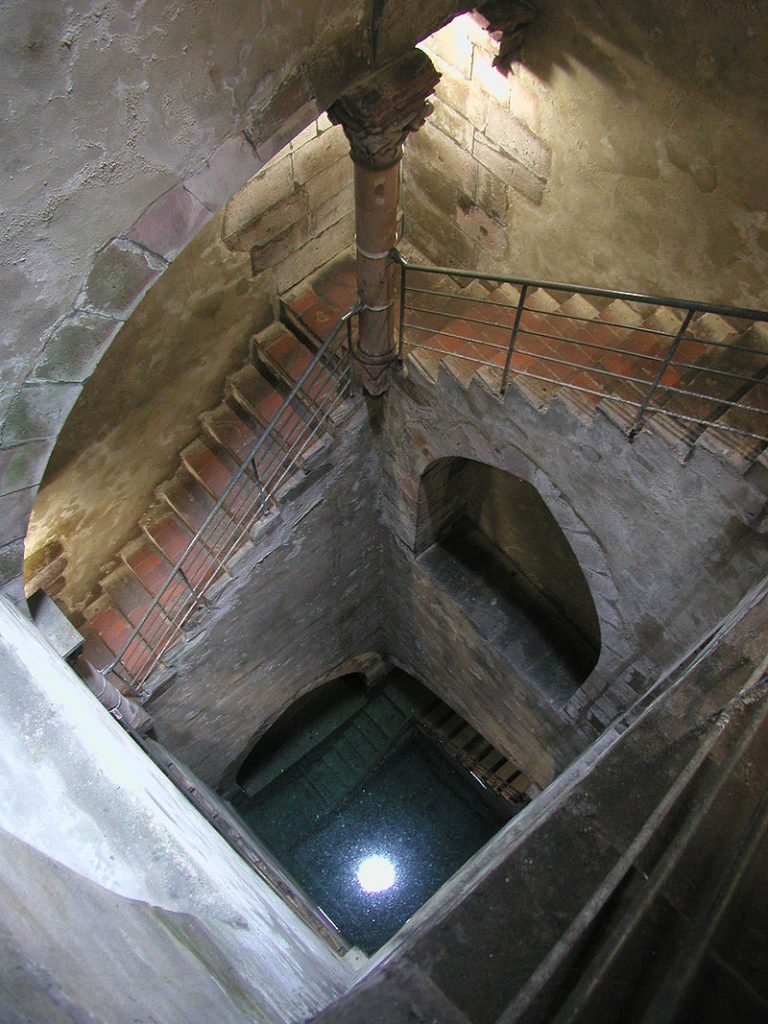
An octogonal opening in the dome above is the sole source of light and gives the illusion of the moon’s constantly shining in the somber depths of the water.
Once a prosperous Jewish Community, it was decimated during the Holocaust. Among the famous people from the city, one can find the entrepreneur Ernest Oppenheimer.
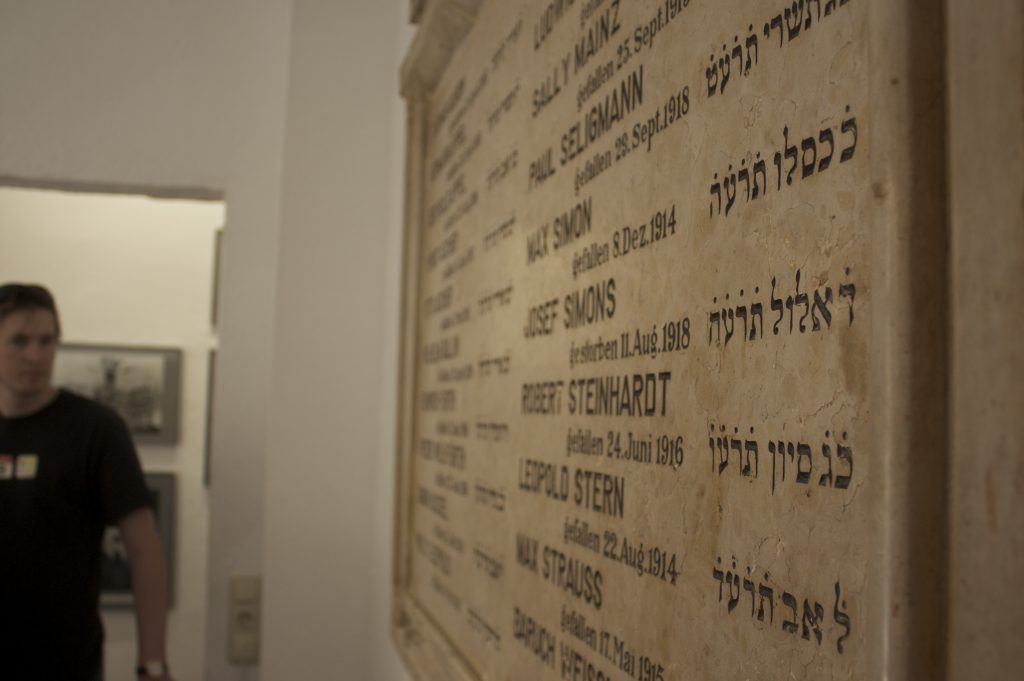
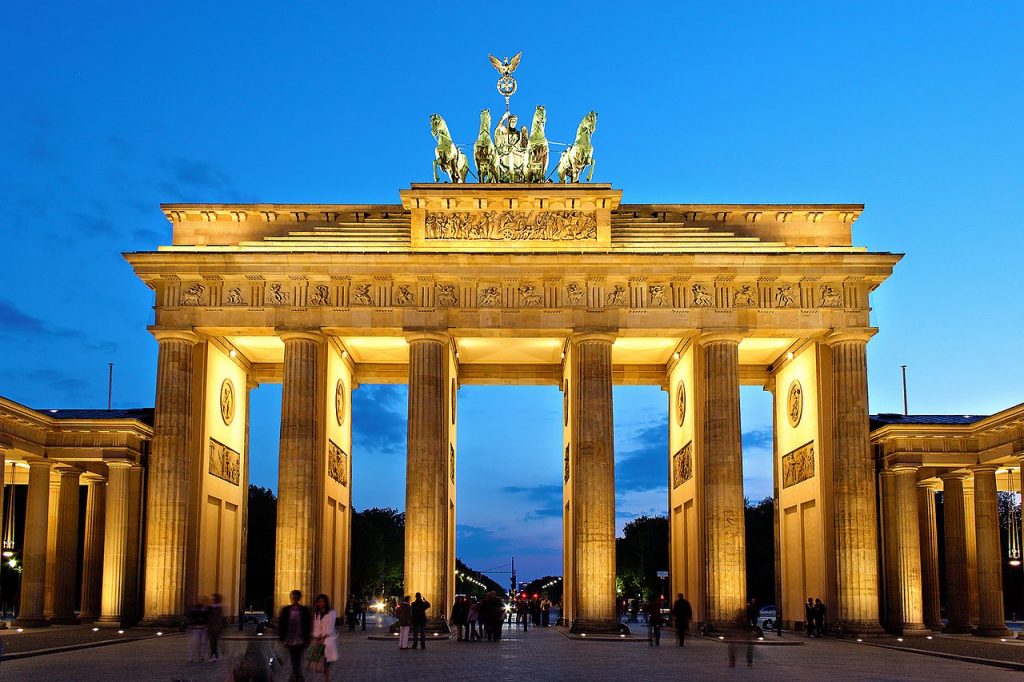
Once again the capital of a unified Germany, Berlin today has the largest Jewish community in the country (11 000 people). This is nonetheless far fewer than the some 170 000 Jews who lived here just before Hitler’s rise to power in 1933. One can well imagine that the ghosts of history will wander in Berlin for a long time to come, a city that, like Vienna, was a major economic, intellectual, and religious center for German Jews. Some monuments and cemeteries (notably the Weissensee, the largest Jewish cemetery in Europe) escaped Nazi destruction and the Allied bombings of 1945. The willingness of the new Germany to accept the totality of its heritage, including its most somber and shameful episodes, and to deliver its mea culpa for the horrors committed in the name of the German people, is the source of efforts to build or rebuild synagogues, community centers, schools, and memorials in all areas of the city today.
The duty of remembrance
The fall of the Berlin Wall in 1989 permitted the reconstruction of part of the old Jewish quarter of Orianienburgerstrasse. The Jewish Museum of Berlin , designed by architect Daniel Libeskind, was opened in 1999.
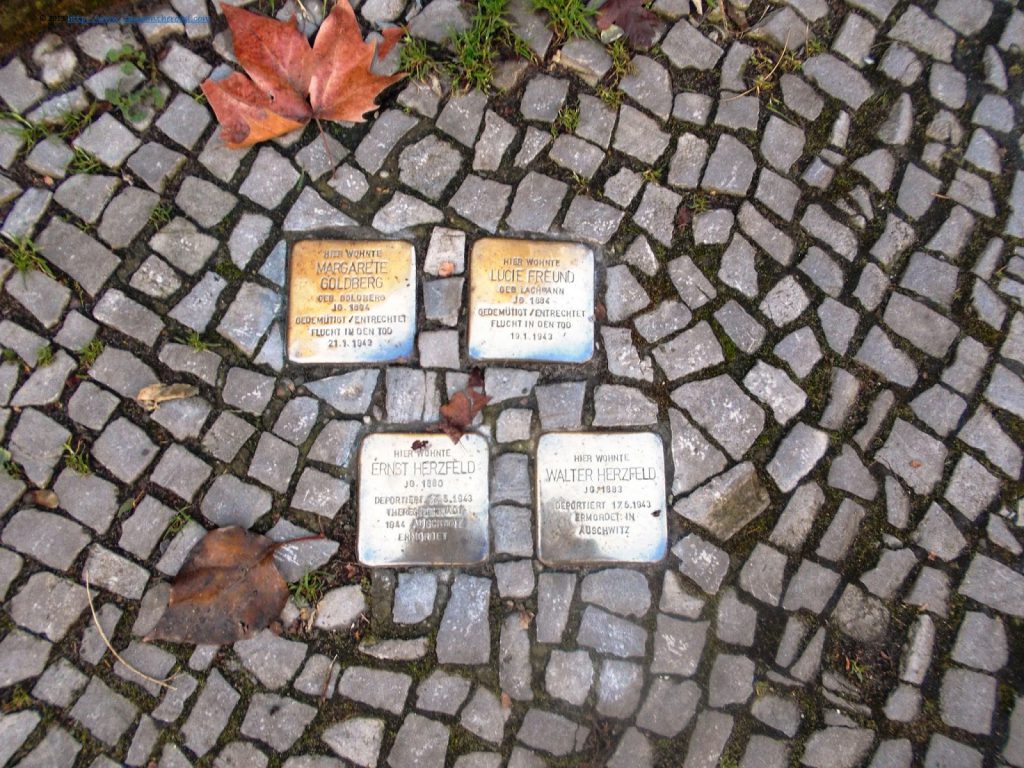
On a more modest scale, in the “Bavarian quarter” of Schöneberg, eighty panels have been applied to the lampposts that recall the successive steps the Nazis took in their persecution of the Jews. Mingled with these chilling historical facts are extracts of letters written by inhabitants of the neighborhood who were deported.
Throughout the city as a whole, commemorative plaques attest to a vanished Jewish lifestyle: in Steglitz, for example, the names of the 3186 Jews living in the area in 1933 are engraved on a mirrored panel measuring approximately 12.5 ft. wide x 40 ft. long.
After long debates, on 25 June 1999 the German Bundestag accepted a motion to erect a monument in memory of the Shoah near the Brandenburg Gate. The realization of this project was entrusted to the American architect Eisenman. It is composed of 2700 concrete pillars of varying heights and contain at its center information about the persecution of the Jews under Nazism.
In contrast to the contemporary initiatives to preserve the pre-World War II Jewish cultural heritage, the most ancient evidence of a Jewish presence in Berlin has been erased. Whether by the fires that ravaged the large village in its early days, the periodic attacks on the Jewish population, or finally the torments of the Second World War, the oldest traces of the Jews had been proven to date from 1295 (only sixty years after the founding of the city) have disappeared.

The Topography of Terror Foundation has been installed in the primary locations where the Nazi terror machine (the Gestapo, Reichsführung SS, Sicherheitsdienst) formerly had its headquarters. This institution, federally financed and supported by the State of Berlin, allows visitors to familiarize themselves in situ with how the Nazi state functioned. Awaiting its permanent home designed by the Swiss architect Peter Zumthor, the foundation organizes outdoor exhibitions and guided visits to the quarter.
The Anne Frank Center pursues the same educational aims as the Anne Frank House in Amsterdam, but with a vision oriented more toward adolescents, high school students, and college-age visitors. The Anne Frank Centre offers various travelling exhibitions that enable projects to be carried out in many German cities, helping them to share the history of the Holocaust in an educational way.
Central Berlin
Until 1989, the historic center of Berlin was situated in the former German Democratic Republic, (GDR) separated by a wall from the western part of the city since 1961. Central Berlin was the site of the palace of Frederick II (the Great) and Prussian political and economic activity. The first synagogue in Berlin was erected in this quarter in 1714 (on Heidereuterstrasse, today called Rosenstrasse). Although spared the ravages of Kristallnacht because it had been requisitioned by the German postal service, it was completely destroyed by the bombings of 1945.
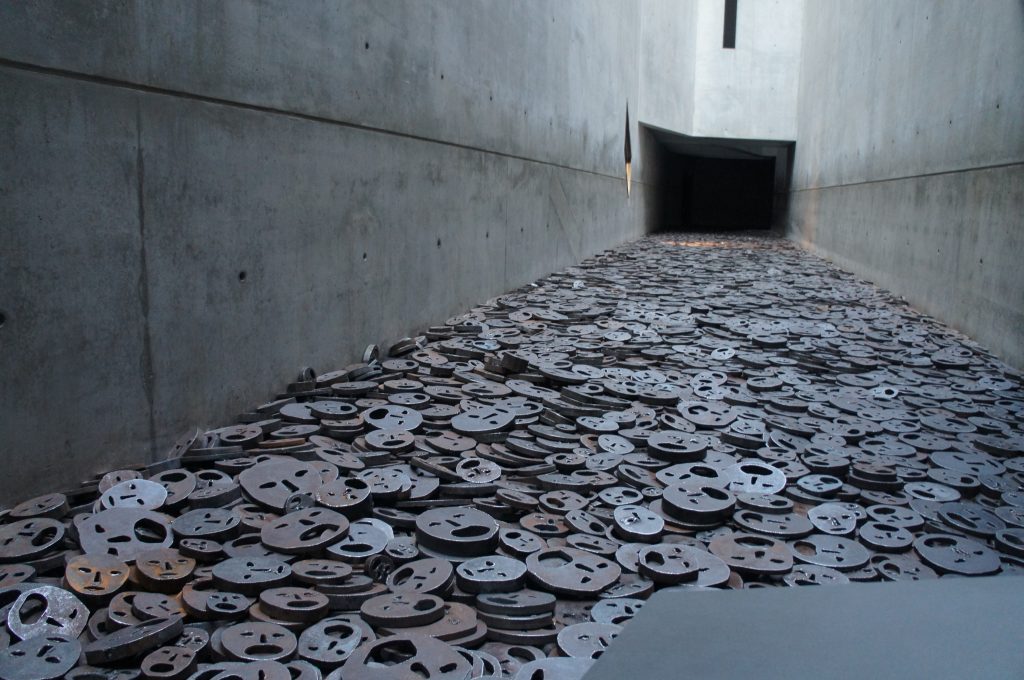
Orianienburgerstrasse was not properly a “Jewish quarter” since the number of Jews who lived here never grew grew beyond 10% of the Jewish population in the city overall.
During the Prussian Empire and the Weimar Republic, this centrally located Berlin street and neighboring arteries were a gathering point of Jewish immigrants from the east. These Jews, with their caftans, long beards, and earlocks, were thus more visible than their assimilated German counterparts. The restoration of this quarter, and notably the Grand Synagogue, is almost complete.
Opened in 1866, the Grand Synagogue was designed by the architect Edward Knoblauch in te Moorish style so fashionable at the time. With its 164 foot gild dome and its capacity to serve 1800 faithful, the Grand Synagogue gave the opulent Jewish population in Berlin a reason to be proud.

The synagogue escaped damage in the violence of Kristallnacht on 9 November 1938 thanks to the courageous action of a brigadier police officer, William Krütfeld, who, with several other men, managed to make the hordes of SA withdraw by pretending that the synagogue had been placed under police protection due to the riches it contained. Closed by the Nazis in 1940, the synagogue was transformed into a warehouse. It was seriously damaged by a bombing in 1943.
In a effort to change its image in the eyes of Israeli Jews, the GDR began the renovation of the synagogue and construction of a Jewish community center nearby in the late 1980s. While not all of them are kosher, the cafés and restaurants surrounding the synagogue offer drinks and traditional dishes typical of the Eastern European Jewish kitchen mingled with highlights from Israeli cuisine. At the Jewish Gallery , paintings are displayed by Jewish artists hailing mostly from the former Soviet Union, as well as religious objects, both old and new.
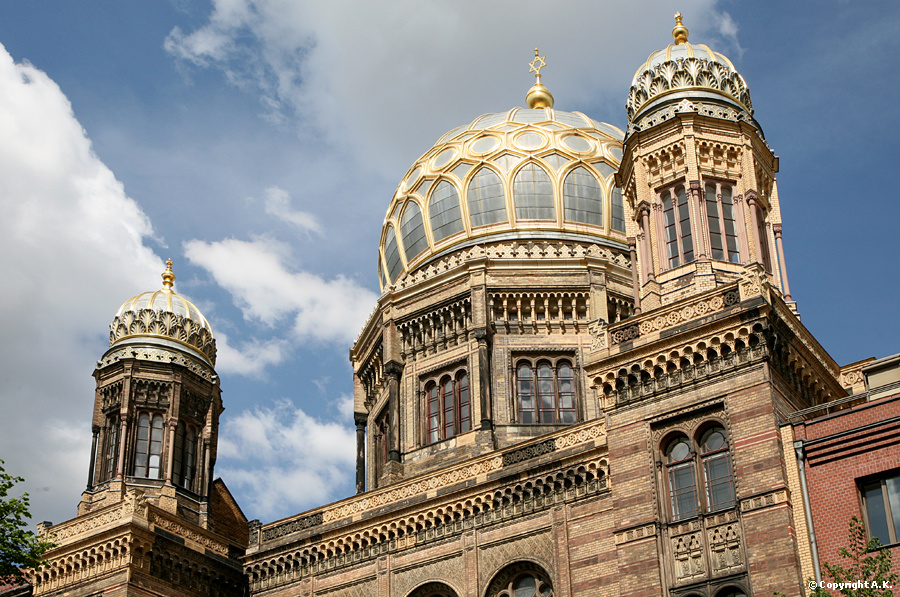
Completed in 1765, the Ephraim Palace belonged to financier Veitel Heine Ephraim (1703-75), the banker of Frederick the Great. Demolished during the major urban renewal efforts of 1935, the rococo facade was nevertheless saved and later protected from the bombings. In 1987, the facade was reassembled during the renovations of central Berlin undertaken by the GDR. The palace today houses an annex of the Museum of Fine Arts that contains, most notably, a collection of ancient coins.
Charlottenburg-Wilmersdorf
Charlottenburg-Wilmersdorf is the heart of the former West Berlin, whose principal thoroughfare is the Kurfürstendamm. The administrative center for the Jewish community in Berlin is located here with its social and cultural institutions.
Klezmer in Berlin
In East Berlin, before the fall of the Wall, a few young musicians began, in a provocative effort, to play klezmer music, a mixture of Jewish music from Central Europe and American jazz originating from the encounter between these two musical styles in the Jewish neighborhoods in New York. This music, underground during the Communist era, has become very popular in Berlin. The Theater in den Hackeschen Höfen offer klezmer concerts almost every Monday evening and Saturday evening.

The synagogue on the Pestalozzistrasse was built in 1912 at the initiative of Betty Sophie Jacobson, a wealthy businesswoman in the neighborhood. On the night of 9 November 1938, the synagogue was set afire and might have burned to the ground, had firemen not quickly extinguished the flames fearing that they would spread to nearby buildings. The interior of the synagogue thus suffered only minor damages and could be reopened as early as 1946. The services there are celebrated according to the liberal liturgy with a mixed choir and organ musicis a former meeting hall of the B’nai Brith. Now Orthodox services are celebrated here.
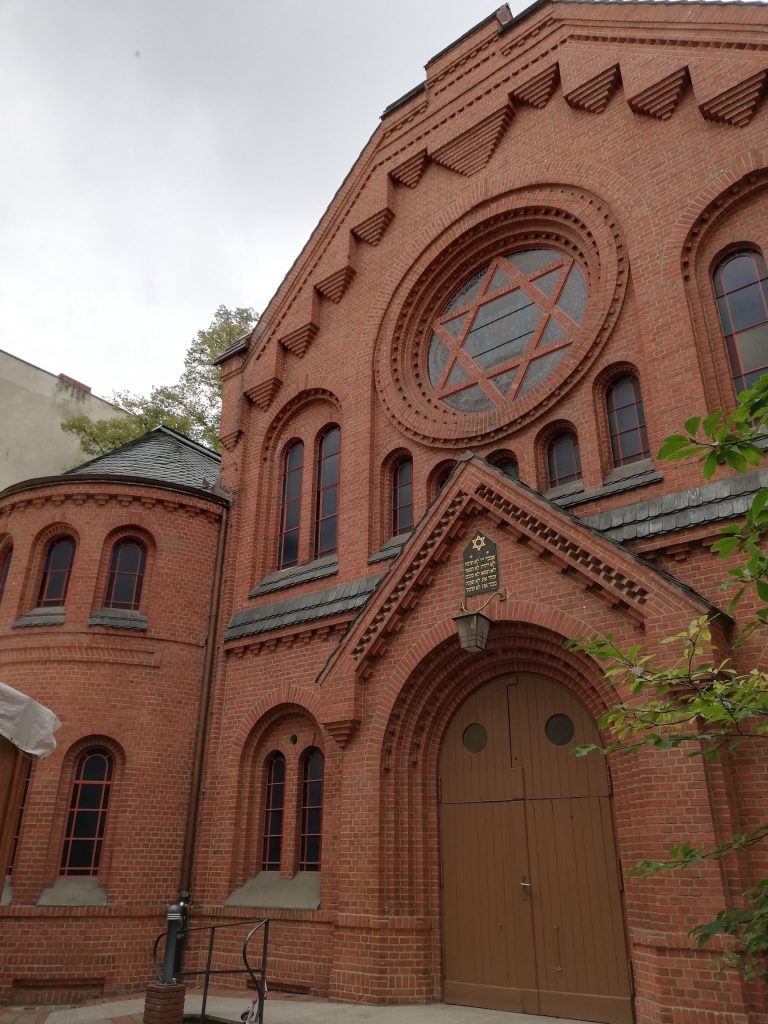
The Jewish Museum Berlin contains a permanent exhibition on the history of Berlin’s Jews and houses the collection of objects, religious and secular, that were contained in the former Jewish Museum, a private institution in existence until 1938. This museum is remarkable above all for its metaphorical architecture, designed by Daniel Libeskind. The metal facades, torn in shreds, powerfully evoke the abuse and victimization the museum has suffered.
The cemetery on Schönhauserallee , established in 1827, contains the graves of the personalities who animated the cultural and economic life of Berlin at the end of the nineteenth and beginning of the twentieth centuries, personalities such as the bankers Gerson von Bleichröder and Joseph Mendelssohn, the musician Giacomo Meyerbeer, and the painter Max Liebermann.
With its ninety-nine acres of land, Weissensee if one of the largest Jewish cemeteries in Europe. Established in 1880 and devastated during the Second World War, it was renovated little by little by the authorities of the GDR and the reunification accelerated this rehabilitation. One finds here the graves of eminent Jewish personalities from prewar Berlin: the philosopher Hermann Cohen, the theologian Leo Baeck, the editor Samuel Fischer, and the heads of the press Theodor Wolff and Rudolf Mosse.

The Literaturhandlung is the most important Jewish bookstore in the whole of the German-speaking community (with satellite stores in Munich and Vienna). You can find items for religious worship here (mezuzot, candelabra, prayer shawls, etc.), as well as greeting cards for the Jewish holidays. Also interesting to visit, the Omanut gallery .
Cafés and restaurants certainly are not lacking in this area. Salomon’s Bagels is a minuscule shop devoted to bagels, or according to the owner of the place, Andreas Pfeffer, “edible wisdom”.
In 2025, the Jewish community of Berlin has more than 10 000 members, making it the largest in the country. As a sign of the rebirth and development of Berlin’s Judaism, a synagogue is being rebuilt on the site where it was destroyed during the Holocaust, in the Kreuzberg district. It should be inaugurated in 2026 by Beate Hammett, the daughter of Alexander Beer, the architect responsible for building the original synagogue.
On 11 November 2025, the Neue Synagoge Berlin – Centrum Judaicum foundation celebrated the 30th anniversary of the opening of the Centrum Judaicum in the partially rebuilt New Synagogue on Oranienburger Straße. Around 200 guests from the worlds of politics, culture, science and society attended the anniversary ceremony on 11 November 2025. The ceremony paid tribute to the history of the building and to the people who have shaped its development over the past three decades. As in many other cities with large Jewish communities, Berlin has seen a sharp increase in anti-Semitic acts since the pogrom of 7 October.
Liege is a city known, like Ghent, for its large university population, but also for its cathedral, its waffles, and its film makers, the Dardenne brothers. The Jewish presence in Liege seems to date back to the Middle Ages. Documents from the 11th century attest to a local religious conflict between a bishop and a Jewish doctor. The case of a priest healed by a Jewish doctor is mentioned in 1138. But in the following centuries, the main mentions of Jewish presence are linked to local conversions to Christianity.
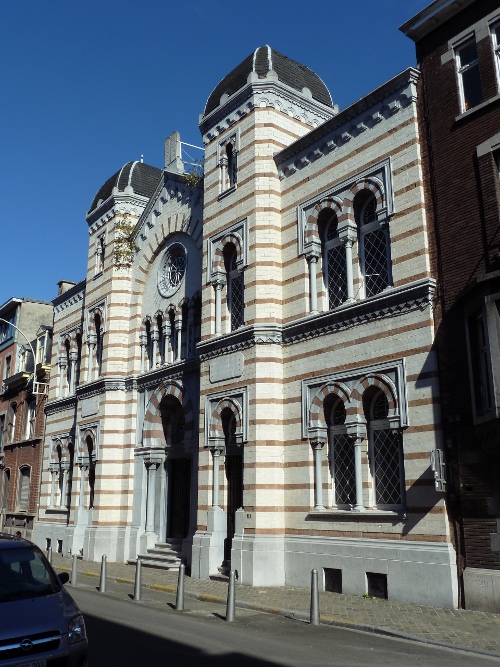
It was not until the French presence in the 18th century that the Jewish population settled there permanently. Thus, 24 Jews were counted in 1811, then about twenty Jewish families at the end of that century, mainly from the Netherlands, Dutch Limburg, Germany and Alsace-Lorraine. The oldest grave in the Jewish cemetery dates from this period. The formal recognition of the Jewish community in Liege did not take place until 1876.
A new Synagogue of Liège , marking this recognition and demographic evolution, was designed in a mixture of styles by the architect Joseph Rémont and inaugurated in 1899. Located near the Palais des Congrès, it is now listed as a historical monument by the Walloon Region.
The Jewish population of Liège increased at the beginning of the 20th century following the arrival of migrants from Eastern Europe working in the very prosperous industrial area of the time. But also Belgian and French students attracted by the quality of its University and the pleasant life in Liège. In 1914 the community, comprising Dutch and Alsatian Jews, was swollen by Russian Jews who had been taking prisoners by the Germans. Some of them settled in Liège from 1917. The international reputation of the École des Mines drew Jews from eastern Europe between the two world wars.
On the eve of the Shoah, there were nearly 3,000 Jews in Liège. About a third were murdered. At the Liberation, there were only 1200 Jews left in the city. Monuments in the synagogue commemorate the victims of the Shoah and also pay tribute to the Resistance fighters.
This number declined over time, reaching 594 in 1959. The community grew to 1,500 in 1968, but declined again to 1,000 in the early 1980s. Since then, the synagogue has also been used as a cultural meeting place.
Due to the unhealthy and dilapidated condition of the buildings next to the Jewish Cultural home and a construction project, it has been temporarily closed since 2022.
Small communities also existed in the surrounding towns of Seraing and Spa. The first one because of the workers of the industrial basin who settled there at the beginning of the 20th century and the second one because of the bathing stays of this city known for its water.
Sources : Musée juif de Belgique, Consistoire, Encyclopaedia Judaica, Politique et Religion : le Consistoire Central de Belgique au XIXe siècle
Michel Kichka devoted an album to his childhood in Liège and those memories difficult to share by his father, Henri Kichka, about the Holocaust. In his later years, Henri became an active participant in sharing his experience with high school students in Belgium.
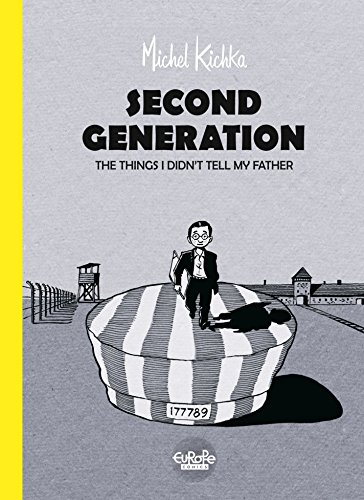
Jguideeurope: You have shared your family’s history in the comic book Second generation. With its moments of happiness and its dark moments too, linked to the war. What motivated the wish of your family to settle in Seraing, in the outskirts of Liège?
Michel Kichka: My maternal grandfather settled there before the war. He opened a clothing store, convinced that there were some good opportunities in the economic heart of the region of Wallonia. His family was able to find a haven in Switzerland when Belgium was occupied. After the war, he came back to Seraing, after a detour via Brussels. My father and my mother managed a clothing store in Seraing, from 1952 or 53 until 1986.
What were the important places which, for your parents, then for you, evoked Jewish culture in the city of Liège and its region?
The Jewish Home of Liège (today we would use the term “Community Center”) where the community would meet for celebrations, was an important place. The synagogue of Liège also, actually there was only one. There, we would celebrate holidays, weddings and mixed bar and bat mitsvahs. The youth would regularly meet at the Ken (room) of the Hashomer Hatzaïr, located on the floors of the Jewish Cultural home.
The community was very homogenous, a big majority of Ashkenazim. Most of the fashion stores, selling men and women’s clothes, were kept by Jewish families in the heart of the city which, during my younger days, carried well its name: the “fiery city”!
What is left today of this heritage?
One of my childhood friends, Thierry Rozenblum, published a book about that subject entitled Une cité si ardente : les Juifs de Liège sous l’Occupation (published by Luc Pire, 2010). He’s working now on a second book. Over time, the majority of the families resettled in Brussels.
Michel Kichka, Second generation: the things I didn’t tell my father. Published by Europe Comics, 2016.
Charleroi is a city known for having been a very important coal basin, but also as an industrial centre. Since the decline of these industries, the city has invested heavily in cultural development and is particularly appreciated as a historical centre of comics, with the Marcinellois printer Jean Dupuis creating the magazine Spirou in 1938.
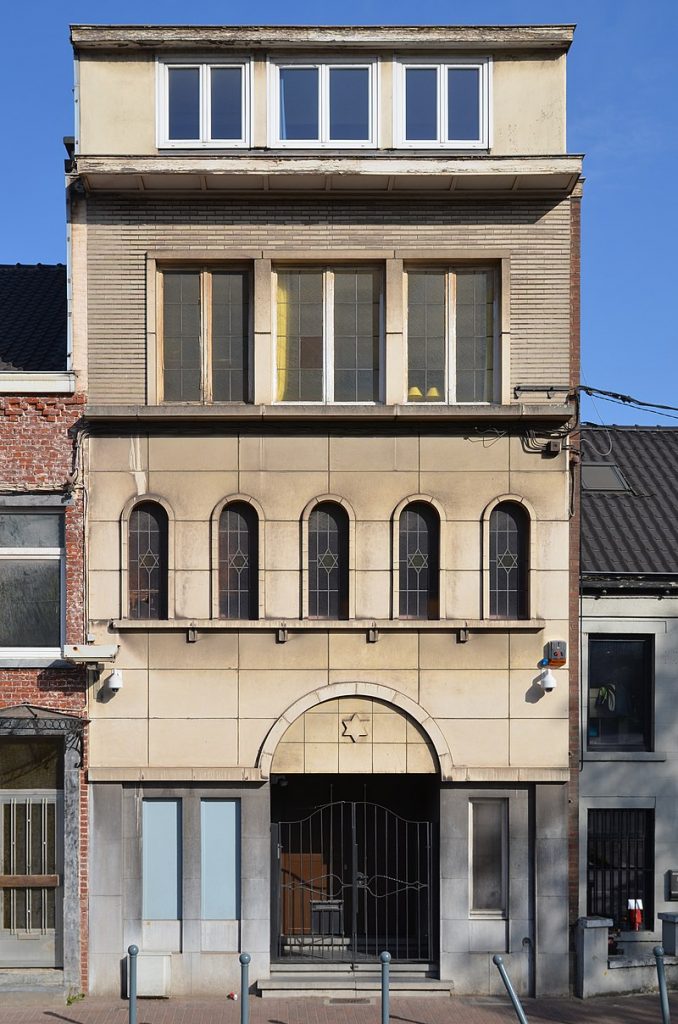
The Jewish presence in the city is relatively recent, with a community being formed after the First World War. Most of the Jews came from Eastern Europe to work in the region’s coal mines, as did other arrivals from that region or from Italy at the time.
The next generation of Jews integrated into the town and diversified their trades, especially in the crafts, reaching a number of 600 families by the end of the 1930s. A synagogue and socio-cultural places were opened at this time. The Shoah decimated a large part of the Carolingian Jews.
After the Second World War, a small community was reconstituted, which inaugurated a synagogue in 1963, located in Rue Pige-au-Croly. The building also served as a community centre. Later, the building became home to a Museum of the Memory of the Righteous. The museum organises visits for school groups in order to fight against hatred and forgetting.
A Jewish cemetery plot is located in the Marcinelle cemetery , where there are also two monuments to the victims of the Shoah.
In November 2023, as part of an upsurge in anti-Semitic acts, eighty-nine graves in the Jewish section of the Marcinelle cemetery were defaced. Numerous Stars of David were torn from the graves and thrown into a corner of the cemetery.
Sources : Consistoire de Belgique